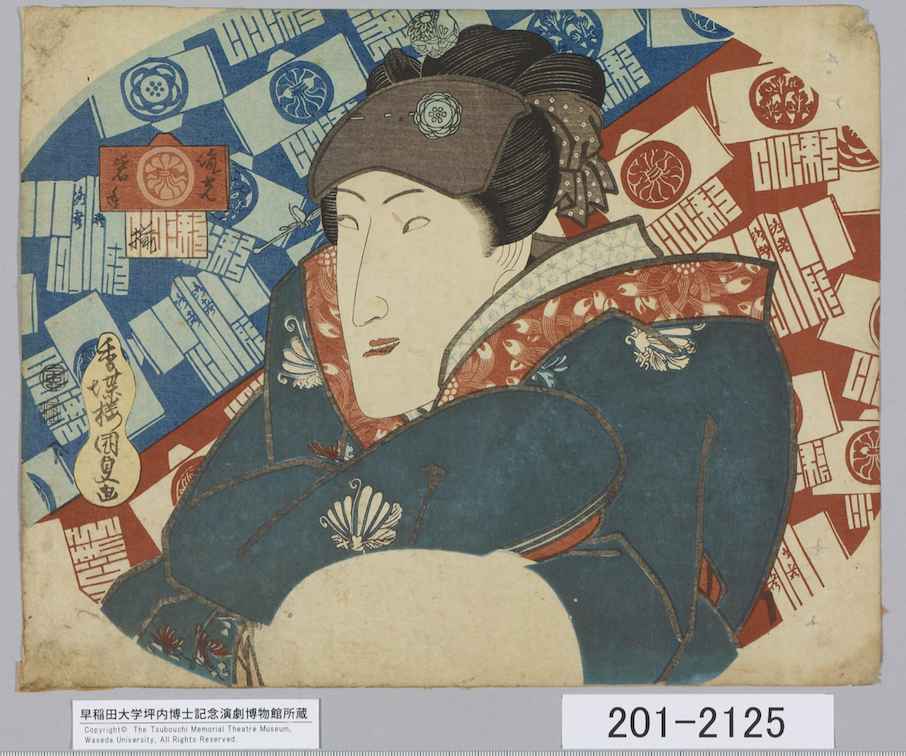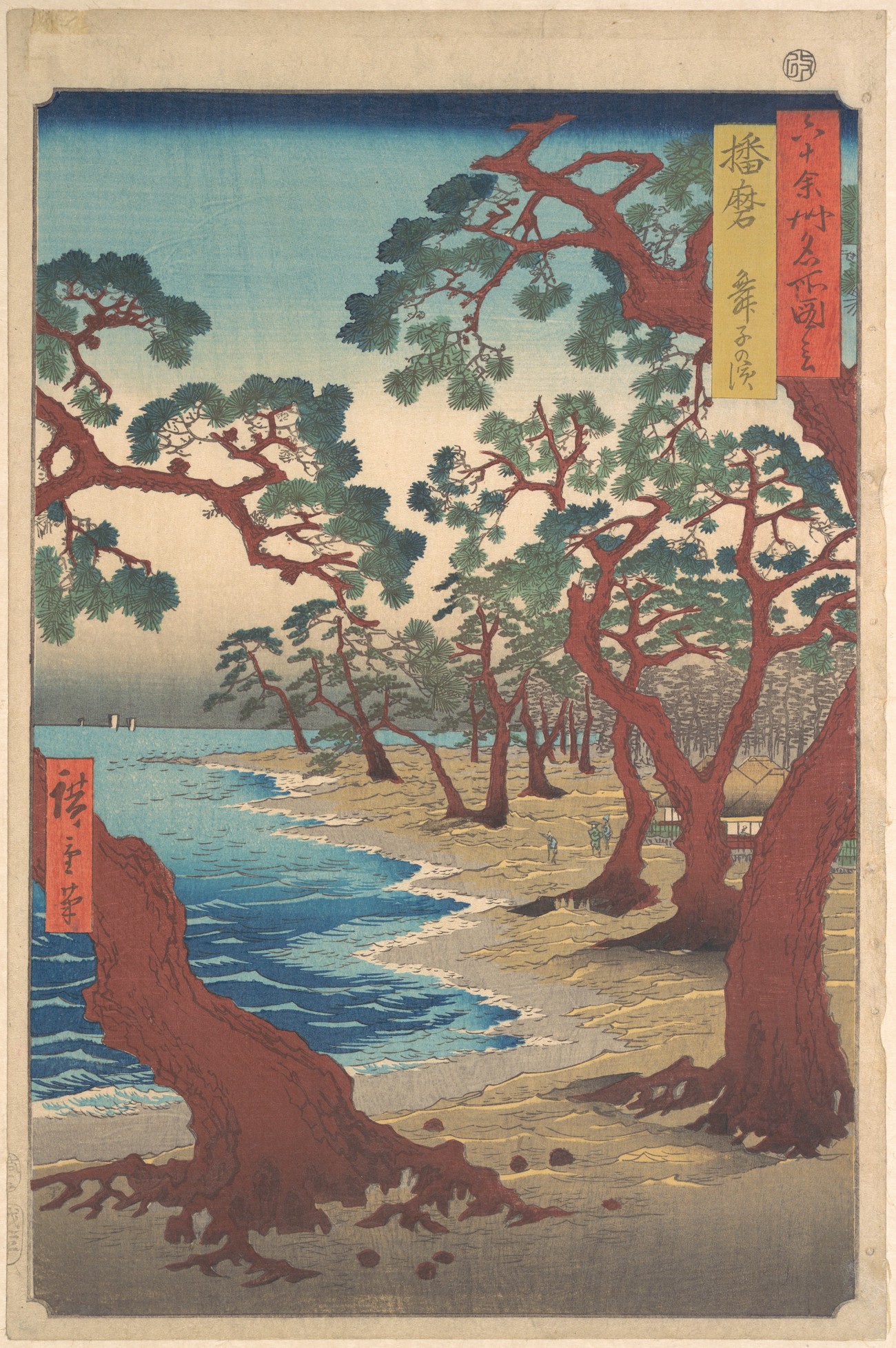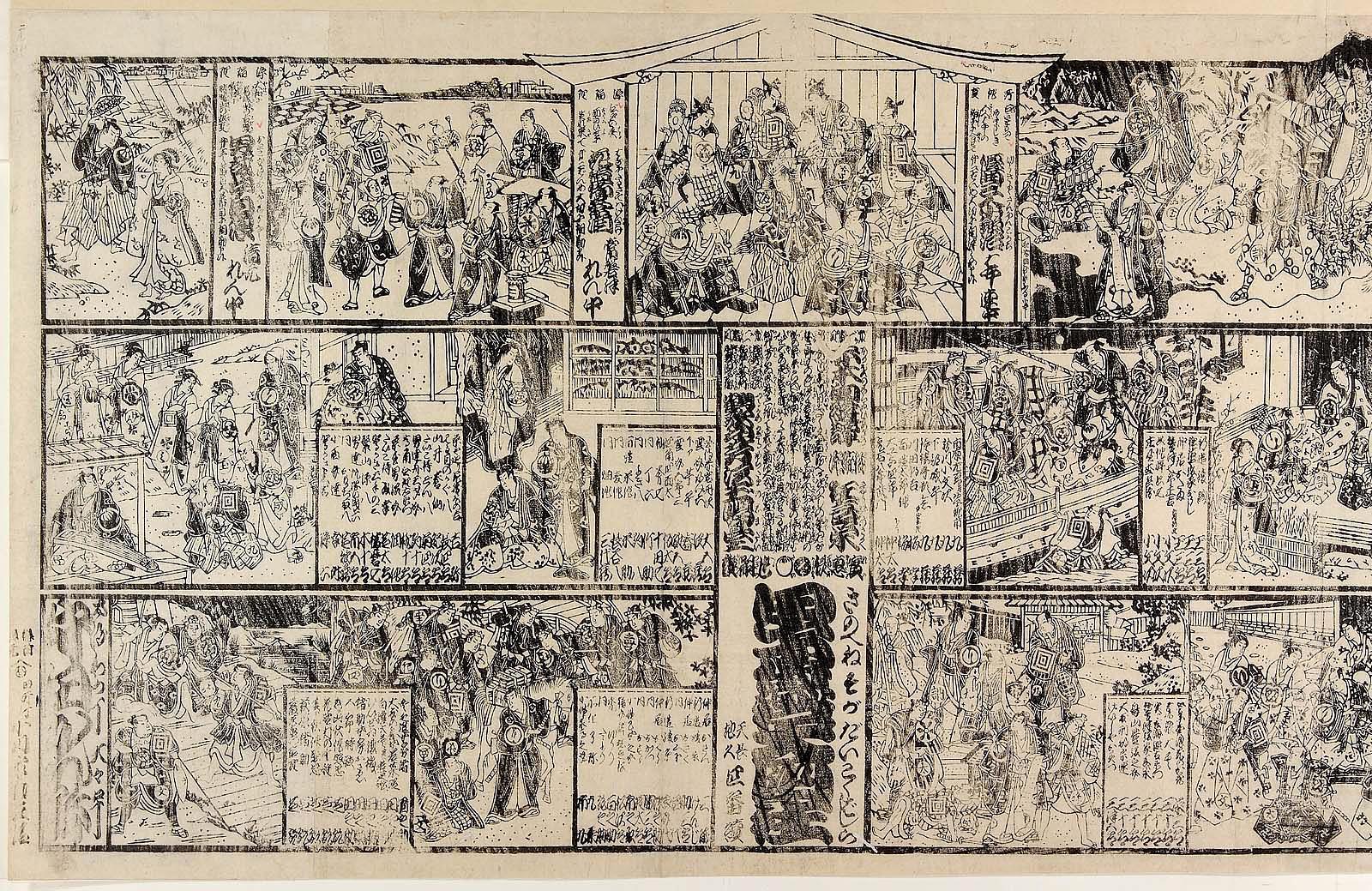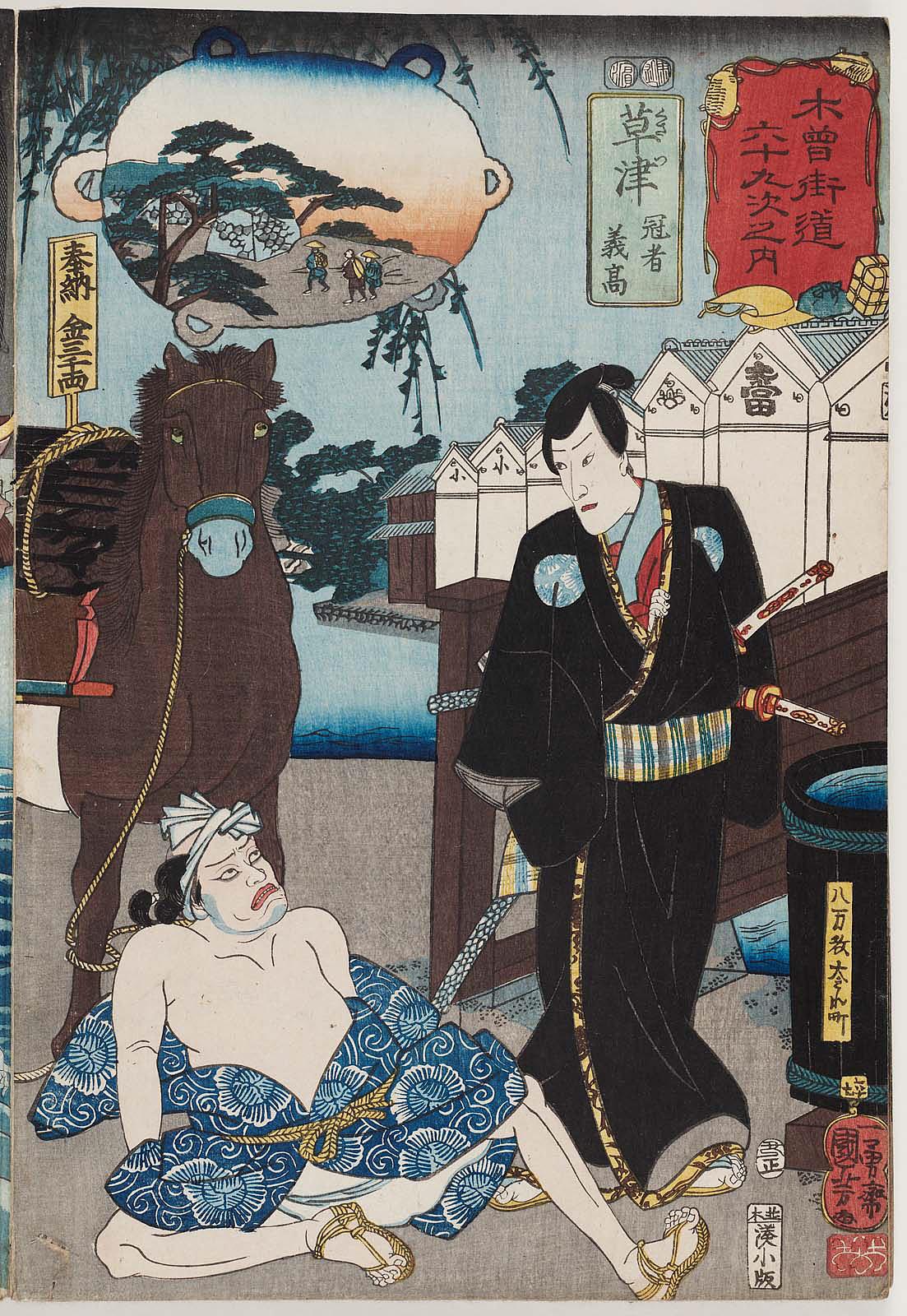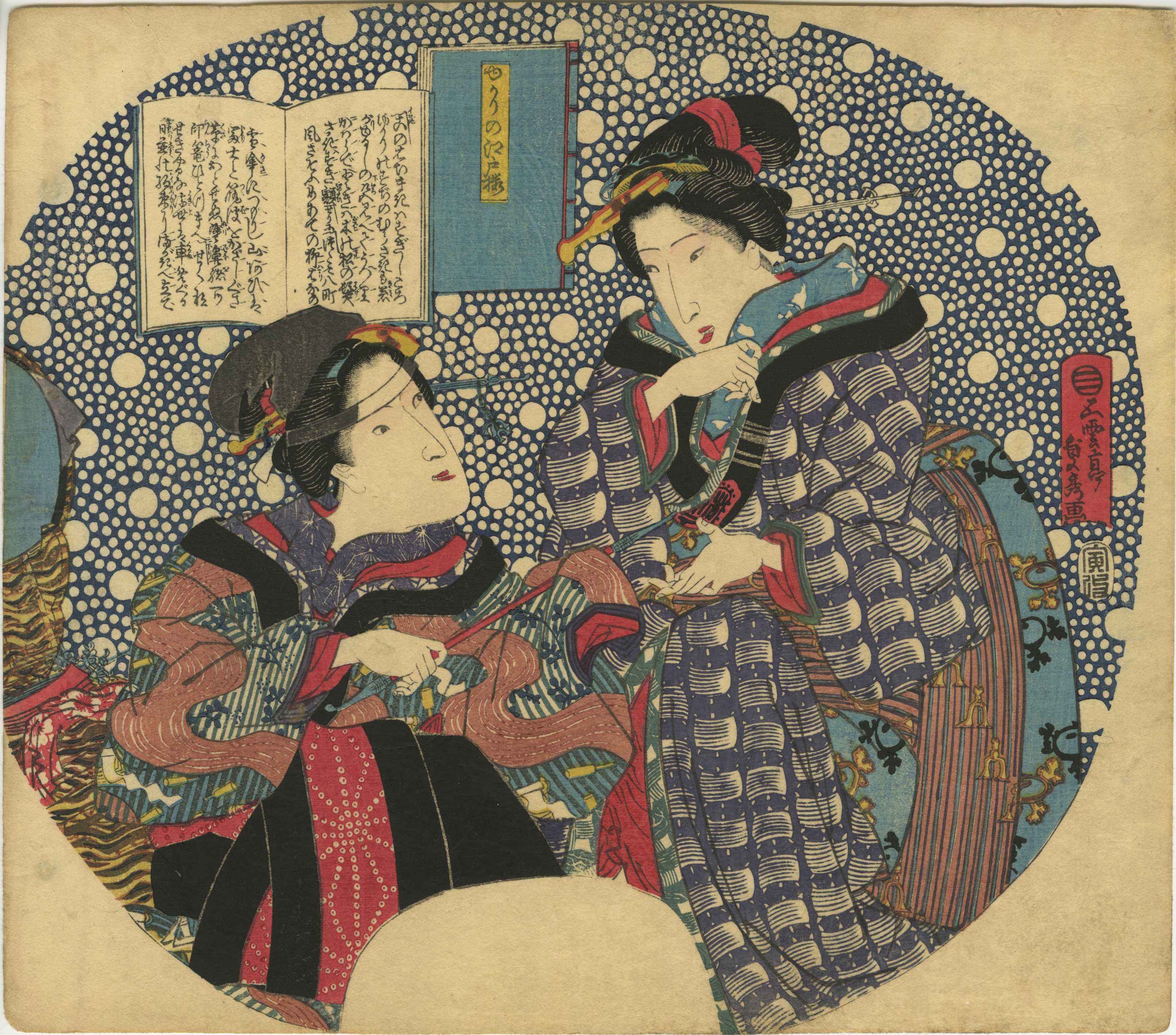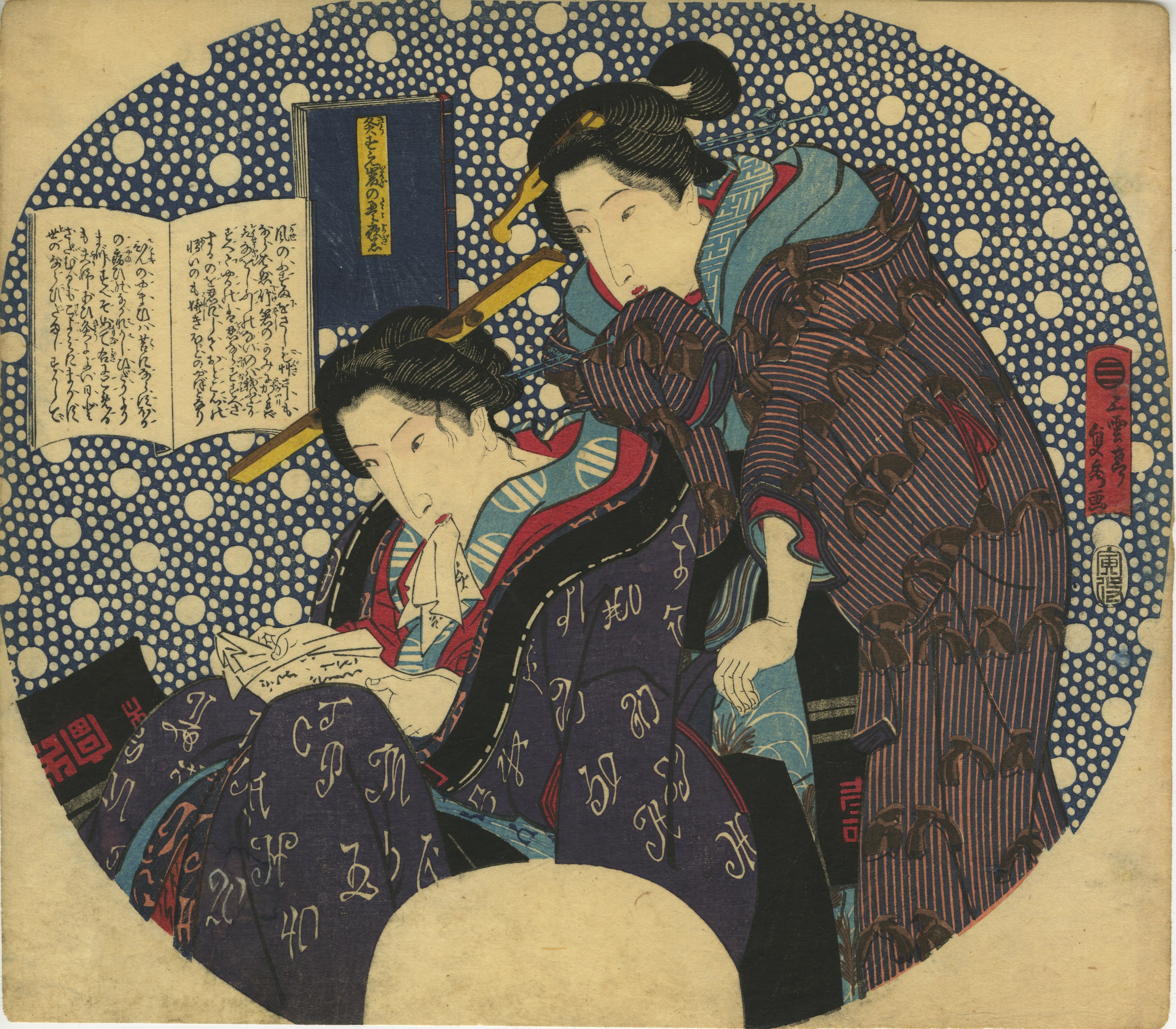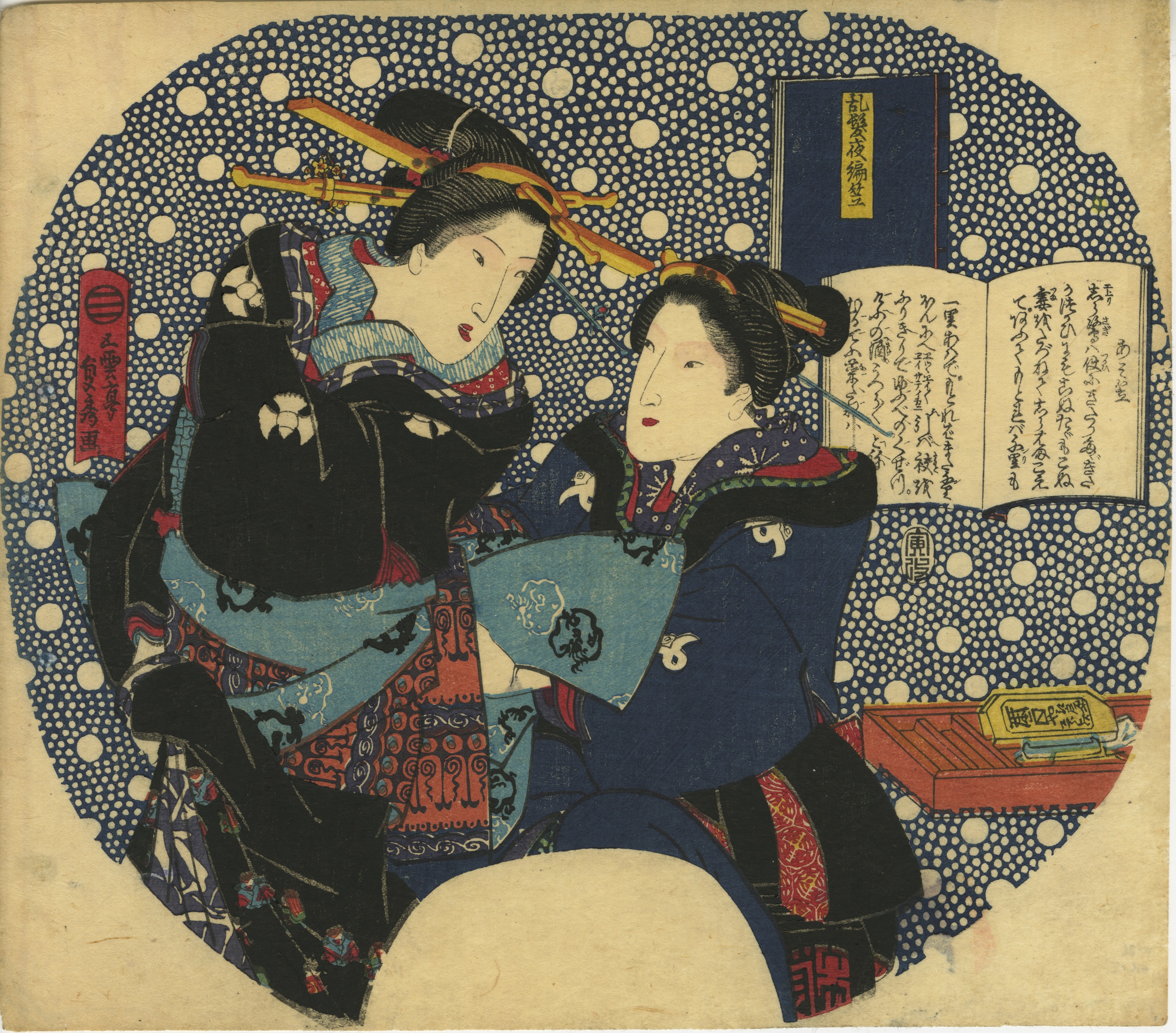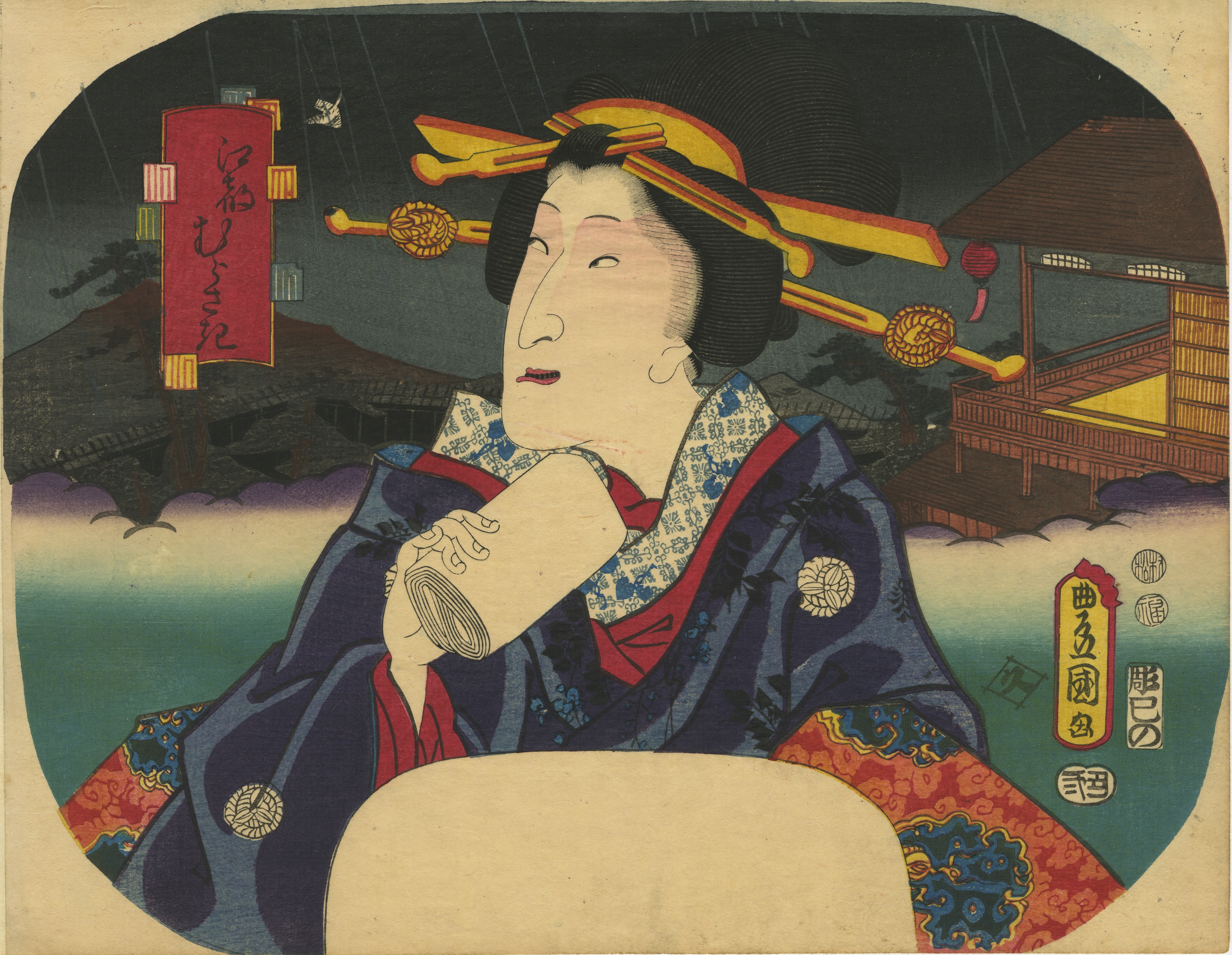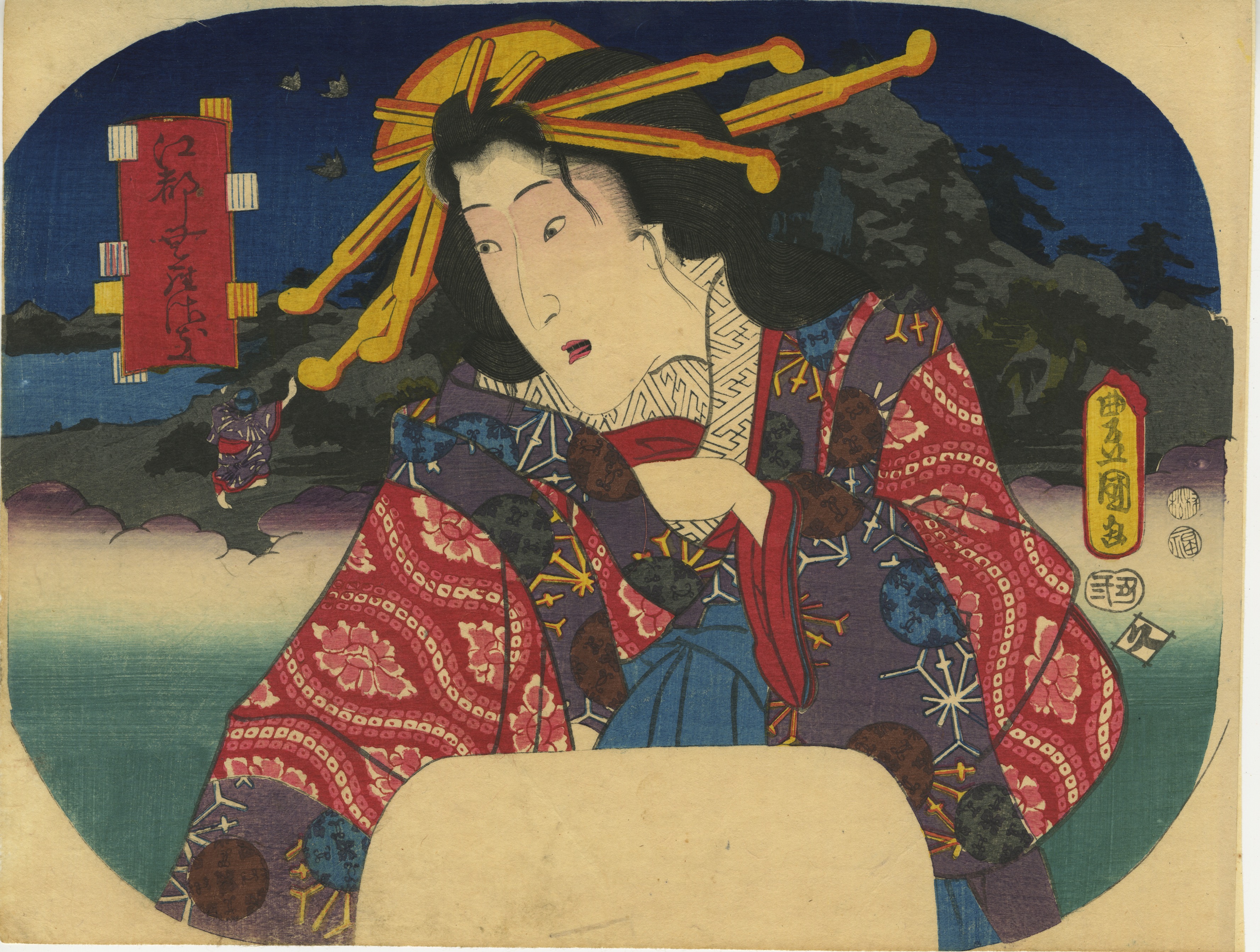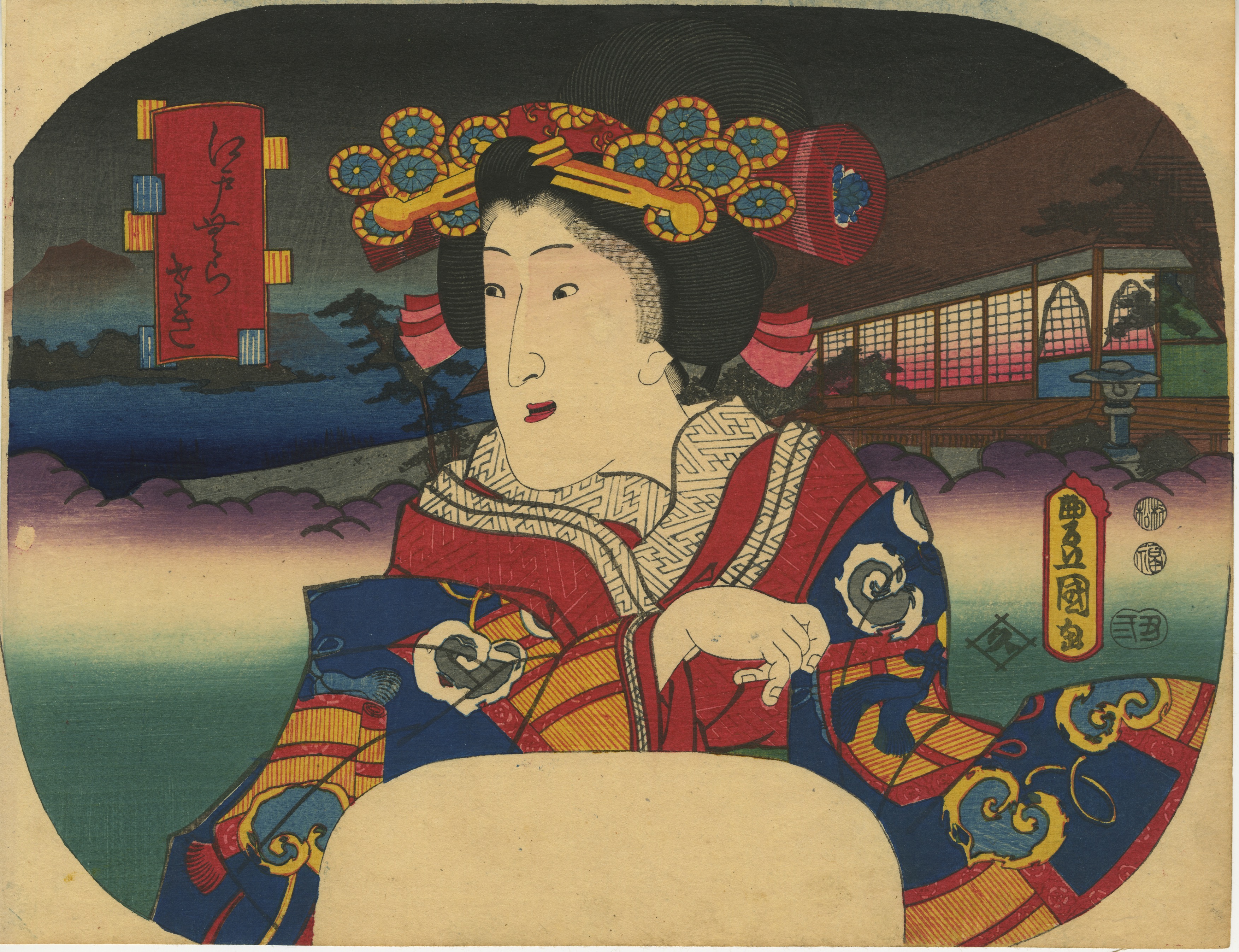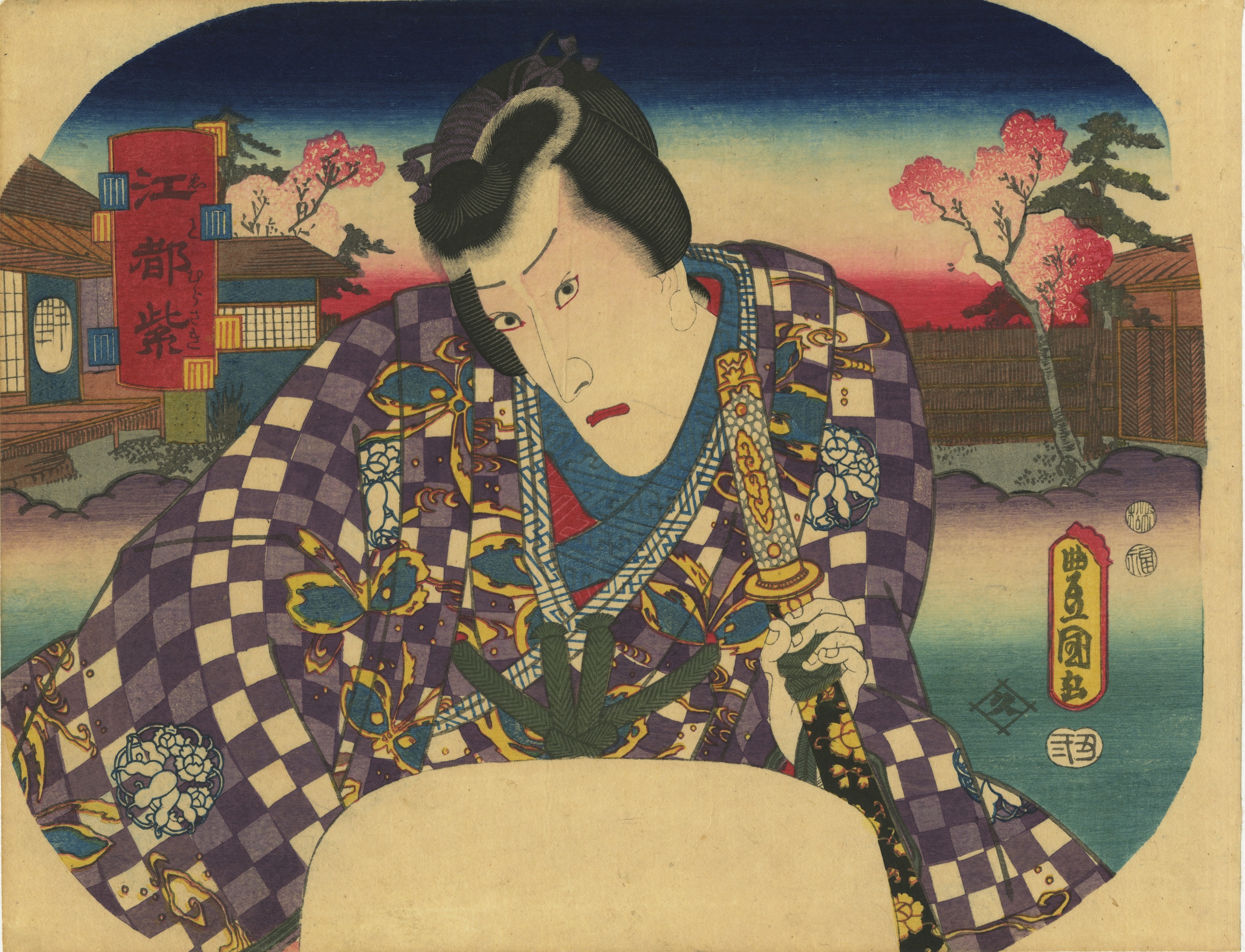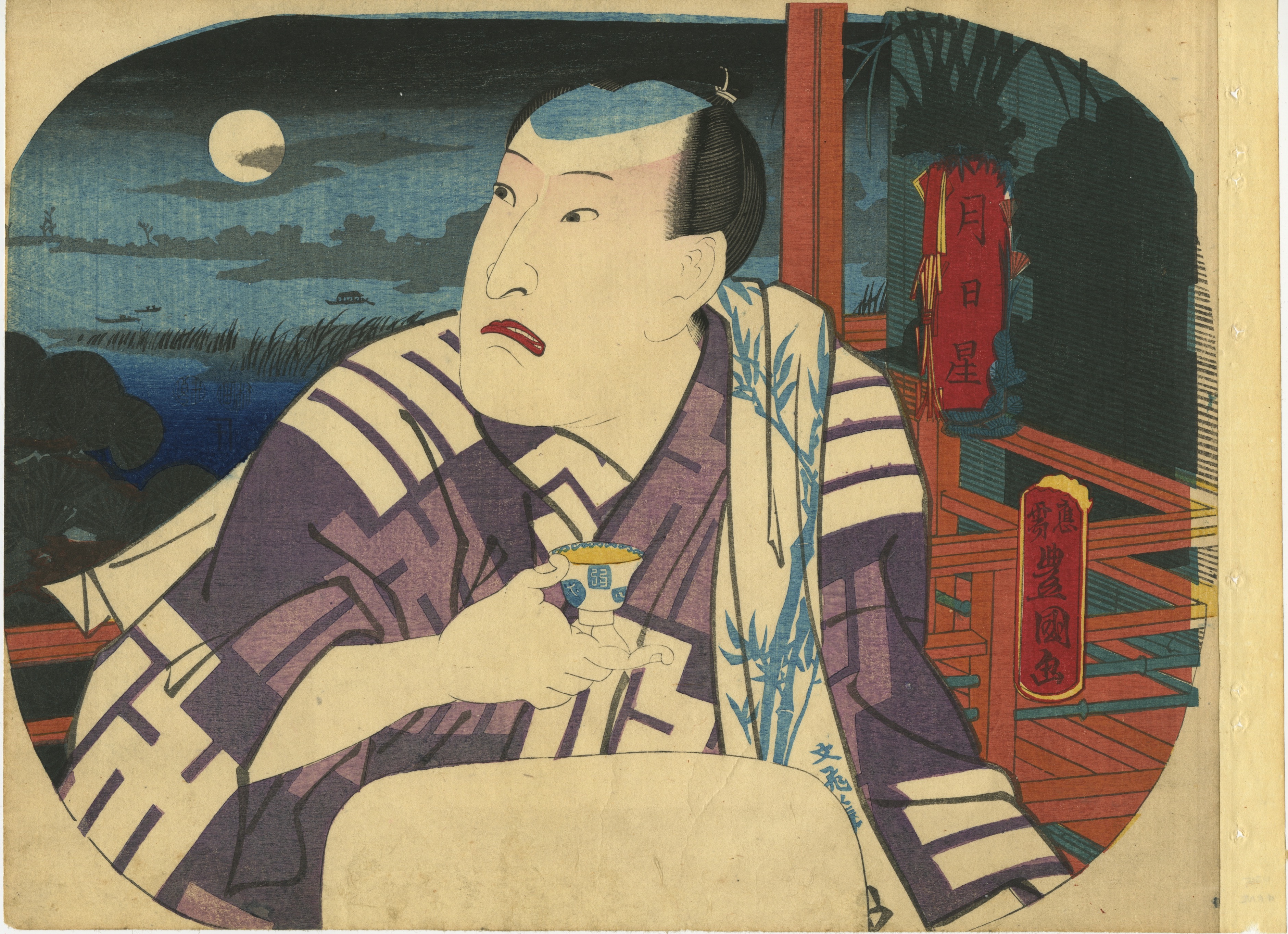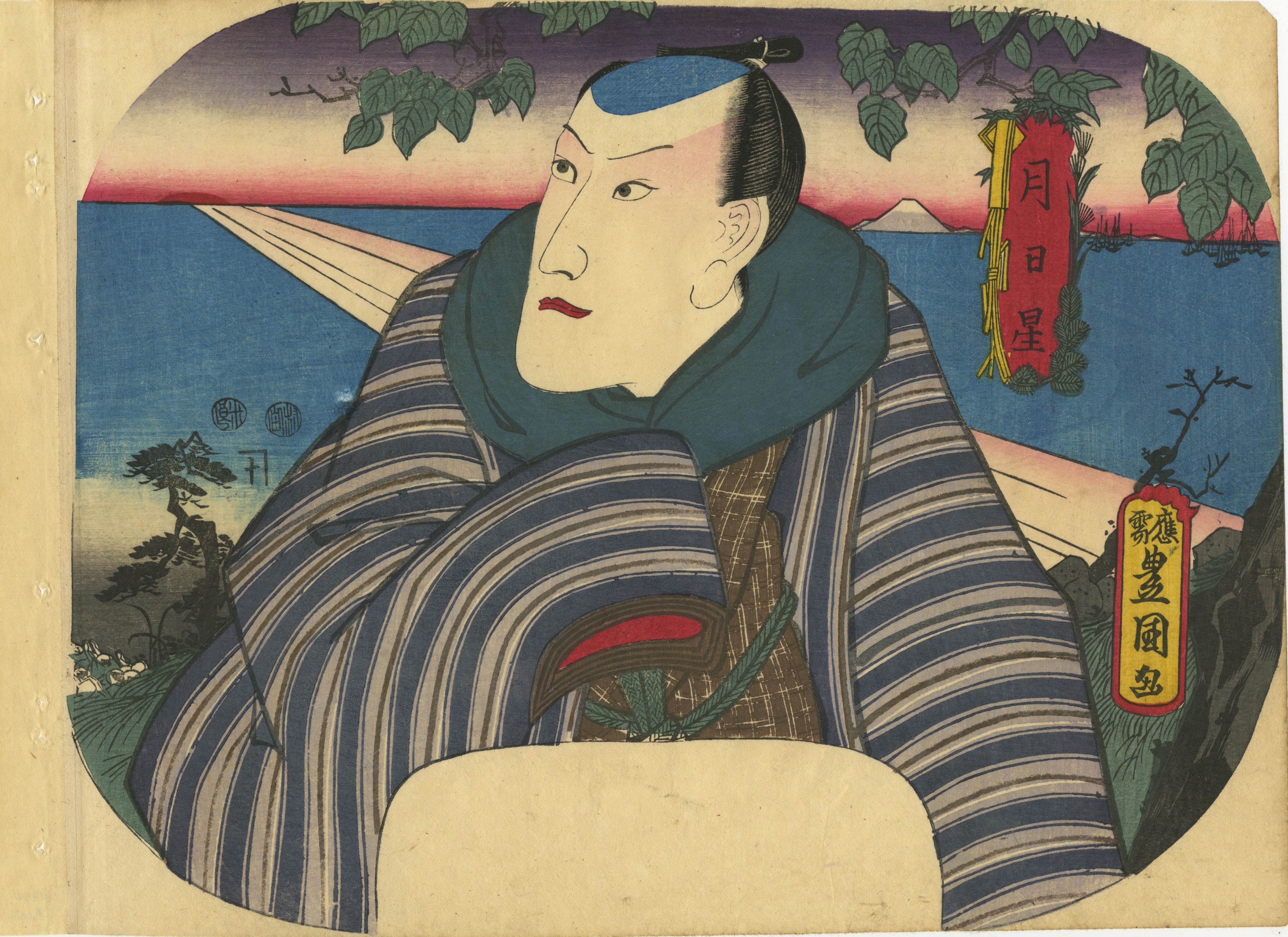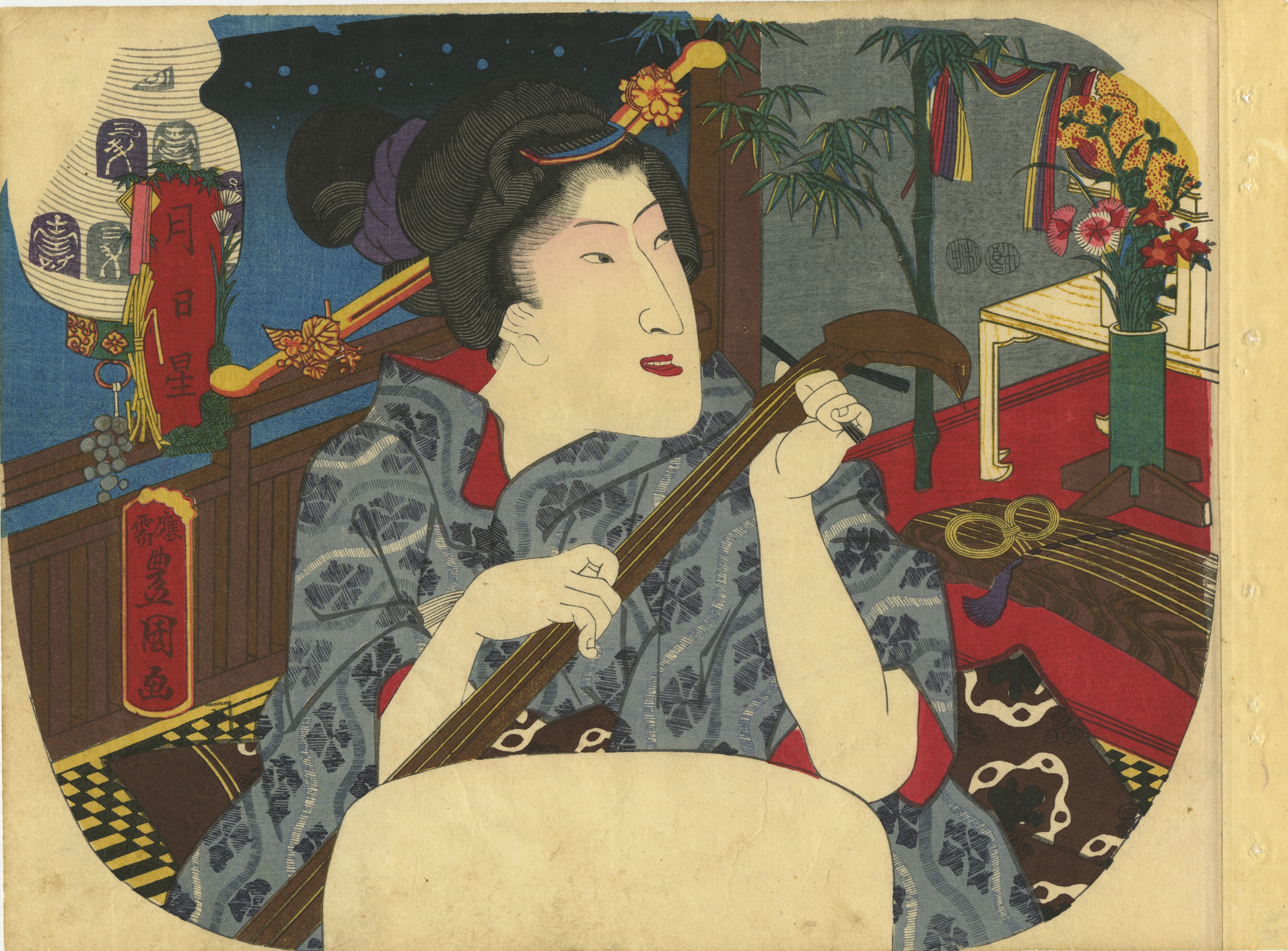-
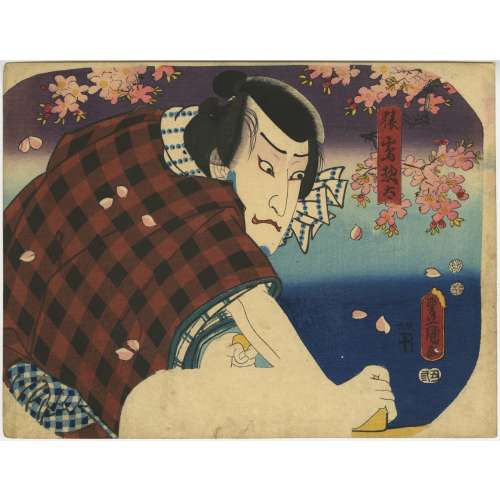 Kabuki actor Arashi Kichisaburō III [嵐吉三郎] as Sarushima Sōta [猿島惣太] in the play Hanamo Yoshida Iwao no Matsuwaka [花吉田岩尾松若] staged at Ichimura-za (市村座), theatre in Edo. Artist: Utagawa Kunisada, a.k.a. Toyokuni III (Japanese, 1786 – 1865) [歌川 国貞]. Publisher: Kojimaya Jūbei (Japanese, 1797-1869), seal: Hanmoto, Jū [板元, 十] (Marks 19-043 | 264c. Date seal and double nanushi censor seals Mera & Watanabe – 3rd month of Kaei 6 (1853). Signed: Toyokuni ga [豊国 画] in a red toshidama cartouche. Media: Fan print (uchiwa-e), 223 x 294 mm. Kabuki actor Arashi Kichisaburō III [嵐吉三郎] (Japanese, 1810 – 1864); other names: Arashi Daizaburō III, Arashi Kitsusaburō III Ref.: Art shop Ezoshi Ukiyoe new collection news, vol. 66, 2023.1 (Jan) # 30, p.8.
Kabuki actor Arashi Kichisaburō III [嵐吉三郎] as Sarushima Sōta [猿島惣太] in the play Hanamo Yoshida Iwao no Matsuwaka [花吉田岩尾松若] staged at Ichimura-za (市村座), theatre in Edo. Artist: Utagawa Kunisada, a.k.a. Toyokuni III (Japanese, 1786 – 1865) [歌川 国貞]. Publisher: Kojimaya Jūbei (Japanese, 1797-1869), seal: Hanmoto, Jū [板元, 十] (Marks 19-043 | 264c. Date seal and double nanushi censor seals Mera & Watanabe – 3rd month of Kaei 6 (1853). Signed: Toyokuni ga [豊国 画] in a red toshidama cartouche. Media: Fan print (uchiwa-e), 223 x 294 mm. Kabuki actor Arashi Kichisaburō III [嵐吉三郎] (Japanese, 1810 – 1864); other names: Arashi Daizaburō III, Arashi Kitsusaburō III Ref.: Art shop Ezoshi Ukiyoe new collection news, vol. 66, 2023.1 (Jan) # 30, p.8. -
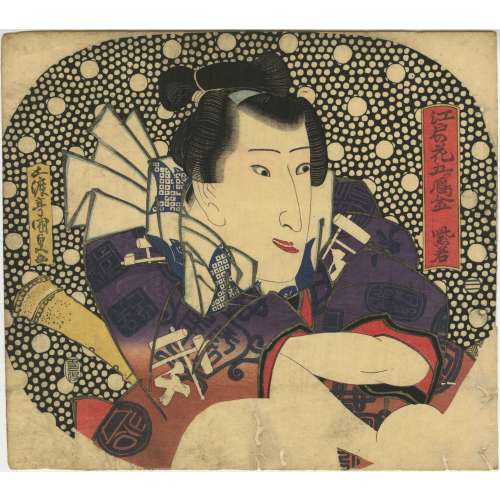 Artist: Utagawa Kunisada, a.k.a. Toyokuni III (Japanese, 1786 – 1865) [歌川 国貞]. Publisher: Ibaya Senzaburō [伊場屋仙三郎] (Japanese, fl. C. 1845 – 1847). Date aratame seal: Bunsei 12 (1829). Signed: Gototei Kunisada ga [五渡亭国貞画]. Media: Fan print (uchiwa-e), 238 x 267 mm (overtrimmed). Actor: Iwai Shijaku I [紫若] (Japanese, 1804 – 1845); other names: Iwai Matsunosuke I [岩井松之助]; Iwai Hanshirō VII, Iwai Shijaku I, Iwai Komurasaki I. The background is Arare-ko-mon [霰小紋] hail pattern. In the red cartouche at the top right is the series title "Edo no hana – itsutsu Karigane" (江戸の花 五雁金), to be translated as "Flowers of Edo - the five Karigane blood-brothers" (or "the five Karigane gang members"). Another print from the series in this collection: SVJP-0304.2019.
Artist: Utagawa Kunisada, a.k.a. Toyokuni III (Japanese, 1786 – 1865) [歌川 国貞]. Publisher: Ibaya Senzaburō [伊場屋仙三郎] (Japanese, fl. C. 1845 – 1847). Date aratame seal: Bunsei 12 (1829). Signed: Gototei Kunisada ga [五渡亭国貞画]. Media: Fan print (uchiwa-e), 238 x 267 mm (overtrimmed). Actor: Iwai Shijaku I [紫若] (Japanese, 1804 – 1845); other names: Iwai Matsunosuke I [岩井松之助]; Iwai Hanshirō VII, Iwai Shijaku I, Iwai Komurasaki I. The background is Arare-ko-mon [霰小紋] hail pattern. In the red cartouche at the top right is the series title "Edo no hana – itsutsu Karigane" (江戸の花 五雁金), to be translated as "Flowers of Edo - the five Karigane blood-brothers" (or "the five Karigane gang members"). Another print from the series in this collection: SVJP-0304.2019. -
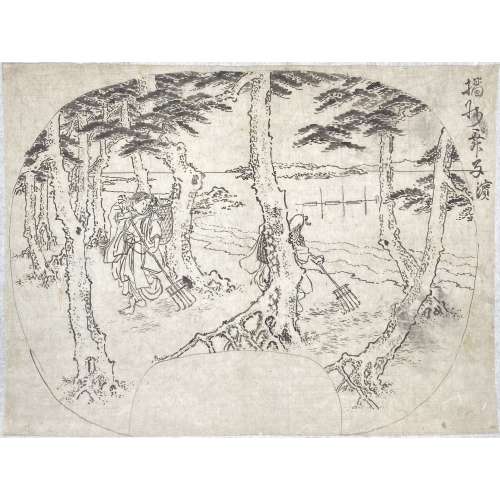 Artist: Veronica Miller attributes the drawing to Utagawa Sadahide [歌川 貞秀] (Japanese, 1807 – 1879), also known as Gountei Sadahide [五雲亭 貞秀]. A preparatory drawing for a fan print depicts two women raking pine needles along the scenic beach at Harima. Inscription at top right "Maiko Beach in Harima" (Harima Maiko no Hama) [播磨 舞子濱], which is now located in Hyōgo Prefecture. The view must be of the Akashi Strait, looking towards Awaji Island. Drawn on thin hanshita paper, mounted lightly at the top to a backing paper, but unbacked. Size: 240 x 319 mm. Attribution to Sadahide based on his design titled "Suma Bay: Matsukaze and Murasame" (see below):
Artist: Veronica Miller attributes the drawing to Utagawa Sadahide [歌川 貞秀] (Japanese, 1807 – 1879), also known as Gountei Sadahide [五雲亭 貞秀]. A preparatory drawing for a fan print depicts two women raking pine needles along the scenic beach at Harima. Inscription at top right "Maiko Beach in Harima" (Harima Maiko no Hama) [播磨 舞子濱], which is now located in Hyōgo Prefecture. The view must be of the Akashi Strait, looking towards Awaji Island. Drawn on thin hanshita paper, mounted lightly at the top to a backing paper, but unbacked. Size: 240 x 319 mm. Attribution to Sadahide based on his design titled "Suma Bay: Matsukaze and Murasame" (see below):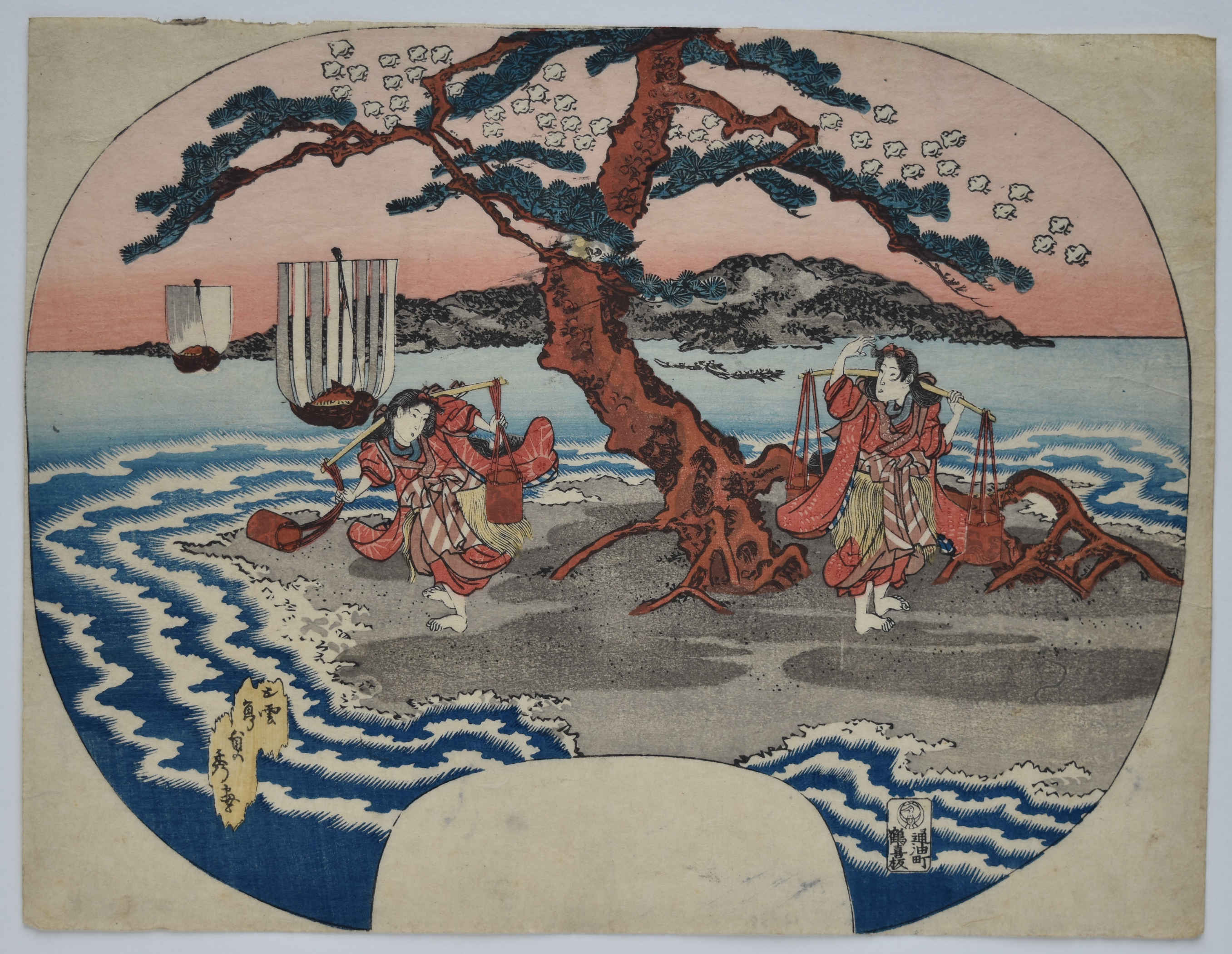 See also Maiko Beach, Harima Province, from the series Views of Famous Places in the Sixty-Odd Provinces,
See also Maiko Beach, Harima Province, from the series Views of Famous Places in the Sixty-Odd Provinces,
-
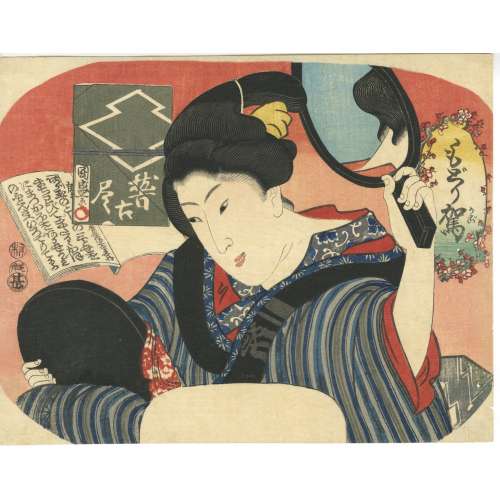 Title: Modori Kago [戻駕] (Returning palanquin). The dance-drama Modori Kago Iro ni Aikata [戻駕色相肩] premiered in the 11th lunar month of 1788 at the Nakamuraza [中村座], within Sakurada Jisuke I's kaomise [顔見世] (faceshowing) program Tôzumô Hana no Edogata [唐相撲花江戸方]", which celebrated the homecoming to Edo, after two years' absence, of Nakamura Nakazō I, and was intended to show off his particular talents in the role of Jirosaku (in reality Ishikawa Goemon [石川 五右衛門]) [kabuki21]. The symbol on a green book cover is the informal crest of tokiwazu-bushi [常磐津節] shaped like a water chestnut (Eleocharis dulcis) lozenge. Artist signature 国盛画 (Kunimori ga) with red toshidama. According to Samuel L. Leiter’s Kabuki Encyclopedia (1979), p. 243: The palanquin bearers Nanpa no Jirosaku and Azuma no Yōshirō, who are bearing a palanquin with a courtesan's young handmaiden in it, stop to rest at Kyoto's Murasakino, and each dances his regional dance. Then they call the girl, who does a dance showing the visitors to the famous pleasure quarters, Yoshiwara and Shimabara. The two men recognize each other as Ishikawa Goemon and Masashiba Hisayoshi, sworn enemies, and engage in a fight. This number is the only remaining section of an annual "faceshowing” (kaomize) work with a plot based on the medieval chronicle called the Toikōki. The full-length piece was called Kara Sumō Hanaeda no Kata. It is one of the most famous tokiwazu pieces and preserves the old-style Kabuki flavour. Nakamura Nakazō I played Jirosaku and Matsumoto Kōshirō IV was Yoshiro in the first production. The handmaiden was Matsumoto Komesaburō (probably Matsumoto Komasaburō I, an unknown actor [SV]). According to Egenolf Gallery: This work was first performed in 1788 at the Edo Nakamura-za as the season’s first performance and featured Nakamura Nakazō, who returned to Edo after three years in Osaka. It was a dance with tokiwazu chanting and was designed for him to play the lead role. In the piece, two palanquin carriers, one from Osaka, another from Edo, and a passenger – a kamuro, (a young geisha-in-training) exchange stories about the pleasure quarters of Shimabara and Yoshiwara. The text of the chanting book is open next to her, carrying the title “Collection of Practicing” [稽古尽くし], on which the green bundle cover carries the crest of Tokiwazu School, matsu-kawa-bishi, diamond variety of pine bark and the artist’s signature. Tokiwazu is a type of jōruri, narrative music, and accompanies dancing on the kabuki stage. Ref.: Christie's 27 Mar 2006. Publisher: Maruya Jinpachi, seal Marujin (Marks: 12-029 | 294e) Single nanushi censor seal: Mura (Murata Sahei, 1842-46). Provenance: Circular seal of the collector Huguette Bérès to verso. Contributors: Utagawa Kunimori [歌川国盛] (Japanese, fl. c. 1818 – 1943) – artist. Maruya Jinpachi [丸屋甚八] (Japanese, fl. 1770 – 1842) – publisher. Other mentioned: Nakamura Nakazō I [中村仲蔵] (Japanese, 1736 – 1790); other names: Nakayama Kojūrō VI, Nakamura Ichijūrō, Nakayama Manzō – actor. Matsumoto Kōshirō IV [松本幸四郎] (Japanese, 1737 – 1802); other names: Omegawa Kyōjūrō; Ichikawa Komazō II, Ichikawa Somegorô I, Ichikawa Takejūrō ; Segawa Kinji; Segawa Kingo – actor. Sakurada Jisuke I [桜田治助] (Japanese, 1734 – 1806) – dramatist.
Title: Modori Kago [戻駕] (Returning palanquin). The dance-drama Modori Kago Iro ni Aikata [戻駕色相肩] premiered in the 11th lunar month of 1788 at the Nakamuraza [中村座], within Sakurada Jisuke I's kaomise [顔見世] (faceshowing) program Tôzumô Hana no Edogata [唐相撲花江戸方]", which celebrated the homecoming to Edo, after two years' absence, of Nakamura Nakazō I, and was intended to show off his particular talents in the role of Jirosaku (in reality Ishikawa Goemon [石川 五右衛門]) [kabuki21]. The symbol on a green book cover is the informal crest of tokiwazu-bushi [常磐津節] shaped like a water chestnut (Eleocharis dulcis) lozenge. Artist signature 国盛画 (Kunimori ga) with red toshidama. According to Samuel L. Leiter’s Kabuki Encyclopedia (1979), p. 243: The palanquin bearers Nanpa no Jirosaku and Azuma no Yōshirō, who are bearing a palanquin with a courtesan's young handmaiden in it, stop to rest at Kyoto's Murasakino, and each dances his regional dance. Then they call the girl, who does a dance showing the visitors to the famous pleasure quarters, Yoshiwara and Shimabara. The two men recognize each other as Ishikawa Goemon and Masashiba Hisayoshi, sworn enemies, and engage in a fight. This number is the only remaining section of an annual "faceshowing” (kaomize) work with a plot based on the medieval chronicle called the Toikōki. The full-length piece was called Kara Sumō Hanaeda no Kata. It is one of the most famous tokiwazu pieces and preserves the old-style Kabuki flavour. Nakamura Nakazō I played Jirosaku and Matsumoto Kōshirō IV was Yoshiro in the first production. The handmaiden was Matsumoto Komesaburō (probably Matsumoto Komasaburō I, an unknown actor [SV]). According to Egenolf Gallery: This work was first performed in 1788 at the Edo Nakamura-za as the season’s first performance and featured Nakamura Nakazō, who returned to Edo after three years in Osaka. It was a dance with tokiwazu chanting and was designed for him to play the lead role. In the piece, two palanquin carriers, one from Osaka, another from Edo, and a passenger – a kamuro, (a young geisha-in-training) exchange stories about the pleasure quarters of Shimabara and Yoshiwara. The text of the chanting book is open next to her, carrying the title “Collection of Practicing” [稽古尽くし], on which the green bundle cover carries the crest of Tokiwazu School, matsu-kawa-bishi, diamond variety of pine bark and the artist’s signature. Tokiwazu is a type of jōruri, narrative music, and accompanies dancing on the kabuki stage. Ref.: Christie's 27 Mar 2006. Publisher: Maruya Jinpachi, seal Marujin (Marks: 12-029 | 294e) Single nanushi censor seal: Mura (Murata Sahei, 1842-46). Provenance: Circular seal of the collector Huguette Bérès to verso. Contributors: Utagawa Kunimori [歌川国盛] (Japanese, fl. c. 1818 – 1943) – artist. Maruya Jinpachi [丸屋甚八] (Japanese, fl. 1770 – 1842) – publisher. Other mentioned: Nakamura Nakazō I [中村仲蔵] (Japanese, 1736 – 1790); other names: Nakayama Kojūrō VI, Nakamura Ichijūrō, Nakayama Manzō – actor. Matsumoto Kōshirō IV [松本幸四郎] (Japanese, 1737 – 1802); other names: Omegawa Kyōjūrō; Ichikawa Komazō II, Ichikawa Somegorô I, Ichikawa Takejūrō ; Segawa Kinji; Segawa Kingo – actor. Sakurada Jisuke I [桜田治助] (Japanese, 1734 – 1806) – dramatist. -
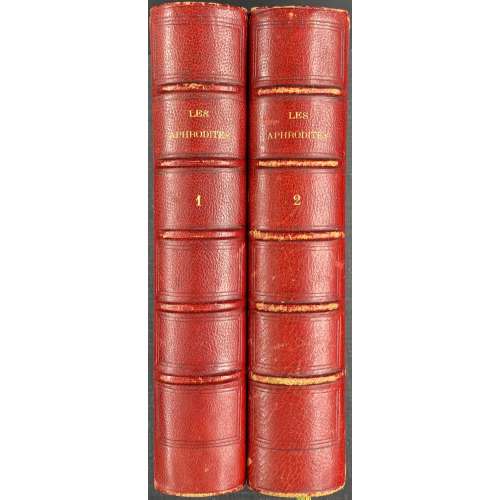 Two volumes in-12, 16.7 x 11.5 x 3.5 cm each, uniformly bound in quarter crimson morocco over marbled boards, spine with raised bands, gilt lettering, marbled endpapers, top margin gilt; text printed on laid paper, plates – on India paper: loose frontispiece by Félix Lukkow after Félicien Rops with tissue guard and 4 loose engraved plates by Félix Lukkow after Sigmund Freudenberger, in each volume. This edition is a reprint of an earlier publication: ANDRÉA DE NERCIAT, André-Robert (1739 - 1800). Les Aphrodites ou Fragments thali-priapiques pour servir à l'histoire du plaisir. Numéro Un et deux [Numéro trois et quatre [...] sept et huit]. 1793-1864. [Bruxelles : Briard pour Poulet-Malassis, 1864] with plated recarved by Félix Lukkow. Title-page: LES | APHRODITES | OU | FRAGMENTS THALI-PRIAPIQUES | POUR SERVIR A | L’HISTOIRE DU PLAISIR | — | Priape, soutiens mon hàleine… | Piron, Ode | — | Tome premier (second). | {publisher’s device} | A LAMPSAQUE | – | 1793 || Limitation: Edition is limited to 150 copies of which 130 on papier vergé, 5 on papier album jaune, 10 copies in-8o on large papier fort de Hollande, and one unique copy on peau de vélin. The number of this copy is left blank in both volumes. Vol. 1: π4 (h.t./limit., t.p./table, Éclaircissements historiques par V. M. D.), 1-2712 2910; total 182 leaves plus 5 leaves of plates, incl. frontispiece. Pagination: [1-5] 6-364, ils. V. M. D. stands for Vital Désiré Maximilien [Puissant]. Vol. 2: π2 (h.t., t.p.), 1-2912, 3110; total 192 leaves plus 5 leaves of plates, incl. frontispiece. Pagination: [1-5] 6-384, ils. Catalogue raisonné: Dutel I: A-95. Catalogue Poulet-Malassis & ses amis description: № 67. André-Robert ANDRÉA DE NERCIAT - [Félix LUKKOW]. Les Aphrodites, ou fragments thali-priapiques pour servir à l’histoire du plaisir. Tome premier (— second). A Lampsaque, 1793 [Vital Puissant, vers 1872]. 2 volumes in-12 de 364 et 384 pages, demi-maroquin rouge, dos à nerfs, tête dorée, non rogné (reliure de l’époque). Illustré de 2 frontispices et 8 planches volantes, par Félix Lukkow, d’après Félicien Rops pour les frontispices et Freundeberg pour les figures. Tirage limité à 151 ex. Contributors: André-Robert Andréa de Nerciat (French, 1739 – 1800) – author. Sigmund Freudenberger (Swiss, 1745 – 1801) – artist. Félicien Rops (Belgian, 1833 – 1898) – artist. Félix Lukkow (French, fl. c. 1870 – 1875) – engraver.
Two volumes in-12, 16.7 x 11.5 x 3.5 cm each, uniformly bound in quarter crimson morocco over marbled boards, spine with raised bands, gilt lettering, marbled endpapers, top margin gilt; text printed on laid paper, plates – on India paper: loose frontispiece by Félix Lukkow after Félicien Rops with tissue guard and 4 loose engraved plates by Félix Lukkow after Sigmund Freudenberger, in each volume. This edition is a reprint of an earlier publication: ANDRÉA DE NERCIAT, André-Robert (1739 - 1800). Les Aphrodites ou Fragments thali-priapiques pour servir à l'histoire du plaisir. Numéro Un et deux [Numéro trois et quatre [...] sept et huit]. 1793-1864. [Bruxelles : Briard pour Poulet-Malassis, 1864] with plated recarved by Félix Lukkow. Title-page: LES | APHRODITES | OU | FRAGMENTS THALI-PRIAPIQUES | POUR SERVIR A | L’HISTOIRE DU PLAISIR | — | Priape, soutiens mon hàleine… | Piron, Ode | — | Tome premier (second). | {publisher’s device} | A LAMPSAQUE | – | 1793 || Limitation: Edition is limited to 150 copies of which 130 on papier vergé, 5 on papier album jaune, 10 copies in-8o on large papier fort de Hollande, and one unique copy on peau de vélin. The number of this copy is left blank in both volumes. Vol. 1: π4 (h.t./limit., t.p./table, Éclaircissements historiques par V. M. D.), 1-2712 2910; total 182 leaves plus 5 leaves of plates, incl. frontispiece. Pagination: [1-5] 6-364, ils. V. M. D. stands for Vital Désiré Maximilien [Puissant]. Vol. 2: π2 (h.t., t.p.), 1-2912, 3110; total 192 leaves plus 5 leaves of plates, incl. frontispiece. Pagination: [1-5] 6-384, ils. Catalogue raisonné: Dutel I: A-95. Catalogue Poulet-Malassis & ses amis description: № 67. André-Robert ANDRÉA DE NERCIAT - [Félix LUKKOW]. Les Aphrodites, ou fragments thali-priapiques pour servir à l’histoire du plaisir. Tome premier (— second). A Lampsaque, 1793 [Vital Puissant, vers 1872]. 2 volumes in-12 de 364 et 384 pages, demi-maroquin rouge, dos à nerfs, tête dorée, non rogné (reliure de l’époque). Illustré de 2 frontispices et 8 planches volantes, par Félix Lukkow, d’après Félicien Rops pour les frontispices et Freundeberg pour les figures. Tirage limité à 151 ex. Contributors: André-Robert Andréa de Nerciat (French, 1739 – 1800) – author. Sigmund Freudenberger (Swiss, 1745 – 1801) – artist. Félicien Rops (Belgian, 1833 – 1898) – artist. Félix Lukkow (French, fl. c. 1870 – 1875) – engraver. -
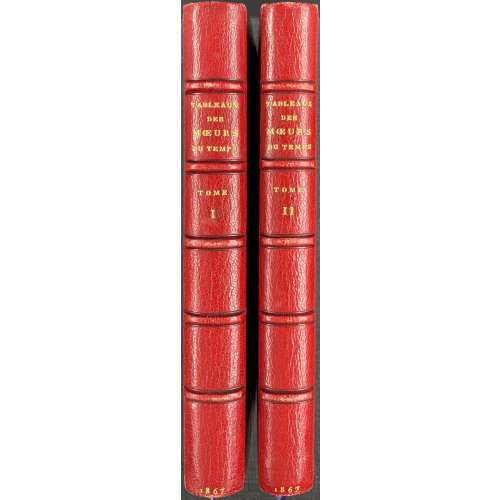 Two volumes in-12, 16.8 x 11.5 cm each, uniformly bound in ¾ red crushed morocco over marbled boards, spine with raised bands and gilt lettering, marbled endpapers, text printed on laid paper, 6 plates (3 in each vol.) on India paper pasted in on thick laid paper leaves. This edition seems similar to Nordmann I 203 but without Félicien Rops' frontispiece and plates, replaced by unsigned etchings attributed to Gustave Staal. Title-page (red and black): LE RICHE DE LA POPELINIÈRE | – | TABLEAUX | DES | MŒURS DU TEMPS | DANS LES DIFFÉRENTS AGES DE LA VIE | – | NOTICE DE | CHARLES MONSELET | – | TOME PREMIER (SECOND) | {fleuron} | PARIS | IMPRIMERIE DES CI-DEVANT FERMIERS GÉNÉRAUX | – | M D CCC L XVII || Vol. 1: π2 (h.t., t.p.) a4 (Notice), 1-1312 151 (Table); total 91 leaves plus three leaves of plates. Pagination: [4] [i] ii-vii [viii] [3] 4-168 [2]; total 182 pp, ils. facing pp. 59, 78, and 94. Vol. 2: π2 (h.t., t.p.), 1-1312, 152; total 88 leaves plus three leaves of plates. Pagination: [4] [1] 2-170 [2]; total 176 pp, ils. facing pp. 74, 78, and 145. Catalogue raisonné: Dutel I: A-1044 — without Félicien Rops ‘ornementations’, but with ‘6 gravures de 1865’. Dutel suggests that the edition was performed by A. Poulet-Malassis, Briard or Lécrivain. Catalogue Poulet-Malassis & ses amis description: № 43. LE RICHE DE LA POPELINIÈRE. Tableaux des mœurs du temps dans les diérents âges de la vie, tome premier (— second). Notice de M. Charles Monselet. Imprimerie des ci-devant fermiers généraux, Paris, M D CCC LXVII [A. Poulet-Malassis, 1867]. Exemplaire sans le frontispice de Félicien Rops mais bien complet des 6 figures de Staal, justification qui illustre les aléas de la confection des publications clandestines. D’une part, c’est une autre édition qui est décrite par Launay. L’exemplaire vendu chez Maître Loudmer avait 6 figures, comme ici. Cluzel a vu un “front. et 4 vignettes de Rops plus cinq figures libres (par Staal)”, Simonson a vu 5 figures de Rops, etc., etc. Il y a 3 bandeaux et 3 culs-de-lampe de Rops qui ont été fréquemment utilisés par d’autres éditeurs pour d’autres titres pendant toute la seconde moitié du xixe siècle. La Léonina présente une fiche détaillée sur 4 pages. 3 bandeaux et 3 culs-de-lampe gravés sur bois de Rops. Bibliographie : Pia 1389, Launay 327, Gay 6-308, Pey 122 (1800 frs avec 5 figures), PC 503 et 504, Lemonnyer 3-1173, LL 66, Leonina 81, Nordmann 1-203, Dutel A-1043. Contributors: Alexandre Jean Joseph Le Riche de La Popelinière (French, 1693 – 1762) – author. Charles Monselet (French, 1825 – 1888) – author (foreword). Pierre-Gustave-Eugène Staal (French, 1817 – 1882) – artist. Auguste Poulet-Malassis (French, 1825 – 1878) – publisher.
Two volumes in-12, 16.8 x 11.5 cm each, uniformly bound in ¾ red crushed morocco over marbled boards, spine with raised bands and gilt lettering, marbled endpapers, text printed on laid paper, 6 plates (3 in each vol.) on India paper pasted in on thick laid paper leaves. This edition seems similar to Nordmann I 203 but without Félicien Rops' frontispiece and plates, replaced by unsigned etchings attributed to Gustave Staal. Title-page (red and black): LE RICHE DE LA POPELINIÈRE | – | TABLEAUX | DES | MŒURS DU TEMPS | DANS LES DIFFÉRENTS AGES DE LA VIE | – | NOTICE DE | CHARLES MONSELET | – | TOME PREMIER (SECOND) | {fleuron} | PARIS | IMPRIMERIE DES CI-DEVANT FERMIERS GÉNÉRAUX | – | M D CCC L XVII || Vol. 1: π2 (h.t., t.p.) a4 (Notice), 1-1312 151 (Table); total 91 leaves plus three leaves of plates. Pagination: [4] [i] ii-vii [viii] [3] 4-168 [2]; total 182 pp, ils. facing pp. 59, 78, and 94. Vol. 2: π2 (h.t., t.p.), 1-1312, 152; total 88 leaves plus three leaves of plates. Pagination: [4] [1] 2-170 [2]; total 176 pp, ils. facing pp. 74, 78, and 145. Catalogue raisonné: Dutel I: A-1044 — without Félicien Rops ‘ornementations’, but with ‘6 gravures de 1865’. Dutel suggests that the edition was performed by A. Poulet-Malassis, Briard or Lécrivain. Catalogue Poulet-Malassis & ses amis description: № 43. LE RICHE DE LA POPELINIÈRE. Tableaux des mœurs du temps dans les diérents âges de la vie, tome premier (— second). Notice de M. Charles Monselet. Imprimerie des ci-devant fermiers généraux, Paris, M D CCC LXVII [A. Poulet-Malassis, 1867]. Exemplaire sans le frontispice de Félicien Rops mais bien complet des 6 figures de Staal, justification qui illustre les aléas de la confection des publications clandestines. D’une part, c’est une autre édition qui est décrite par Launay. L’exemplaire vendu chez Maître Loudmer avait 6 figures, comme ici. Cluzel a vu un “front. et 4 vignettes de Rops plus cinq figures libres (par Staal)”, Simonson a vu 5 figures de Rops, etc., etc. Il y a 3 bandeaux et 3 culs-de-lampe de Rops qui ont été fréquemment utilisés par d’autres éditeurs pour d’autres titres pendant toute la seconde moitié du xixe siècle. La Léonina présente une fiche détaillée sur 4 pages. 3 bandeaux et 3 culs-de-lampe gravés sur bois de Rops. Bibliographie : Pia 1389, Launay 327, Gay 6-308, Pey 122 (1800 frs avec 5 figures), PC 503 et 504, Lemonnyer 3-1173, LL 66, Leonina 81, Nordmann 1-203, Dutel A-1043. Contributors: Alexandre Jean Joseph Le Riche de La Popelinière (French, 1693 – 1762) – author. Charles Monselet (French, 1825 – 1888) – author (foreword). Pierre-Gustave-Eugène Staal (French, 1817 – 1882) – artist. Auguste Poulet-Malassis (French, 1825 – 1878) – publisher. -
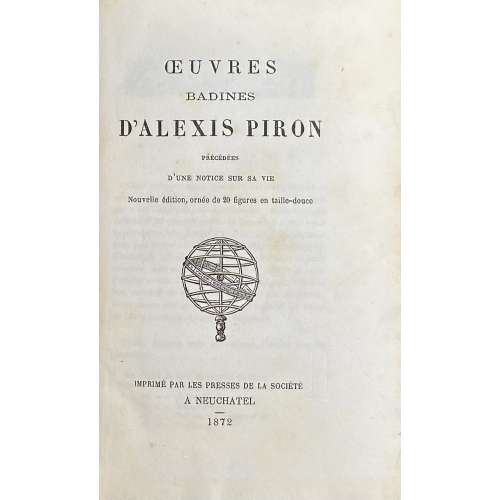 Single volume, 17.1 x 11.2 cm, quarter black sheepskin over faux chagrin, gilt lettering to spine, marbled endpapers, bottom and outer margin untrimmed, pp.: [i-v] vi- xxxvi, [1] 2-218 [2], collated 4to: π2, a-d4, 1-274 282, total 256 pages or 128 leaves, plus 20 engraved plates by Paul Sellier, including frontispiece portrait of Alexis Piron after bust by Caffieri. Vol. 8 of Bibliothèque Libre, Œuvres badines de Piron, printed on February 15, 1872. Text printed on dense wove paper watermarked P or M, plates printed on India wove paper. A reprint of an edition published in 1796 plus illustrations. Title-page: ŒUVRES | BADINES | D’ALEXIS PIRON | PRÉCÉDÉES | D’UNE NOTICE SUR SA VIE | Nouvelle édition, ornée de 20 figures en taille-douce | {vignette} | IMPRIMÉ PAR LES PRESSES DE LA SOCIÉTÉ | A NEUCHATEL | – | 1872 || Limitation: 100 numbered copies, of which this is № 75. Catalogue raisonné: Dutel I: A-788; Pia: 953-6; Kearney 377 (Patrick J. Kearney. A Catalogue of the publications of Jules Gay, Jean-Jules Gay & Gay et Doucé, revised & expanded. — Santa Rosa, CA Scissors & Paste Bibliographies, 2019) Catalogue Poulet-Malassis & ses amis description: № 81. Alexis PIRON. Œuvres badines précédées d’une notice sur sa vie. Nouvelle édition ornée de 20 figures en taille-douce. [ Jules Gay] Imprimé par les presses de la société, à Neufchatel, 1872. In-8, xxxvi, 218 pages et un feuillet d’achevé d’imprimer de table, demi-basane noire, dos à faux nerfs, tête et tranches naturelles. Illustré d’un portrait et de 20 figures par Paul Sellier. Tirage limité à 100 ex. numérotés. De la « Bibliothèque libre ou collection choisie d’ouvrages du genre libre, imprimés ou réimprimés par les soins de la Société des Bibliophiles Cosmopolites et pour les membres de cette société, à cent exemplaires numérotés ». Bibliographie : Pia 1030, Enfer 1274, Lem 3-454, Gay 5-339, PC 353, G* 38, Pey 203, Dutel A-788." Contributors: Alexis Piron (French, 1689 – 1773) – author. Paul Sellier (French, 1842 – 19..?) – artist. Jules Léopold Gay (French, 1807 – 1887) – publisher.
Single volume, 17.1 x 11.2 cm, quarter black sheepskin over faux chagrin, gilt lettering to spine, marbled endpapers, bottom and outer margin untrimmed, pp.: [i-v] vi- xxxvi, [1] 2-218 [2], collated 4to: π2, a-d4, 1-274 282, total 256 pages or 128 leaves, plus 20 engraved plates by Paul Sellier, including frontispiece portrait of Alexis Piron after bust by Caffieri. Vol. 8 of Bibliothèque Libre, Œuvres badines de Piron, printed on February 15, 1872. Text printed on dense wove paper watermarked P or M, plates printed on India wove paper. A reprint of an edition published in 1796 plus illustrations. Title-page: ŒUVRES | BADINES | D’ALEXIS PIRON | PRÉCÉDÉES | D’UNE NOTICE SUR SA VIE | Nouvelle édition, ornée de 20 figures en taille-douce | {vignette} | IMPRIMÉ PAR LES PRESSES DE LA SOCIÉTÉ | A NEUCHATEL | – | 1872 || Limitation: 100 numbered copies, of which this is № 75. Catalogue raisonné: Dutel I: A-788; Pia: 953-6; Kearney 377 (Patrick J. Kearney. A Catalogue of the publications of Jules Gay, Jean-Jules Gay & Gay et Doucé, revised & expanded. — Santa Rosa, CA Scissors & Paste Bibliographies, 2019) Catalogue Poulet-Malassis & ses amis description: № 81. Alexis PIRON. Œuvres badines précédées d’une notice sur sa vie. Nouvelle édition ornée de 20 figures en taille-douce. [ Jules Gay] Imprimé par les presses de la société, à Neufchatel, 1872. In-8, xxxvi, 218 pages et un feuillet d’achevé d’imprimer de table, demi-basane noire, dos à faux nerfs, tête et tranches naturelles. Illustré d’un portrait et de 20 figures par Paul Sellier. Tirage limité à 100 ex. numérotés. De la « Bibliothèque libre ou collection choisie d’ouvrages du genre libre, imprimés ou réimprimés par les soins de la Société des Bibliophiles Cosmopolites et pour les membres de cette société, à cent exemplaires numérotés ». Bibliographie : Pia 1030, Enfer 1274, Lem 3-454, Gay 5-339, PC 353, G* 38, Pey 203, Dutel A-788." Contributors: Alexis Piron (French, 1689 – 1773) – author. Paul Sellier (French, 1842 – 19..?) – artist. Jules Léopold Gay (French, 1807 – 1887) – publisher. -
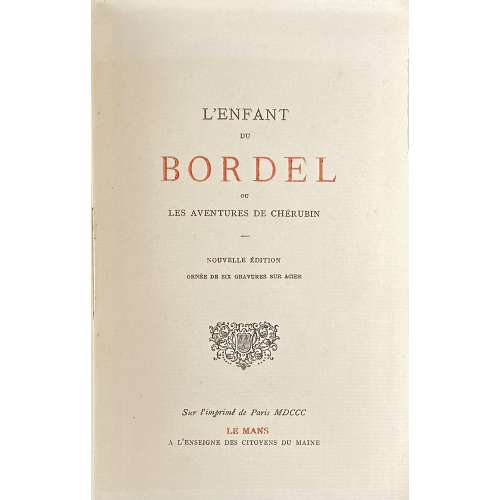 Softcover volume, 17.5 x 11 cm, in-12, brown wrappers without lettering, text printed on laid paper, six plates on India paper barbarously glued in, pp.: fep, [4] (h.t. t.p.), [1-3] 4-182, fep. Title-page (red and black): L’ENFANT | DU | BORDEL | OU | LES AVENTURES DE CHÉRUBIN | – | NOUVELLE ÉDITION | ORNÉE DE SIX GRAVURES SUR ACIER | {fleuron} | Sur l’imprimé de Paris MDCCC | LE MANS | A L’ENSEIGNE DES CITOYENS DU MAINE || Catalogue raisonné: Dutel I: A-325; Pia 395: 222 pages (we have 182 as per Dutel), attributes publication to Poulet-Malassis, 1866. Catalogue Poulet-Malassis & ses amis description: № 82.[PIGAULT-LEBRUN]. L’Enfant du Bordel, ou Les Aventures de Chérubin, nouvelle édition, ornée de six gravures sur acier. Sur l’imprimé de Paris, MDCCC, Le Mans, à l’enseigne des citoyens du Maine. [A. Christiaens, 1875 ?]. In-12, broché. 2 .n.ch., 182 pages, 1 f. blanc, couverture muette en papier vieux orange. Illustré de 6 figures hors-texte sur acier. Bibliographie : G* 553 (40 frs), Dutel A-325. Contributors: Guillaume Charles Antoine Pigault de l'Espinoy [Pigault-Lebrun] (French, 1753 – 1835) – author. Alexis Christiaens (Belgian, d. 1880) – publisher.
Softcover volume, 17.5 x 11 cm, in-12, brown wrappers without lettering, text printed on laid paper, six plates on India paper barbarously glued in, pp.: fep, [4] (h.t. t.p.), [1-3] 4-182, fep. Title-page (red and black): L’ENFANT | DU | BORDEL | OU | LES AVENTURES DE CHÉRUBIN | – | NOUVELLE ÉDITION | ORNÉE DE SIX GRAVURES SUR ACIER | {fleuron} | Sur l’imprimé de Paris MDCCC | LE MANS | A L’ENSEIGNE DES CITOYENS DU MAINE || Catalogue raisonné: Dutel I: A-325; Pia 395: 222 pages (we have 182 as per Dutel), attributes publication to Poulet-Malassis, 1866. Catalogue Poulet-Malassis & ses amis description: № 82.[PIGAULT-LEBRUN]. L’Enfant du Bordel, ou Les Aventures de Chérubin, nouvelle édition, ornée de six gravures sur acier. Sur l’imprimé de Paris, MDCCC, Le Mans, à l’enseigne des citoyens du Maine. [A. Christiaens, 1875 ?]. In-12, broché. 2 .n.ch., 182 pages, 1 f. blanc, couverture muette en papier vieux orange. Illustré de 6 figures hors-texte sur acier. Bibliographie : G* 553 (40 frs), Dutel A-325. Contributors: Guillaume Charles Antoine Pigault de l'Espinoy [Pigault-Lebrun] (French, 1753 – 1835) – author. Alexis Christiaens (Belgian, d. 1880) – publisher. -
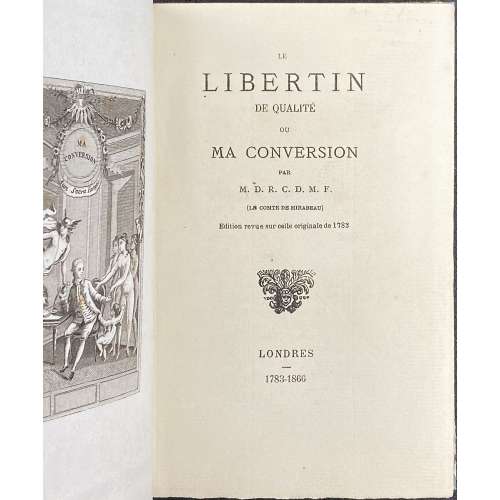 Hardcover volume, 17 x 11.3 cm, in-12, quarter orange cloth (percaline) over marbled boards, black morocco label with gilt lettering to spine, marbled endpapers, text printed on laid paper, five plates on India paper (papier Chine). Title-page: LE | LIBERTIN | DE QUALITÉ | OU | MA CONVERSION | PAR | M. D. R. C. D. M. F. | (LE COMTE DE MIRABEAU) | Edition revue sur celle originale de 1783 | {fleuron} | LONDRES | – | 1783-1866 || Pagination: [4] (h.t., t.p.), [1] 2-200; total 204 pages plus 5 engraved plates, incl. frontispiece; 2 blank leaves at the front and 2 at the back, laid paper, watermarked Canson & Montgolfier. Catalogue raisonné: Dutel I: A-653. Ref.: Illustrations were earlier published in Vie privée, libertine et scandaleuse de feu Honoré-Gabriel Riquetti Comte de Mirabeau, 1791, (see [LIB-2633.2021] Apollinaire, et al. L’Enfer de la Bibliothèque nationale, 1912 : № 795). M. D. R. C. D. M. F stands for Monsieur de Riqueti comte de Mirabeau Fis. Catalogue Poulet-Malassis & ses amis description: № 55. M. D. R. C. D. M. F. (le comte de Mirabeau). Le Libertin de qualité ou Ma conversion, édition revue sur celle de l’originale de 1783. Londres 1783-1866 [Christiaens, 1867]. In-12 de 2 .n.ch. et 200 pages, demi-percaline orange, pièce de titre, tête jaspée, tranches naturelles (reliure de l’époque). Illustré de 5 gravures originales, dont l’une en frontispice, qui reprennent celles de l’édition de Vie privée libertine et scandaleuse de feu Honoré-Gabriel-Riqueti, ci-devant comte de Mirabeau [...] de 1791. Contributors: Honoré-Gabriel Riqueti de Mirabeau (French, 1749 – 1791) – author. Alexis Christiaens (Belgian, d. 1880) – publisher.
Hardcover volume, 17 x 11.3 cm, in-12, quarter orange cloth (percaline) over marbled boards, black morocco label with gilt lettering to spine, marbled endpapers, text printed on laid paper, five plates on India paper (papier Chine). Title-page: LE | LIBERTIN | DE QUALITÉ | OU | MA CONVERSION | PAR | M. D. R. C. D. M. F. | (LE COMTE DE MIRABEAU) | Edition revue sur celle originale de 1783 | {fleuron} | LONDRES | – | 1783-1866 || Pagination: [4] (h.t., t.p.), [1] 2-200; total 204 pages plus 5 engraved plates, incl. frontispiece; 2 blank leaves at the front and 2 at the back, laid paper, watermarked Canson & Montgolfier. Catalogue raisonné: Dutel I: A-653. Ref.: Illustrations were earlier published in Vie privée, libertine et scandaleuse de feu Honoré-Gabriel Riquetti Comte de Mirabeau, 1791, (see [LIB-2633.2021] Apollinaire, et al. L’Enfer de la Bibliothèque nationale, 1912 : № 795). M. D. R. C. D. M. F stands for Monsieur de Riqueti comte de Mirabeau Fis. Catalogue Poulet-Malassis & ses amis description: № 55. M. D. R. C. D. M. F. (le comte de Mirabeau). Le Libertin de qualité ou Ma conversion, édition revue sur celle de l’originale de 1783. Londres 1783-1866 [Christiaens, 1867]. In-12 de 2 .n.ch. et 200 pages, demi-percaline orange, pièce de titre, tête jaspée, tranches naturelles (reliure de l’époque). Illustré de 5 gravures originales, dont l’une en frontispice, qui reprennent celles de l’édition de Vie privée libertine et scandaleuse de feu Honoré-Gabriel-Riqueti, ci-devant comte de Mirabeau [...] de 1791. Contributors: Honoré-Gabriel Riqueti de Mirabeau (French, 1749 – 1791) – author. Alexis Christiaens (Belgian, d. 1880) – publisher. -
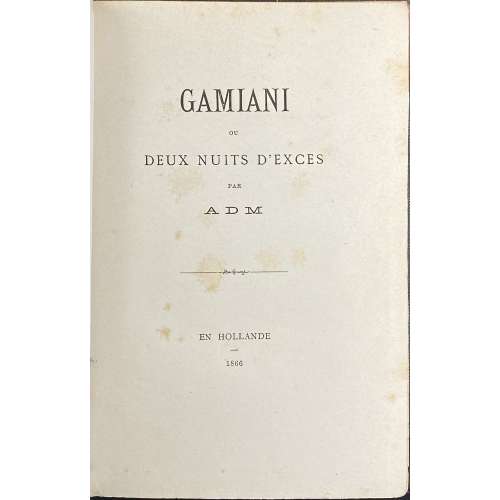 Single volume, 18 x 12.5 cm, bound in ¾ crimson morocco over marbled boards, gilt double-fillet borders, spine with gilded raised bands, gilt in compartments, gilt-lettered label, marbled endpapers, top margin gilt, text printed on dense wove paper, with 8 etchings by anonymous on thin laid paper (Chine) with tissue guards, after original lithographs by Devéria and Henri Grévedon or Octave Tassaert for the 1833 edition (1926 re-print LIB-3135.2023); the plate with the ape after 1864 edition (LIB-3087.2022) and the plate with the donkey after unknown. Title-page: GAMIANI | OU | DEUX NUITS D’EXCES | PAR | A D M | — | EN HOLLANDE | – | 1866 || Pagination: [4] (h.t., t.p.), [i] ii-xvi, [3] 4-153 [154 blank]; total 158 pages plus 8 plates (anonymous etchings), incl. frontispiece. Catalogue raisonné: Dutel I: A-470; Pia: 518/9. BNF Enfer 418. Note: This edition is conformant with Dutel, but not with Pia, who mentions [2], xvi, 148 pp. Pia writes: 'According to a bibliographic record published in 1874 by Vital Puissant, this edition was printed in Brussels by Briard on behalf of Alphonse Lécrivain, a Parisian publisher who took refuge in Belgium'. Catalogue Poulet-Malassis & ses amis description: № 74. [Alfred de MUSSET] A D M. Gamiani ou deux nuits d’excès. En Hollande, 1866. In-8 de xvi, 153 pages, demi-maroquin cerise à coins, dos à nerfs orné, lets dorés sur les mors, tête dorée, tranches naturelles, couverture conservée (reliure ancienne). Illustré de 8 gravures sur Chine dont l’une en frontispice, toutes accompagnées de serpentines. Piqûres et mouillures. Dutel A-470, pas à l’Enfer de la BnF.
Single volume, 18 x 12.5 cm, bound in ¾ crimson morocco over marbled boards, gilt double-fillet borders, spine with gilded raised bands, gilt in compartments, gilt-lettered label, marbled endpapers, top margin gilt, text printed on dense wove paper, with 8 etchings by anonymous on thin laid paper (Chine) with tissue guards, after original lithographs by Devéria and Henri Grévedon or Octave Tassaert for the 1833 edition (1926 re-print LIB-3135.2023); the plate with the ape after 1864 edition (LIB-3087.2022) and the plate with the donkey after unknown. Title-page: GAMIANI | OU | DEUX NUITS D’EXCES | PAR | A D M | — | EN HOLLANDE | – | 1866 || Pagination: [4] (h.t., t.p.), [i] ii-xvi, [3] 4-153 [154 blank]; total 158 pages plus 8 plates (anonymous etchings), incl. frontispiece. Catalogue raisonné: Dutel I: A-470; Pia: 518/9. BNF Enfer 418. Note: This edition is conformant with Dutel, but not with Pia, who mentions [2], xvi, 148 pp. Pia writes: 'According to a bibliographic record published in 1874 by Vital Puissant, this edition was printed in Brussels by Briard on behalf of Alphonse Lécrivain, a Parisian publisher who took refuge in Belgium'. Catalogue Poulet-Malassis & ses amis description: № 74. [Alfred de MUSSET] A D M. Gamiani ou deux nuits d’excès. En Hollande, 1866. In-8 de xvi, 153 pages, demi-maroquin cerise à coins, dos à nerfs orné, lets dorés sur les mors, tête dorée, tranches naturelles, couverture conservée (reliure ancienne). Illustré de 8 gravures sur Chine dont l’une en frontispice, toutes accompagnées de serpentines. Piqûres et mouillures. Dutel A-470, pas à l’Enfer de la BnF. -
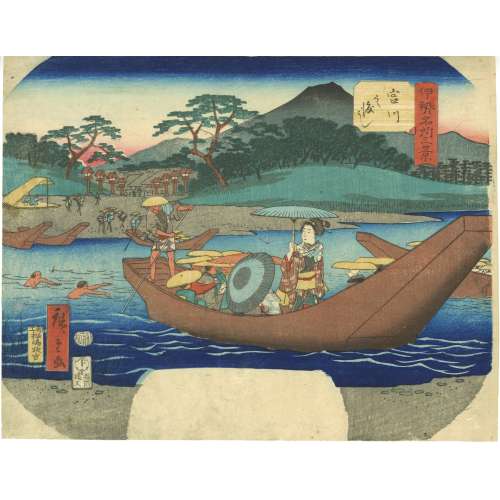 Artist: Utagawa Hiroshige II (二代目 歌川広重] (Japanese, 1826 – 1869). Signed: Hiroshige ga. Publisher: Enshūya Matabei [遠州屋又兵衛] (Japanese, fl. c. 1768 – 1881); (Enmata [遠又]), seal 22-009 (Marks). Block carver: Matsushima Masakichi (Japanese, fl. c. 1847-65); seal: [松嶋彫政] – Hori Masa (Frieze, 2009: 142). Combined date seal and kiwame censor seal: Bunkyū 2 (1862). Media: Fan print (uchiwa-e, 団扇絵), 230 x 298 mm Series: Three Famous Views in Ise [伊勢名所三景] (Ise meisho sankei).
Artist: Utagawa Hiroshige II (二代目 歌川広重] (Japanese, 1826 – 1869). Signed: Hiroshige ga. Publisher: Enshūya Matabei [遠州屋又兵衛] (Japanese, fl. c. 1768 – 1881); (Enmata [遠又]), seal 22-009 (Marks). Block carver: Matsushima Masakichi (Japanese, fl. c. 1847-65); seal: [松嶋彫政] – Hori Masa (Frieze, 2009: 142). Combined date seal and kiwame censor seal: Bunkyū 2 (1862). Media: Fan print (uchiwa-e, 団扇絵), 230 x 298 mm Series: Three Famous Views in Ise [伊勢名所三景] (Ise meisho sankei). -
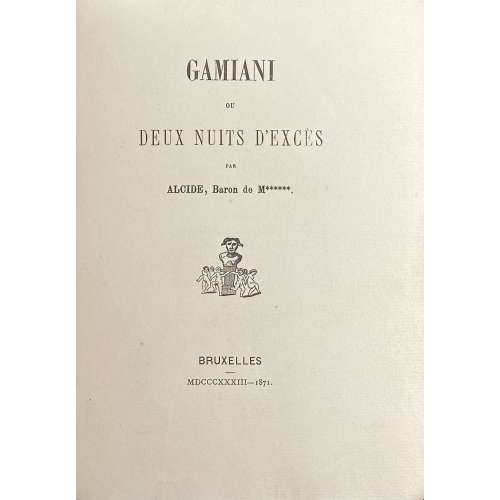 Single volume, 19.2 x 14.2 cm, bound in ¾ dark blue morocco over peacock marbled boards, gilt double-fillet border, spine with gilded raised bands, gilt fleurons and lettering, marbled endpapers, top margin gilt, outer margin uncut; text printed on watermarked laid paper; frontispiece by Félicien Rops, plates by Félix Lukkow after original lithographs by Devéria and Henri Grévedon or Octave Tassaert for the 1833 edition (1926 re-print LIB-3135.2023); the plate with the ape may be considered 'after edition of 1864' (LIB-3087.2022). Collation: π2 (h.t., t.p.) [a]8 1-712 96, total 64 leaves plus etched frontispiece in sanguine after page 8 and 12 engraved plates on India paper; illustrations include six burin engravings printed in two versions each, black and red, all six by Félix Lukkow after Devéria and Grévedon. Pagination: [4] [i] ii-viii, [1] 2-116, total 128 pages, ils. Title-page: GAMIANI | OU | DEUX NUITS D’EXCES | PAR | ALCIDE, Baron de M******. | {publisher's device} | — | BRUXELLES | MDCCCXXXIII—1871. || Limitation: Print run of 150 copies of which one unique on peau de vélin, 130 on laid paper (papier vergé), 5 on papier album jaune, 4 on papier de Chine, 10 on papier fort de Hollande. This is copy № 3, on Van Gelder laid paper, watermarked (possibly this is what they call ‘papier fort de Hollande’). Catalogue raisonné: Dutel I: A-472; Pia 520. Ref.: BNF Enfer 66. Contributors: Alfred de Musset (French, 1810 – 1857) – author. Félicien Rops (Belgian, 1833 – 1898) – artist. Félix Lukkow (French, fl. c. 1870 – 1875) – engraver. Vital Puissant (Belgian, 1835 – 1878) – publisher. Catalogue Poulet-Malassis & ses amis description: № 58. [Alfred de MUSSET - Félix LUKKOV] Alcide, baron de M******. Gamiani ou Deux nuits d’excès. Bruxelles, M DCCC XXXIII - 1871 [Vital Puissant]. In-8 de 2 .n.ch, viii, 116 pages, demi-chagrin bleu à coins, dos à nerfs orné, lets dorés et à froid sur les mors, tête dorée, tranches naturelles, non rogné (reliure de l’époque). Illustré de 7 gravures sur Chine, dont une en frontispice, en double état (sauf le frontispice) par Félix Lukkov, d’après les gravures de Félicien Rops. Tirage à 150 ex. L’un des 10 ex. tirés in-8, sur grand papier fort de Hollande (n° 3). Bibliographie : Pia 561, Per 16-14, Enfer 66, Dutel A-472.
Single volume, 19.2 x 14.2 cm, bound in ¾ dark blue morocco over peacock marbled boards, gilt double-fillet border, spine with gilded raised bands, gilt fleurons and lettering, marbled endpapers, top margin gilt, outer margin uncut; text printed on watermarked laid paper; frontispiece by Félicien Rops, plates by Félix Lukkow after original lithographs by Devéria and Henri Grévedon or Octave Tassaert for the 1833 edition (1926 re-print LIB-3135.2023); the plate with the ape may be considered 'after edition of 1864' (LIB-3087.2022). Collation: π2 (h.t., t.p.) [a]8 1-712 96, total 64 leaves plus etched frontispiece in sanguine after page 8 and 12 engraved plates on India paper; illustrations include six burin engravings printed in two versions each, black and red, all six by Félix Lukkow after Devéria and Grévedon. Pagination: [4] [i] ii-viii, [1] 2-116, total 128 pages, ils. Title-page: GAMIANI | OU | DEUX NUITS D’EXCES | PAR | ALCIDE, Baron de M******. | {publisher's device} | — | BRUXELLES | MDCCCXXXIII—1871. || Limitation: Print run of 150 copies of which one unique on peau de vélin, 130 on laid paper (papier vergé), 5 on papier album jaune, 4 on papier de Chine, 10 on papier fort de Hollande. This is copy № 3, on Van Gelder laid paper, watermarked (possibly this is what they call ‘papier fort de Hollande’). Catalogue raisonné: Dutel I: A-472; Pia 520. Ref.: BNF Enfer 66. Contributors: Alfred de Musset (French, 1810 – 1857) – author. Félicien Rops (Belgian, 1833 – 1898) – artist. Félix Lukkow (French, fl. c. 1870 – 1875) – engraver. Vital Puissant (Belgian, 1835 – 1878) – publisher. Catalogue Poulet-Malassis & ses amis description: № 58. [Alfred de MUSSET - Félix LUKKOV] Alcide, baron de M******. Gamiani ou Deux nuits d’excès. Bruxelles, M DCCC XXXIII - 1871 [Vital Puissant]. In-8 de 2 .n.ch, viii, 116 pages, demi-chagrin bleu à coins, dos à nerfs orné, lets dorés et à froid sur les mors, tête dorée, tranches naturelles, non rogné (reliure de l’époque). Illustré de 7 gravures sur Chine, dont une en frontispice, en double état (sauf le frontispice) par Félix Lukkov, d’après les gravures de Félicien Rops. Tirage à 150 ex. L’un des 10 ex. tirés in-8, sur grand papier fort de Hollande (n° 3). Bibliographie : Pia 561, Per 16-14, Enfer 66, Dutel A-472. -
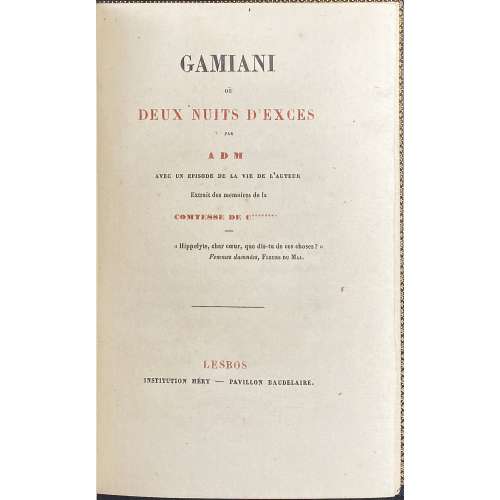 Single volume, 16.8 x 11.3 cm, bound in full dark olive crushed morocco by Brany (signed), gilt triple-fillet border to boards, spine with raised bands, gilt in compartments, gilt-lettered label, gilt dentelle inside, marbled endpapers, all margins gilt, gilt double fillet to boards margin; text printed on laid paper. Bookplate of Maurice Lebarbier de Tinan to fep 45 x 35 mm representing standing satyr with erected penis holding monogram ‘MT’ in his hands with a motto below on a ribbon ‘FAIRE SANS DIRE’. Maurice Lebarbier de Tinan book collection was dispersed via l’hôtel Drouot (Paris) on a sale from March 9 to 12, 1885; a catalogue was published: Catalogue d’un joli choix de livres anciens et modernes, en très belle condition de reliure, composant la bibliothèque de M. L. de T*** [Lebarbier de Tinan] (Paris, Ch. Porquet, 1885, in-8, VIII-140 p., 481 lots). Collation: π2 (h.t., t.p.) a6 b2 1-1112, total 82 leaves plus 18 engraved plates on wove paper; illustrations include engraved frontispiece and six etchings printed in two versions each, black and red, and one etching (at p. 103) in two states, two colour versions for each state, frontispiece and 3 or 4 plates after Félicien Rops, the others after original lithographs by Devéria and Henri Grévedon or Octave Tassaert for the 1833 edition (re-print of 1926 LIB-3135.2023). Pagination: [4] [i] ii-xvi, [3] 4-141 [3], total 164 pages, ils. Title-page (red and black): GAMIANI | OU | DEUX NUITS D’EXCES | PAR | A D M | AVEC UN EPISODE DE LA VIE DE L’AUTEUR | Extrait des mémoires de la | COMTESSE DE C******** | – | « Hippolyte, cher cœur, que dis-tu ces choses ? » | Femmes damnées, Fleurs du Mal. | — | LESBOS | INSTITUTION MERY — PAVILLON BAUDELAIRE. || Catalogue raisonné: Dutel I: A-464; Bory: 596-605; Pia: 516/7. According to Pia, the print run is limited to 150 copies on laid paper. Ref.: BNF Enfer 419. Fekete (Christie's): 135. Provenance: Maurice Lebarbier de Tinan (French, 1842 – 1918). Contributors: Alfred de Musset (French, 1810 – 1857) – author. Félicien Rops (Belgian, 1833 – 1898) – artist. Auguste Poulet-Malassis (French, 1825 – 1878) – publisher. Catalogue Poulet-Malassis & ses amis description: № 5. [Alfred de MUSSET] A D M. Gamiani ou Deux nuits d’excès, avec un épisode de la vie de l’auteur, extrait des mémoires de la comtesse de C********. Lesbos, Institution Méry, Pavillon Baudelaire [A. Poulet-Malassis, 1864]. Illustré de 8 gravures, dont l’une en frontispice, en double état (et quatre états pour la gravure « au singe » de la page 103) de Félicien Rops. Là où Baudelaire soutient Poulet-Malassis quand l’éditeur soutient l’attribution à Musset. Perfectionniste ? Trop cher ? Trop sollicité ? Pas toujours inspiré ? Rops réalisera rarement des suites complètes, ne répondant le plus souvent à la demande de ses commanditaires que par la conception de frontispices. Au verso du faux-titre, Launay voit une justification de 150 exemplaires sur papier vergé, paraphés et numérotés, qui ne figure pas ici. Très bel exemplaire relié par Brany. Provenance : Bibliothèque de Lebarbier de Tinan de Lebarbier de Tinan dont la collection fut dispersée en 1885, justifié par son ex-libris représentant un satyre en érection, portant la devise “Faire sans dire”. Bibliographie : Pia 558, Per 16-8, PC 1299, Lau 285, Enfer 419, Dutel A-464." [LIB-3118.2022]
Single volume, 16.8 x 11.3 cm, bound in full dark olive crushed morocco by Brany (signed), gilt triple-fillet border to boards, spine with raised bands, gilt in compartments, gilt-lettered label, gilt dentelle inside, marbled endpapers, all margins gilt, gilt double fillet to boards margin; text printed on laid paper. Bookplate of Maurice Lebarbier de Tinan to fep 45 x 35 mm representing standing satyr with erected penis holding monogram ‘MT’ in his hands with a motto below on a ribbon ‘FAIRE SANS DIRE’. Maurice Lebarbier de Tinan book collection was dispersed via l’hôtel Drouot (Paris) on a sale from March 9 to 12, 1885; a catalogue was published: Catalogue d’un joli choix de livres anciens et modernes, en très belle condition de reliure, composant la bibliothèque de M. L. de T*** [Lebarbier de Tinan] (Paris, Ch. Porquet, 1885, in-8, VIII-140 p., 481 lots). Collation: π2 (h.t., t.p.) a6 b2 1-1112, total 82 leaves plus 18 engraved plates on wove paper; illustrations include engraved frontispiece and six etchings printed in two versions each, black and red, and one etching (at p. 103) in two states, two colour versions for each state, frontispiece and 3 or 4 plates after Félicien Rops, the others after original lithographs by Devéria and Henri Grévedon or Octave Tassaert for the 1833 edition (re-print of 1926 LIB-3135.2023). Pagination: [4] [i] ii-xvi, [3] 4-141 [3], total 164 pages, ils. Title-page (red and black): GAMIANI | OU | DEUX NUITS D’EXCES | PAR | A D M | AVEC UN EPISODE DE LA VIE DE L’AUTEUR | Extrait des mémoires de la | COMTESSE DE C******** | – | « Hippolyte, cher cœur, que dis-tu ces choses ? » | Femmes damnées, Fleurs du Mal. | — | LESBOS | INSTITUTION MERY — PAVILLON BAUDELAIRE. || Catalogue raisonné: Dutel I: A-464; Bory: 596-605; Pia: 516/7. According to Pia, the print run is limited to 150 copies on laid paper. Ref.: BNF Enfer 419. Fekete (Christie's): 135. Provenance: Maurice Lebarbier de Tinan (French, 1842 – 1918). Contributors: Alfred de Musset (French, 1810 – 1857) – author. Félicien Rops (Belgian, 1833 – 1898) – artist. Auguste Poulet-Malassis (French, 1825 – 1878) – publisher. Catalogue Poulet-Malassis & ses amis description: № 5. [Alfred de MUSSET] A D M. Gamiani ou Deux nuits d’excès, avec un épisode de la vie de l’auteur, extrait des mémoires de la comtesse de C********. Lesbos, Institution Méry, Pavillon Baudelaire [A. Poulet-Malassis, 1864]. Illustré de 8 gravures, dont l’une en frontispice, en double état (et quatre états pour la gravure « au singe » de la page 103) de Félicien Rops. Là où Baudelaire soutient Poulet-Malassis quand l’éditeur soutient l’attribution à Musset. Perfectionniste ? Trop cher ? Trop sollicité ? Pas toujours inspiré ? Rops réalisera rarement des suites complètes, ne répondant le plus souvent à la demande de ses commanditaires que par la conception de frontispices. Au verso du faux-titre, Launay voit une justification de 150 exemplaires sur papier vergé, paraphés et numérotés, qui ne figure pas ici. Très bel exemplaire relié par Brany. Provenance : Bibliothèque de Lebarbier de Tinan de Lebarbier de Tinan dont la collection fut dispersée en 1885, justifié par son ex-libris représentant un satyre en érection, portant la devise “Faire sans dire”. Bibliographie : Pia 558, Per 16-8, PC 1299, Lau 285, Enfer 419, Dutel A-464." [LIB-3118.2022] -
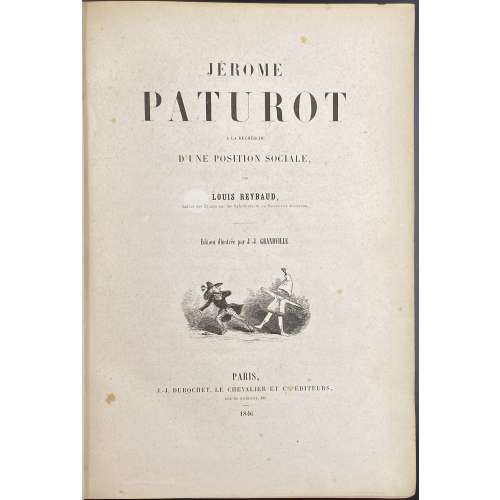 4to volume, ‘cartonnage percaline romantique’, 27.5 x 19.5 cm, green cloth with gilt fillet border and fictional coat of arms to front, border and fleuron to back, gilt and embossed vignette to spine, yellow endpapers, all edges gilt, 32 plates, incl. frontispiece, with tissue guards, and numerous in-text woodcuts after J.-J. Grandville by various engravers, mostly by Best, Leloir, Hotelin et Régnier group. Page 102 is numbered correctly. Title-page: JÉROME | PATUROT | A LA RECHERCHE | D'UNE POSITION SOCIALE | PAR | LOUIS REYBAUD, | Auteur des Études sur les Reformateurs ou Socialistes modernes. | — | Édition illustrée par J.-J. Grandville. | {vignette} | PARIS, | J.-J. DUBOCHET, LE CHEVALIER ET Cie, ÉDITEURS, | RUE DE RICHELIEU, 60. | – | 1846 || Collation: π4 1-574 582; total 234 leaves plus 32 wood-engraved plates extraneous to collation. Pagination: [8] [1] 2-460; total 468 pages, ils. Catalogue raisonné: L. Carteret 516; Ray 197 (pp. 277-8); Brivois: 350-1. Contributors: Louis Reybaud [Jérôme Paturot] (French, 1799 – 1879) – author. J.-J. Grandville [Isidore-Adolphe Gèrard] (French, 1803 – 1847) – artist. Schneider et Legrand (Paris) – printer. J.-J. Dubochet, Le Chevalier et Cie – publsiher. Engravers: Lucjan Stypulkowski (Polish, 1806 – 1849) Best, Leloir, Hotelin et Régnier Jean Baptiste Best (French, 1808 – 1879) or Adolphe Best (French, 1808 – 1860) Isidore Leloir (French, 1806 – 1851) Laurent Éloi Hotelin (French, 1821 – 1894) Eugène Laurent Isidore Régnier (?)
4to volume, ‘cartonnage percaline romantique’, 27.5 x 19.5 cm, green cloth with gilt fillet border and fictional coat of arms to front, border and fleuron to back, gilt and embossed vignette to spine, yellow endpapers, all edges gilt, 32 plates, incl. frontispiece, with tissue guards, and numerous in-text woodcuts after J.-J. Grandville by various engravers, mostly by Best, Leloir, Hotelin et Régnier group. Page 102 is numbered correctly. Title-page: JÉROME | PATUROT | A LA RECHERCHE | D'UNE POSITION SOCIALE | PAR | LOUIS REYBAUD, | Auteur des Études sur les Reformateurs ou Socialistes modernes. | — | Édition illustrée par J.-J. Grandville. | {vignette} | PARIS, | J.-J. DUBOCHET, LE CHEVALIER ET Cie, ÉDITEURS, | RUE DE RICHELIEU, 60. | – | 1846 || Collation: π4 1-574 582; total 234 leaves plus 32 wood-engraved plates extraneous to collation. Pagination: [8] [1] 2-460; total 468 pages, ils. Catalogue raisonné: L. Carteret 516; Ray 197 (pp. 277-8); Brivois: 350-1. Contributors: Louis Reybaud [Jérôme Paturot] (French, 1799 – 1879) – author. J.-J. Grandville [Isidore-Adolphe Gèrard] (French, 1803 – 1847) – artist. Schneider et Legrand (Paris) – printer. J.-J. Dubochet, Le Chevalier et Cie – publsiher. Engravers: Lucjan Stypulkowski (Polish, 1806 – 1849) Best, Leloir, Hotelin et Régnier Jean Baptiste Best (French, 1808 – 1879) or Adolphe Best (French, 1808 – 1860) Isidore Leloir (French, 1806 – 1851) Laurent Éloi Hotelin (French, 1821 – 1894) Eugène Laurent Isidore Régnier (?) -
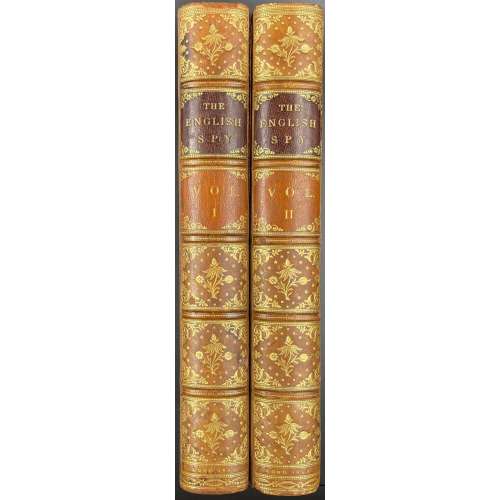 Two volumes 23.2 x 15.6 cm, uniformly bound in full polished calf by Riviere and Son (signed on fep verso), boards with triple gilt fillet border, spine with raised bands, gilt in compartments, gilt-lettered labels; dark blue endpapers, armorial bookplate of William Jennings with the motto “Honor Virtutis Premium” to front pastedown. Vol. 1: THE | ENGLISH SPY: | An Original Work | CHARACTERISTIC, SATIRICAL, AND | HUMOROUS. | COMPRISING | SCENES AND SKETCHES IN EVERY RANK OF SOCIETY, | BEING | PORTRAITS | OF THE | Illustrious, Eminent, Eccentric, and Notorious. | DRAWN FROM THE LIFE | BY BERNARD BLACKMANTLE. | THE ILLUSTRATIONS | DESIGNED BY | ROBERT CRUIKSHANK. | {vignette w/inscription: ‘By Frolic, Mirth, and Fancy gay, | Old Father Time is borne away.’ | — | LONDON : | PUBLISHED BY SHERWOOD, JONES, AND CO. | PATERNOSTER-ROW. | – | 1825. || Collation: [a]8 b4 B-H8 I4 K2 L-Z8 2A-2E8 2F3; total 221 leaves Pagination: [i-iii] iv-xxiii [xxiv] [1-3] 4-417 [418]; total 442 pages. Illustrations: 35 coloured plates, 1 uncoloured plate, and 29 woodcuts in text, incl vignette on title, all but four by Robert Cruikshank, 1 by G. M.B rightly (p. 335), 1 by T. Wageman (p. 413), and 2 by T. Rowlandson (pp. 411 and 416) Vol. 2: THE | ENGLISH SPY: | An Original Work | CHARACTERISTIC, SATIRICAL, AND | HUMOROUS. | COMPRISING | SCENES AND SKETCHES IN EVERY RANK OF SOCIETY, | BEING | PORTRAITS | OF THE | Illustrious, Eminent, Eccentric, and Notorious. | DRAWN FROM THE LIFE | BY BERNARD BLACKMANTLE. | THE ILLUSTRATIONS | DESIGNED BY | ROBERT CRUIKSHANK. | — | VOL. II. | — | {vignette w/inscription: ‘By Frolic, Mirth, and Fancy gay, | Old Father Time is borne away.’ | — | LONDON : | PUBLISHED BY SHERWOOD, GILBERT, AND PIPER, | PATERNOSTER-ROW. | – | 1826. || Collation: [A]-Z8 2A-2C8; total 208 leaves. [i-iii] iv-xv [xvi] [1-3] 4-399 [400]; total 416 pages. Illustrations: 36 coloured plates and 25 woodcuts in text. Catalogue raisonné: Martin-Hardie pp. 191-2; Tooley pp. 266-9; Abbey 325, pp.272-4 (see reflections regarding the ‘first issue’). Contributors: Charles Molloy Westmacott (British, c. 1788 – 1868) – author. Isaac Robert Cruikshank (British, 1789 – 1856) – artist, engraver. G. M. Brightly (British, fl. 1809 – 1827) – artist, engraver. Thomas Charles Wageman (British, 1787-1868) – artist, engraver Thomas Rowlandson (British, 1757 – 1827) – artist. Thomas Davison (British, 1794 – 1826) – printer. Sherwood, Jones, and Co. (London) – publisher. Sherwood, Gilbert, and Piper (London) – publisher. William Jennings – provenance
Two volumes 23.2 x 15.6 cm, uniformly bound in full polished calf by Riviere and Son (signed on fep verso), boards with triple gilt fillet border, spine with raised bands, gilt in compartments, gilt-lettered labels; dark blue endpapers, armorial bookplate of William Jennings with the motto “Honor Virtutis Premium” to front pastedown. Vol. 1: THE | ENGLISH SPY: | An Original Work | CHARACTERISTIC, SATIRICAL, AND | HUMOROUS. | COMPRISING | SCENES AND SKETCHES IN EVERY RANK OF SOCIETY, | BEING | PORTRAITS | OF THE | Illustrious, Eminent, Eccentric, and Notorious. | DRAWN FROM THE LIFE | BY BERNARD BLACKMANTLE. | THE ILLUSTRATIONS | DESIGNED BY | ROBERT CRUIKSHANK. | {vignette w/inscription: ‘By Frolic, Mirth, and Fancy gay, | Old Father Time is borne away.’ | — | LONDON : | PUBLISHED BY SHERWOOD, JONES, AND CO. | PATERNOSTER-ROW. | – | 1825. || Collation: [a]8 b4 B-H8 I4 K2 L-Z8 2A-2E8 2F3; total 221 leaves Pagination: [i-iii] iv-xxiii [xxiv] [1-3] 4-417 [418]; total 442 pages. Illustrations: 35 coloured plates, 1 uncoloured plate, and 29 woodcuts in text, incl vignette on title, all but four by Robert Cruikshank, 1 by G. M.B rightly (p. 335), 1 by T. Wageman (p. 413), and 2 by T. Rowlandson (pp. 411 and 416) Vol. 2: THE | ENGLISH SPY: | An Original Work | CHARACTERISTIC, SATIRICAL, AND | HUMOROUS. | COMPRISING | SCENES AND SKETCHES IN EVERY RANK OF SOCIETY, | BEING | PORTRAITS | OF THE | Illustrious, Eminent, Eccentric, and Notorious. | DRAWN FROM THE LIFE | BY BERNARD BLACKMANTLE. | THE ILLUSTRATIONS | DESIGNED BY | ROBERT CRUIKSHANK. | — | VOL. II. | — | {vignette w/inscription: ‘By Frolic, Mirth, and Fancy gay, | Old Father Time is borne away.’ | — | LONDON : | PUBLISHED BY SHERWOOD, GILBERT, AND PIPER, | PATERNOSTER-ROW. | – | 1826. || Collation: [A]-Z8 2A-2C8; total 208 leaves. [i-iii] iv-xv [xvi] [1-3] 4-399 [400]; total 416 pages. Illustrations: 36 coloured plates and 25 woodcuts in text. Catalogue raisonné: Martin-Hardie pp. 191-2; Tooley pp. 266-9; Abbey 325, pp.272-4 (see reflections regarding the ‘first issue’). Contributors: Charles Molloy Westmacott (British, c. 1788 – 1868) – author. Isaac Robert Cruikshank (British, 1789 – 1856) – artist, engraver. G. M. Brightly (British, fl. 1809 – 1827) – artist, engraver. Thomas Charles Wageman (British, 1787-1868) – artist, engraver Thomas Rowlandson (British, 1757 – 1827) – artist. Thomas Davison (British, 1794 – 1826) – printer. Sherwood, Jones, and Co. (London) – publisher. Sherwood, Gilbert, and Piper (London) – publisher. William Jennings – provenance -
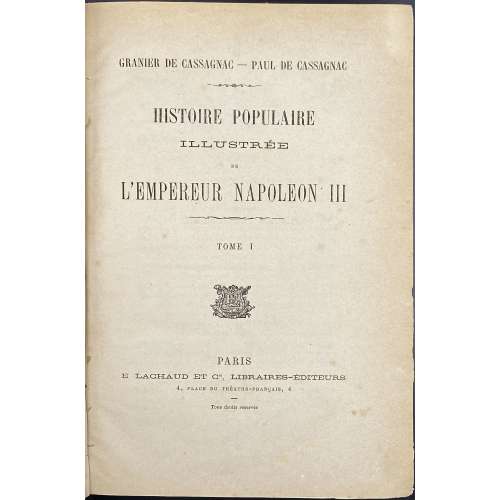 Hardcover, 28 x 20 cm, quarter sheepskin over marbled boards, marbled endpapers, gilt lettering to flat spine with gilt fillet bands, clipping pasted to front fep verso. Title-page: GRANIER DE CASSAGNAC — PAUL DE CASSAGNAC | ~ | HISTOIRE POPULAIRE | ILLUSTRÉE | DE | L'EMPEREUR NAPOLEON III | TOME I (II) | {publisher’s device} | PARIS | E. LACHAUD ET Cie, LIBRAIRES-ÉDITEURS | 4, PLACE DU THÉATRE-FRANÇAIS, 4 | – | Tous droits réservés || Collation: (v.1) π2 [1]-504, (v.2) π2 1-494; total 400 leaves plus albumen photograph pasted to frontispiece and 96 full-page woodcuts within collation. Pagination: [4] [1] 2-398 [2], [4] [1] 2-390 [2], ils.; total 800 pp. Contributors: Bernard Adolphe Granier de Cassagnac (French, 1806 – 1880) – father. Paul Adolphe Marie Prosper Granier de Cassagnac (French, 1843 – 1904) – son.
Hardcover, 28 x 20 cm, quarter sheepskin over marbled boards, marbled endpapers, gilt lettering to flat spine with gilt fillet bands, clipping pasted to front fep verso. Title-page: GRANIER DE CASSAGNAC — PAUL DE CASSAGNAC | ~ | HISTOIRE POPULAIRE | ILLUSTRÉE | DE | L'EMPEREUR NAPOLEON III | TOME I (II) | {publisher’s device} | PARIS | E. LACHAUD ET Cie, LIBRAIRES-ÉDITEURS | 4, PLACE DU THÉATRE-FRANÇAIS, 4 | – | Tous droits réservés || Collation: (v.1) π2 [1]-504, (v.2) π2 1-494; total 400 leaves plus albumen photograph pasted to frontispiece and 96 full-page woodcuts within collation. Pagination: [4] [1] 2-398 [2], [4] [1] 2-390 [2], ils.; total 800 pp. Contributors: Bernard Adolphe Granier de Cassagnac (French, 1806 – 1880) – father. Paul Adolphe Marie Prosper Granier de Cassagnac (French, 1843 – 1904) – son. -
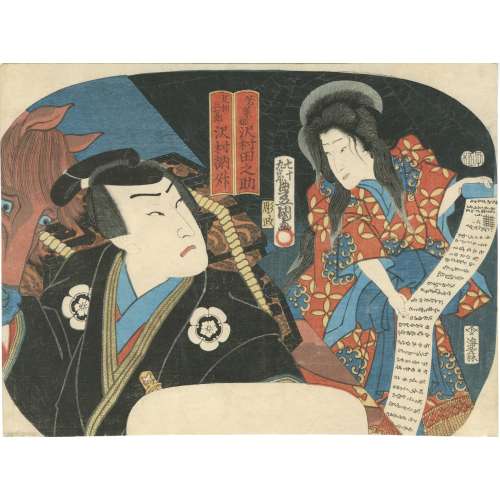 Artist: Utagawa Kunisada [歌川 国貞] a.k.a. Utagawa Toyokuni III [三代歌川豊国] (Japanese, 1786 – 1865). Artist signature: By the brush of the 79-year-old Toyokuni [七十九歳豊國画] (Nanajūkyū-sai Toyokuni ga). Publisher: Ebiya Rinnosuke [海老屋林之助] (Japanese, fl. c. 1832 – 1895); seal: ト/ 海老林 (to, Ebirin). Block carver: Matsushima Masakichi [松島政吉]; seal: carved by Masa [彫政] (Hori Masa). Combined date seal and kiwame censor seal: [子極] 1864 (Bunkyū 4/Genji 1). Media: Untrimmed fan print (uchiwa-e), 223 x 297 mm. Inscription in the cartouches: (R) Wakana-hime [若菜姫], Sawamura Tanosuke III [沢村田之助]; (L) Ashikaga Sanshichirō [足利三七郎], Sawamura Tosshō II [沢村訥升]. Play: Kinoene Soga Daikoku-bashira [甲子曽我大国柱], performed at the Morita theatre [森田座・守田座] (Morita-za) in 1864 (Bunkyū 4/Genji 1), 2nd month (see playbill at MFA-Boston Collection). Playwright: Muraoka Kōji II [村岡幸治]. Actors and Characters: Sawamura Tanosuke III [三代目沢村田之助] (Japanese, 1859 – 1878); other names: Shozan [曙山] (poetry name), Sawamura Yoshijirō I [初代沢村由次郎], here in the role of Princess Wakana [若菜姫] (Wakana-hime) (R). The story about Princess Wakana, Shiranui Monogatari, was written by Ryukatei Tanekazu [柳下亭種員] (Japanese, 1807 – 1858) and published as a 90-volume book of comics between 1849 and 1855. ...The tale revolves around the clash between the Kikuchi and Ōtomo clans. Princess Wakana’s father Ōtomo Sōrin [大友 宗麟] (1530 – 1587) was killed in a battle, and his spirit demanded revenge. To appease her late father's spirit, Princes Wakana acquired the power of the Earth Spider. She often appears in prints with a magic scroll, which helps her fight various enemies. Sawamura Tosshō II [二代目沢村訥升] (Japanese, 1854 – 1879); other names: Kōga [高賀] (poetry name), Sawamura Genpei II [二代目沢村源平], Sawamura Sōjūrō [澤村宗十郎], Suketakaya Takasuke IV [四代目助高屋高助], Sawamura Tosshi VI [六代目澤村訥子] (poetry name), here in the role of Ashikaga Sanshichirō [足利三七郎] (L) with a horse. According to Markus Sesko, the scene comes from the kabuki play Umakiri (馬斬り) by Tatsuoka Mansaku [辰岡万作] (17432 – 1809), which premiered in 1794. It was later assimilated into the Kabuki play Kozotte Mimasu Kuruwa no Datezome [襷廓三升伊達染], which was staged in the 1st lunar month of 1853 at the Nakamura-za. Umakiri is based on a Kyōgen play featured in Hideyoshi’s biography Taikōki [太閤記]. Its plot is that Ashikaga Sanchichirō Yoshitaka [足利三七郎義孝・義高], who is supposed to allude to Nobunaga’s son Oda Sanshichirō Nobutaka [織田三七郎信孝], attacks and kills a horse that is carrying 3,000 ryō (金三千両), money Mashiba Hisayoshi [真柴久吉] (an allusion to Hashiba Hideyoshi [羽柴秀吉]) had sent to be donated to a shrine on Mt. Kōya. The surrounding people try to catch him, but when they hear it is Yoshitaka who killed the horse, they fall to the ground and prostrate, and Yoshitaka leisurely leaves with the money. The plot is very simple, but Yoshitaka’s dashing appearance makes it very pleasing to watch. There are also prints that quote the main protagonist as Ashikaga Sanshichirō Harutaka [足利三七郎春高], and there is another title for the play, Sanzen-Ryō Kogane no Kurairi [三千両黄金蔵入] (Pocketing 3,000 ryō of gold). For reference, see also the BLOG. What these two characters are doing in one play remains a riddle. As Mr Graebner comments: "Most kabuki plays were only performed for one season (two months), and the books were lost. The playwrights have repeatedly used parts of plots from other plays, they have adopted characters, sometimes with the same or similar names. What can be found is the Kabuki Playbill (Tsuji banzuke) with cast and roles; the content is lost". Acknowledgements: Special thanks to Horst Graebner of the Kunisada Project and to Markus Sesko of The Metropolitan Museum, NY, for the analysis of the image and their invaluable contribution. For reference, see also:
Artist: Utagawa Kunisada [歌川 国貞] a.k.a. Utagawa Toyokuni III [三代歌川豊国] (Japanese, 1786 – 1865). Artist signature: By the brush of the 79-year-old Toyokuni [七十九歳豊國画] (Nanajūkyū-sai Toyokuni ga). Publisher: Ebiya Rinnosuke [海老屋林之助] (Japanese, fl. c. 1832 – 1895); seal: ト/ 海老林 (to, Ebirin). Block carver: Matsushima Masakichi [松島政吉]; seal: carved by Masa [彫政] (Hori Masa). Combined date seal and kiwame censor seal: [子極] 1864 (Bunkyū 4/Genji 1). Media: Untrimmed fan print (uchiwa-e), 223 x 297 mm. Inscription in the cartouches: (R) Wakana-hime [若菜姫], Sawamura Tanosuke III [沢村田之助]; (L) Ashikaga Sanshichirō [足利三七郎], Sawamura Tosshō II [沢村訥升]. Play: Kinoene Soga Daikoku-bashira [甲子曽我大国柱], performed at the Morita theatre [森田座・守田座] (Morita-za) in 1864 (Bunkyū 4/Genji 1), 2nd month (see playbill at MFA-Boston Collection). Playwright: Muraoka Kōji II [村岡幸治]. Actors and Characters: Sawamura Tanosuke III [三代目沢村田之助] (Japanese, 1859 – 1878); other names: Shozan [曙山] (poetry name), Sawamura Yoshijirō I [初代沢村由次郎], here in the role of Princess Wakana [若菜姫] (Wakana-hime) (R). The story about Princess Wakana, Shiranui Monogatari, was written by Ryukatei Tanekazu [柳下亭種員] (Japanese, 1807 – 1858) and published as a 90-volume book of comics between 1849 and 1855. ...The tale revolves around the clash between the Kikuchi and Ōtomo clans. Princess Wakana’s father Ōtomo Sōrin [大友 宗麟] (1530 – 1587) was killed in a battle, and his spirit demanded revenge. To appease her late father's spirit, Princes Wakana acquired the power of the Earth Spider. She often appears in prints with a magic scroll, which helps her fight various enemies. Sawamura Tosshō II [二代目沢村訥升] (Japanese, 1854 – 1879); other names: Kōga [高賀] (poetry name), Sawamura Genpei II [二代目沢村源平], Sawamura Sōjūrō [澤村宗十郎], Suketakaya Takasuke IV [四代目助高屋高助], Sawamura Tosshi VI [六代目澤村訥子] (poetry name), here in the role of Ashikaga Sanshichirō [足利三七郎] (L) with a horse. According to Markus Sesko, the scene comes from the kabuki play Umakiri (馬斬り) by Tatsuoka Mansaku [辰岡万作] (17432 – 1809), which premiered in 1794. It was later assimilated into the Kabuki play Kozotte Mimasu Kuruwa no Datezome [襷廓三升伊達染], which was staged in the 1st lunar month of 1853 at the Nakamura-za. Umakiri is based on a Kyōgen play featured in Hideyoshi’s biography Taikōki [太閤記]. Its plot is that Ashikaga Sanchichirō Yoshitaka [足利三七郎義孝・義高], who is supposed to allude to Nobunaga’s son Oda Sanshichirō Nobutaka [織田三七郎信孝], attacks and kills a horse that is carrying 3,000 ryō (金三千両), money Mashiba Hisayoshi [真柴久吉] (an allusion to Hashiba Hideyoshi [羽柴秀吉]) had sent to be donated to a shrine on Mt. Kōya. The surrounding people try to catch him, but when they hear it is Yoshitaka who killed the horse, they fall to the ground and prostrate, and Yoshitaka leisurely leaves with the money. The plot is very simple, but Yoshitaka’s dashing appearance makes it very pleasing to watch. There are also prints that quote the main protagonist as Ashikaga Sanshichirō Harutaka [足利三七郎春高], and there is another title for the play, Sanzen-Ryō Kogane no Kurairi [三千両黄金蔵入] (Pocketing 3,000 ryō of gold). For reference, see also the BLOG. What these two characters are doing in one play remains a riddle. As Mr Graebner comments: "Most kabuki plays were only performed for one season (two months), and the books were lost. The playwrights have repeatedly used parts of plots from other plays, they have adopted characters, sometimes with the same or similar names. What can be found is the Kabuki Playbill (Tsuji banzuke) with cast and roles; the content is lost". Acknowledgements: Special thanks to Horst Graebner of the Kunisada Project and to Markus Sesko of The Metropolitan Museum, NY, for the analysis of the image and their invaluable contribution. For reference, see also: -
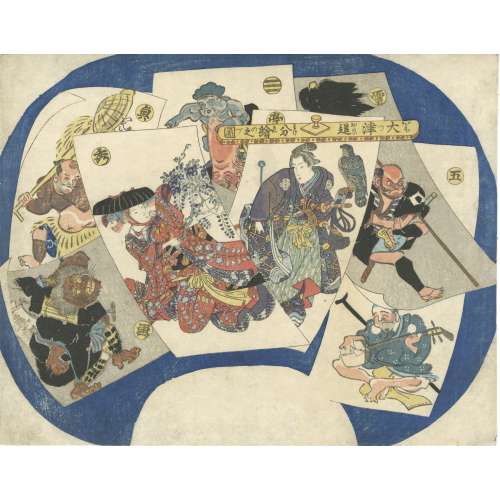 An uncut fan print showing Otsu-e [大津絵] (Otsu pictures). Artist: Utagawa Sadahide [歌川貞秀] (Japanese, 1807 – 1879). Signed: Gountei Sadahide ga [五雲亭貞秀画] (Picture by Gountei Sadahide); characters on the Otsu-e. Publisher: Ibaya Senzaburō [伊場屋仙三郎] (Japanese, c. 1815 – 1869). Published: c. 1849. Inscription in a paper-weight shaped cartouche: [大津追 分絵の図] Ōtsu-oi wake-e no zu (Following Otsu – image of separate pictures) No date seal, no censor seal (privately printed?) Media: Fan print (uchiwa-e, 団扇絵), 235 x 298 mm.
An uncut fan print showing Otsu-e [大津絵] (Otsu pictures). Artist: Utagawa Sadahide [歌川貞秀] (Japanese, 1807 – 1879). Signed: Gountei Sadahide ga [五雲亭貞秀画] (Picture by Gountei Sadahide); characters on the Otsu-e. Publisher: Ibaya Senzaburō [伊場屋仙三郎] (Japanese, c. 1815 – 1869). Published: c. 1849. Inscription in a paper-weight shaped cartouche: [大津追 分絵の図] Ōtsu-oi wake-e no zu (Following Otsu – image of separate pictures) No date seal, no censor seal (privately printed?) Media: Fan print (uchiwa-e, 団扇絵), 235 x 298 mm. -
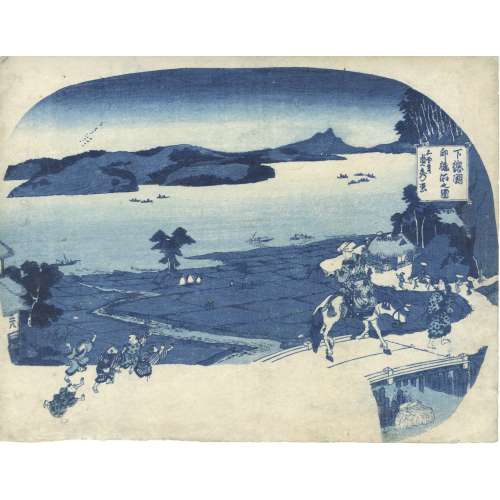 An uncut aizuri fan print showing travellers arriving at Inba Lake [印旛沼] (Inba-numa) on Shimosa Plateau [下総台地] (Shimōsa-daichi). Artist: Utagawa Sadahide [歌川貞秀] (Japanese, 1807 – 1879) Publisher: Unknown. Published: c. 1849. Signed: Gountei Sadahide ga [五雲亭 貞秀画] (Picture by Gountei Sadahide). Inscription in cartouche: Shimosa Plateau, Inbanuma (Inba Lake) [下總國印幡沼]. No date seal, no censor seal (privately printed?) Media: Fan print [団扇絵] (uchiwa-e), 235 x 300 mm.
An uncut aizuri fan print showing travellers arriving at Inba Lake [印旛沼] (Inba-numa) on Shimosa Plateau [下総台地] (Shimōsa-daichi). Artist: Utagawa Sadahide [歌川貞秀] (Japanese, 1807 – 1879) Publisher: Unknown. Published: c. 1849. Signed: Gountei Sadahide ga [五雲亭 貞秀画] (Picture by Gountei Sadahide). Inscription in cartouche: Shimosa Plateau, Inbanuma (Inba Lake) [下總國印幡沼]. No date seal, no censor seal (privately printed?) Media: Fan print [団扇絵] (uchiwa-e), 235 x 300 mm. -
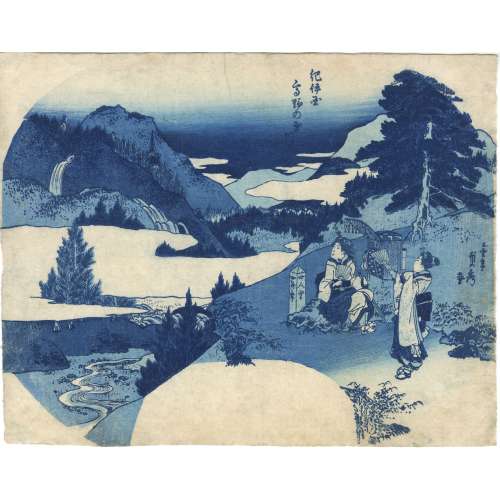 An uncut aizuri fan print showing two travellers admiring the view of the Tama River [多摩川] (Tamagawa) and Mount Kōya [高野山] (Kōyasan) in Kii Province [紀伊国] (Kii no Kuni). Artist: Utagawa Sadahide [歌川貞秀] (Japanese, 1807 – 1879). Signed: Gountei Sadahide ga [五雲亭貞秀画] (Picture by Gountei Sadahide). Publisher: Unknown. Published: c. 1849. No date seal, no censor seal (privately printed?) Media: Fan print [団扇絵] (uchiwa-e), 235 x 300 mm.
An uncut aizuri fan print showing two travellers admiring the view of the Tama River [多摩川] (Tamagawa) and Mount Kōya [高野山] (Kōyasan) in Kii Province [紀伊国] (Kii no Kuni). Artist: Utagawa Sadahide [歌川貞秀] (Japanese, 1807 – 1879). Signed: Gountei Sadahide ga [五雲亭貞秀画] (Picture by Gountei Sadahide). Publisher: Unknown. Published: c. 1849. No date seal, no censor seal (privately printed?) Media: Fan print [団扇絵] (uchiwa-e), 235 x 300 mm. -
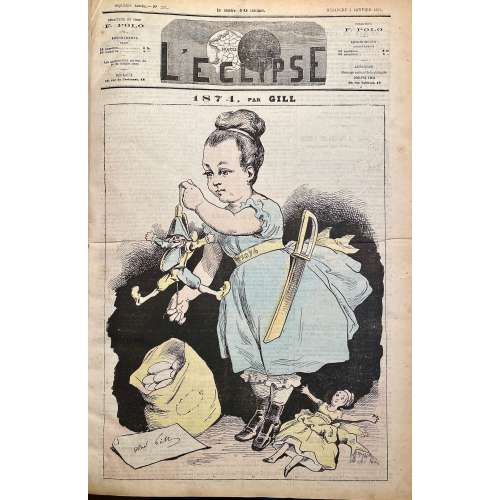 129 issues of L'Éclipse, French weekly political magazine; published in Paris, 49 x 34 cm, bound in rebacked green quarter morocco over marbled boards, with gilt fillets and lettering to spine, peacock marbled endpapers, illustrated by André Gill (French, 1840 – 1885). Founder and editor-in-chief François Polo (French, 1838 – 1874). 1874: 271-322 (52 issues) 1875: 323-374 (52 issues) 1876: 375-399 (25 issues)
129 issues of L'Éclipse, French weekly political magazine; published in Paris, 49 x 34 cm, bound in rebacked green quarter morocco over marbled boards, with gilt fillets and lettering to spine, peacock marbled endpapers, illustrated by André Gill (French, 1840 – 1885). Founder and editor-in-chief François Polo (French, 1838 – 1874). 1874: 271-322 (52 issues) 1875: 323-374 (52 issues) 1876: 375-399 (25 issues) -
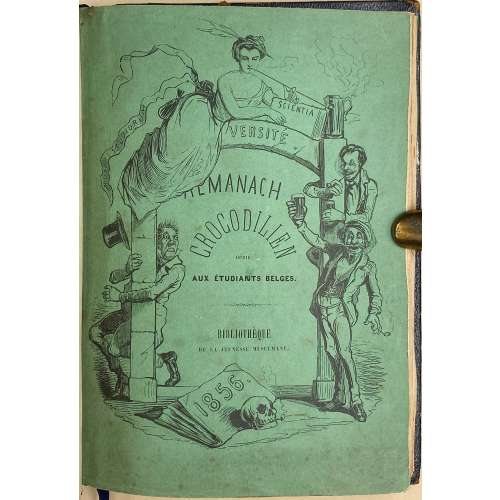 One volume collated 8vo, 19 x 14 cm, bound in black alligator leather. Front wrapper (green) / title-page (white): A female figure smoking a pipe next to a beer mug, reclining over an arch ring lettered “…VERSITÉ” (UNI… not shown), her dress ribbon lettered “MUSA STUDIORUM”, holding a book lettered “SCIENTIA”; within the arch « ALMANACH | CROCODILIEN | DÉDIÉ | AUX ÉTUDIANTS BELGES. | BIBLIOTHÈQUE | DE LA JEUNESSE MUSULMANE. »; below lies a book lettered “1856.”, next to it is a smoking skull; three male figures embracing the arch columns. Half-title: ALMANACH CROCODILIEN | POUR | L’ANNÉE BISSEXTILE, MAIS NÉANMOINS DE GRACE | 1856. || Pagination: [1-5] 6-14 [15-41] 42-134 [137] 138, total 136 pages within the wrappers, original publisher's green wrappers preserved, carte de visite ‘Félicien Rops, Étudiant’ and pink invitation card № 129 for ‘Bal des femmes’ on March 19, 1892 at ‘Fête annuelle du Courier Français’ bound in; in-text woodcuts, initials, head- and tail-pieces after Félicien Rops. Bookplate “Ex Libris Marcellus Schlimovich” with motto “Ars naturam adiuvat” on front pastedown. Stamp of the "Sociedad Hebraica Argentina / Coleccion M. Schlimovich / Varios / No. 2-492” to half-title. Pencil inscription to half-title: "Ex. Félicien Rops" – possibly an own copy of the artist. Collation: π2 1-88 92, total 68 leaves within wrappers. Printer: Typ. de J. Vanbuggenhoudt (Bruxelles). Sociedad Hebraica Argentina; Marcelo Schlimovich (Argentine-Jewish, ca. 1880 – 1960) – provenance. Félicien Rops (Belgian, 1833 – 1898) – artist.
One volume collated 8vo, 19 x 14 cm, bound in black alligator leather. Front wrapper (green) / title-page (white): A female figure smoking a pipe next to a beer mug, reclining over an arch ring lettered “…VERSITÉ” (UNI… not shown), her dress ribbon lettered “MUSA STUDIORUM”, holding a book lettered “SCIENTIA”; within the arch « ALMANACH | CROCODILIEN | DÉDIÉ | AUX ÉTUDIANTS BELGES. | BIBLIOTHÈQUE | DE LA JEUNESSE MUSULMANE. »; below lies a book lettered “1856.”, next to it is a smoking skull; three male figures embracing the arch columns. Half-title: ALMANACH CROCODILIEN | POUR | L’ANNÉE BISSEXTILE, MAIS NÉANMOINS DE GRACE | 1856. || Pagination: [1-5] 6-14 [15-41] 42-134 [137] 138, total 136 pages within the wrappers, original publisher's green wrappers preserved, carte de visite ‘Félicien Rops, Étudiant’ and pink invitation card № 129 for ‘Bal des femmes’ on March 19, 1892 at ‘Fête annuelle du Courier Français’ bound in; in-text woodcuts, initials, head- and tail-pieces after Félicien Rops. Bookplate “Ex Libris Marcellus Schlimovich” with motto “Ars naturam adiuvat” on front pastedown. Stamp of the "Sociedad Hebraica Argentina / Coleccion M. Schlimovich / Varios / No. 2-492” to half-title. Pencil inscription to half-title: "Ex. Félicien Rops" – possibly an own copy of the artist. Collation: π2 1-88 92, total 68 leaves within wrappers. Printer: Typ. de J. Vanbuggenhoudt (Bruxelles). Sociedad Hebraica Argentina; Marcelo Schlimovich (Argentine-Jewish, ca. 1880 – 1960) – provenance. Félicien Rops (Belgian, 1833 – 1898) – artist. -
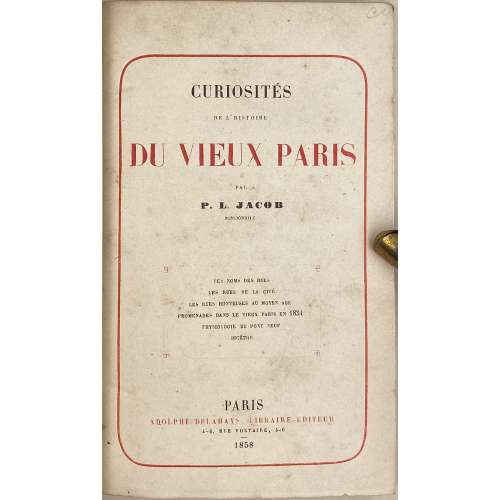 Title-page: CURIOSITÉS | DE L’HISTOIRE | DU VIEUX PARIS | PAR | P. L. JACOB | BIBLIOPHILE | { LES NOMS DES RUES | LES RUES DE CITÉ | LES RUES HONTEUSES AU MOYEN AGE. | PROMENADES DANS LE VIEUX PARIS EN 1834. | PHYSIOLOGIE DU PONT NEUF. | BICÊTRE } | PARIS | ADOLPHE DELAHAYS, LIBRAIRE-ÉDITEUR | 4-6, RUE VOLTAIRE, 4-6 | – | 1858 || Description: Hardcover, in-16o, 17 x 11 cm, quarter brown morocco over marbled boards, spine with raised bands, gilt lettering, gilt fleurons, marbled endpapers, original wrappers with red and black lettering within red frame bound in, some pages uncut. Collation: 8vo; π2 14, 2-238 244, total 186 leaves between original wrappers. Pagination: [4] [1] 2-364 [4], total 372 pages. Catalogue raisonné: Vicar: I, 770. Contributors: Printer: Simon Raçon et Comp. (Paris). Author: Paul Lacroix [P. L. Jacob] (French, 1806 – 1884). Publisher: Adolphe Delahays (French, mid-19th century).
Title-page: CURIOSITÉS | DE L’HISTOIRE | DU VIEUX PARIS | PAR | P. L. JACOB | BIBLIOPHILE | { LES NOMS DES RUES | LES RUES DE CITÉ | LES RUES HONTEUSES AU MOYEN AGE. | PROMENADES DANS LE VIEUX PARIS EN 1834. | PHYSIOLOGIE DU PONT NEUF. | BICÊTRE } | PARIS | ADOLPHE DELAHAYS, LIBRAIRE-ÉDITEUR | 4-6, RUE VOLTAIRE, 4-6 | – | 1858 || Description: Hardcover, in-16o, 17 x 11 cm, quarter brown morocco over marbled boards, spine with raised bands, gilt lettering, gilt fleurons, marbled endpapers, original wrappers with red and black lettering within red frame bound in, some pages uncut. Collation: 8vo; π2 14, 2-238 244, total 186 leaves between original wrappers. Pagination: [4] [1] 2-364 [4], total 372 pages. Catalogue raisonné: Vicar: I, 770. Contributors: Printer: Simon Raçon et Comp. (Paris). Author: Paul Lacroix [P. L. Jacob] (French, 1806 – 1884). Publisher: Adolphe Delahays (French, mid-19th century). -
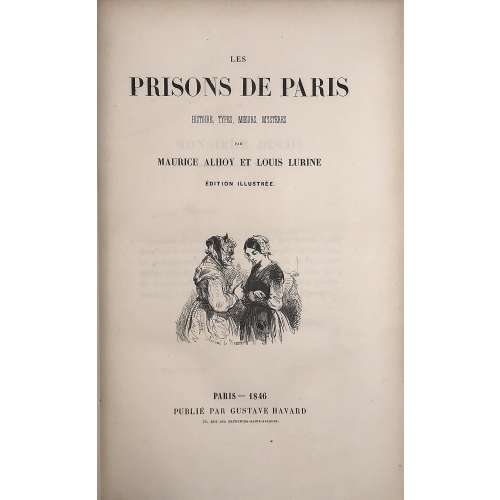 Exterior: 4to, 27.3 x 18 cm, quarter black morocco over marbled boards, double gilt fillet border, spine with raised bands, compartments framed in gilt with gilt fleurons, black label lettered in gilt; marbled endpapers. Inscription to half-title in the bottom: no 411. Bookplate to front pastedown. Title-page: LES | PRISONS DE PARIS | HISTOIRE, TYPES, MŒURS, MYSTÈRES | PAR | MAURICE ALHOY ET LOUIS LURINE | ÉDITION ILLUSTRÉE. | {vignette} | PARIS — 1846 | PUBLIÉ PAR GUSTAVE HAVARD | 24, RUE DES MATHURINS-SAINT-JACQUES. || Printer: Lacrampe et Comp. Collation: 4to; π2 a4 1-684 χ2; total 280 leaves and 34 leaves of plates. Pagination: first and last leaves blank; [2 -h.t./imprint.] [2 - t.p./blank] [2 dedication/blank] [i intro] ii-vi, [1] 2-544 [2 - list of plates/advert.] [2 - contents/blank]; total 560 pages, plus 34 wood-engraved plates, incl. a frontispiece by Laisne after Bertall, and numerous in-text woodcuts. Provenance: Bookplate of Selim Hippolyte Ansart (French, 1829 – 1897), commissar of police in the Second Empire and shortly after (chef de la police municipaie ; chevalier du 13 août 1867; vingt-trois ans de service effectif). Authors: Philadelphe-Maurice Alhoy (French, 1802 – 1856) Louis Lurine (French, 1812 – 1860) Artists: Bertall [ Bertal; Charles Albert d’Arnoux (French, 1820 – 1882) Jules [Jean-Baptiste] David (French, 1808–1892) Charles-François Pinot (French, 1817 – 1879) Eustache Lorsay [French, Eugène Lampsonius] (1822 – 1871) Pierre Édouard Frère (French, 1819 – 1886) Charles-Édouard de Beaumont (French, 1819 – 1888) Engravers Laisné Adèle / Aglaé / Alfred (French, fl. 1835 – 1868) Louis Dujardin (French, 1808 – 1859) François Rouget (Belgian, c. 1825 – ?) Janet-Lange [Ange-Louis Janet] (French, 1815 – 1872) Jacques Adrien Lavieille (French, 1818 – 1862) Timms (French, fl. c. 1839 – 1865) Félix Leblanc (French, 1823 – ?) Émile Montigneul (French, fl. 1840 – 1850)
Exterior: 4to, 27.3 x 18 cm, quarter black morocco over marbled boards, double gilt fillet border, spine with raised bands, compartments framed in gilt with gilt fleurons, black label lettered in gilt; marbled endpapers. Inscription to half-title in the bottom: no 411. Bookplate to front pastedown. Title-page: LES | PRISONS DE PARIS | HISTOIRE, TYPES, MŒURS, MYSTÈRES | PAR | MAURICE ALHOY ET LOUIS LURINE | ÉDITION ILLUSTRÉE. | {vignette} | PARIS — 1846 | PUBLIÉ PAR GUSTAVE HAVARD | 24, RUE DES MATHURINS-SAINT-JACQUES. || Printer: Lacrampe et Comp. Collation: 4to; π2 a4 1-684 χ2; total 280 leaves and 34 leaves of plates. Pagination: first and last leaves blank; [2 -h.t./imprint.] [2 - t.p./blank] [2 dedication/blank] [i intro] ii-vi, [1] 2-544 [2 - list of plates/advert.] [2 - contents/blank]; total 560 pages, plus 34 wood-engraved plates, incl. a frontispiece by Laisne after Bertall, and numerous in-text woodcuts. Provenance: Bookplate of Selim Hippolyte Ansart (French, 1829 – 1897), commissar of police in the Second Empire and shortly after (chef de la police municipaie ; chevalier du 13 août 1867; vingt-trois ans de service effectif). Authors: Philadelphe-Maurice Alhoy (French, 1802 – 1856) Louis Lurine (French, 1812 – 1860) Artists: Bertall [ Bertal; Charles Albert d’Arnoux (French, 1820 – 1882) Jules [Jean-Baptiste] David (French, 1808–1892) Charles-François Pinot (French, 1817 – 1879) Eustache Lorsay [French, Eugène Lampsonius] (1822 – 1871) Pierre Édouard Frère (French, 1819 – 1886) Charles-Édouard de Beaumont (French, 1819 – 1888) Engravers Laisné Adèle / Aglaé / Alfred (French, fl. 1835 – 1868) Louis Dujardin (French, 1808 – 1859) François Rouget (Belgian, c. 1825 – ?) Janet-Lange [Ange-Louis Janet] (French, 1815 – 1872) Jacques Adrien Lavieille (French, 1818 – 1862) Timms (French, fl. c. 1839 – 1865) Félix Leblanc (French, 1823 – ?) Émile Montigneul (French, fl. 1840 – 1850) -
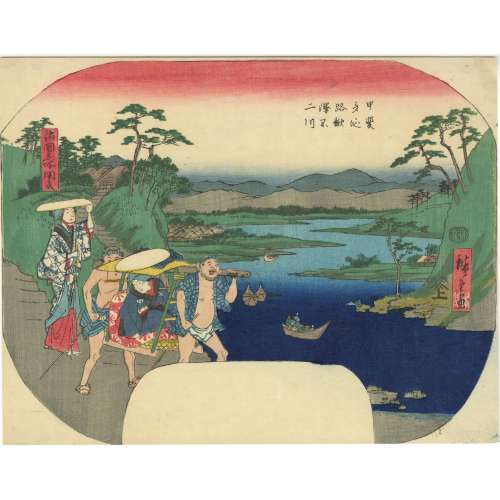 Artist: Utagawa Hiroshige II (二代目 歌川広重] (Japanese, 1826 – 1869). Signed: Hiroshige ga. Publisher: Iseya Sōemon [伊勢屋惣右衛門] (Japanese, c. 1776 – 1862); seal: Hanmoto, Ue [板元 上] (Marks 19-047 | 156d). Combined date seal and kiwame censor seal: Bunkyū 2 (1862) Media: Fan print (uchiwa-e, 団扇絵), 230 x 296 mm.
Artist: Utagawa Hiroshige II (二代目 歌川広重] (Japanese, 1826 – 1869). Signed: Hiroshige ga. Publisher: Iseya Sōemon [伊勢屋惣右衛門] (Japanese, c. 1776 – 1862); seal: Hanmoto, Ue [板元 上] (Marks 19-047 | 156d). Combined date seal and kiwame censor seal: Bunkyū 2 (1862) Media: Fan print (uchiwa-e, 団扇絵), 230 x 296 mm. -
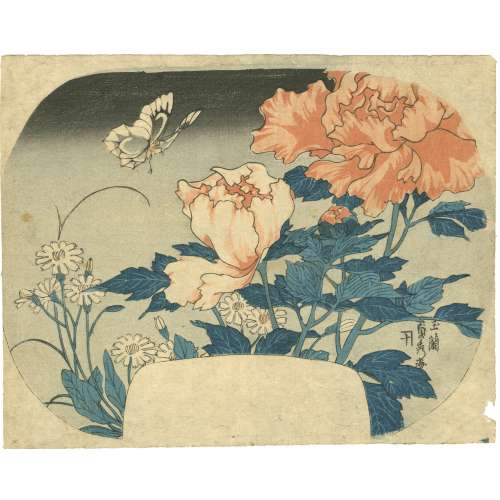 Artist: Utagawa Sadahide [歌川貞秀] (Japanese, 1807 – 1879) Publisher: Kojimaya Jūbei [小島屋重兵衛] (Japanese, c. 1797 – 1869) No date seal, no censor seal (privately printed?) Media: Fan print (uchiwa-e, 団扇絵), 235 x 297 mm. Kalimeris incisa, or Japanese Aster, is a daisy-like flower that belongs to the family of Asteraceae; it blossoms all summer and attracts butterflies. Peony [牡丹] (botan) – per Merrily Baird it is "the king of flowers", associated with erotic love, and especially with the sexual activities of women.
Artist: Utagawa Sadahide [歌川貞秀] (Japanese, 1807 – 1879) Publisher: Kojimaya Jūbei [小島屋重兵衛] (Japanese, c. 1797 – 1869) No date seal, no censor seal (privately printed?) Media: Fan print (uchiwa-e, 団扇絵), 235 x 297 mm. Kalimeris incisa, or Japanese Aster, is a daisy-like flower that belongs to the family of Asteraceae; it blossoms all summer and attracts butterflies. Peony [牡丹] (botan) – per Merrily Baird it is "the king of flowers", associated with erotic love, and especially with the sexual activities of women. -
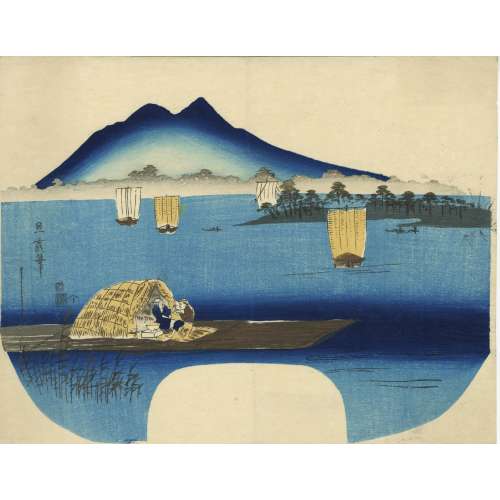 Artist: Tsukioka Tanka [旦霞] (Japanese, fl. c. 1830s – 1840s). Publisher: Enshūya Matabei [遠州屋又兵衛] (Japanese, fl. c. 1768 – 1881); seal: Enmata. Title: Picture of Fuji, Tsukuba and Sumida River [富士筑波隅田川の圖] (フジ ツクバ スミダガワ ノ ズ | Fuji Tsukuba Sumidagawa no zu). Date seal 巳 + kiwame: Tenpō 4 (1833). Media: Fan print (uchiwa-e, 団扇絵), 235 x 302 mm, aizuri-e. Only four prints are known from this artist, all fans: (1) National Diet Library 2542868:
Artist: Tsukioka Tanka [旦霞] (Japanese, fl. c. 1830s – 1840s). Publisher: Enshūya Matabei [遠州屋又兵衛] (Japanese, fl. c. 1768 – 1881); seal: Enmata. Title: Picture of Fuji, Tsukuba and Sumida River [富士筑波隅田川の圖] (フジ ツクバ スミダガワ ノ ズ | Fuji Tsukuba Sumidagawa no zu). Date seal 巳 + kiwame: Tenpō 4 (1833). Media: Fan print (uchiwa-e, 団扇絵), 235 x 302 mm, aizuri-e. Only four prints are known from this artist, all fans: (1) National Diet Library 2542868:
(2) Ritsumeikan University mai30_07: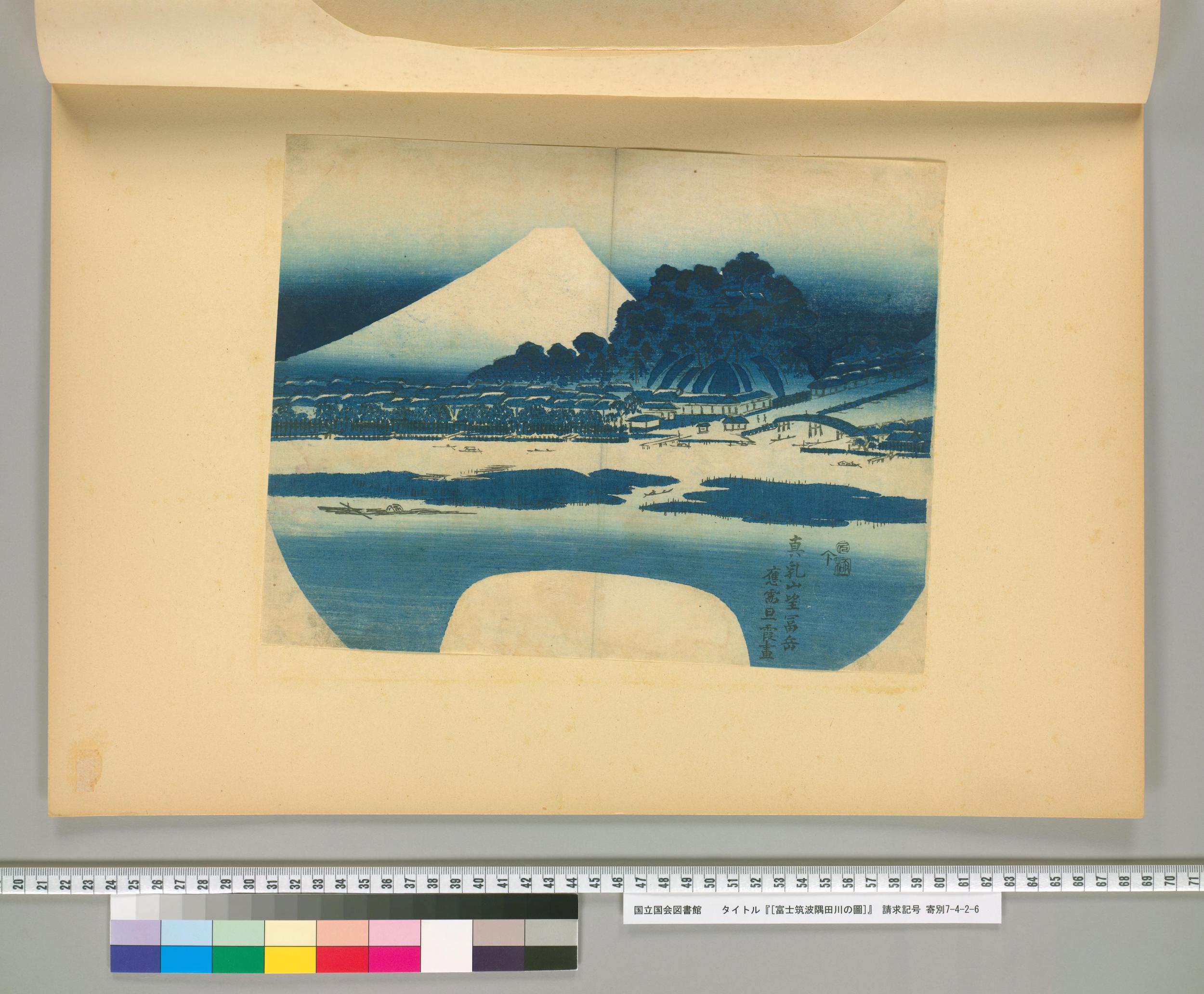
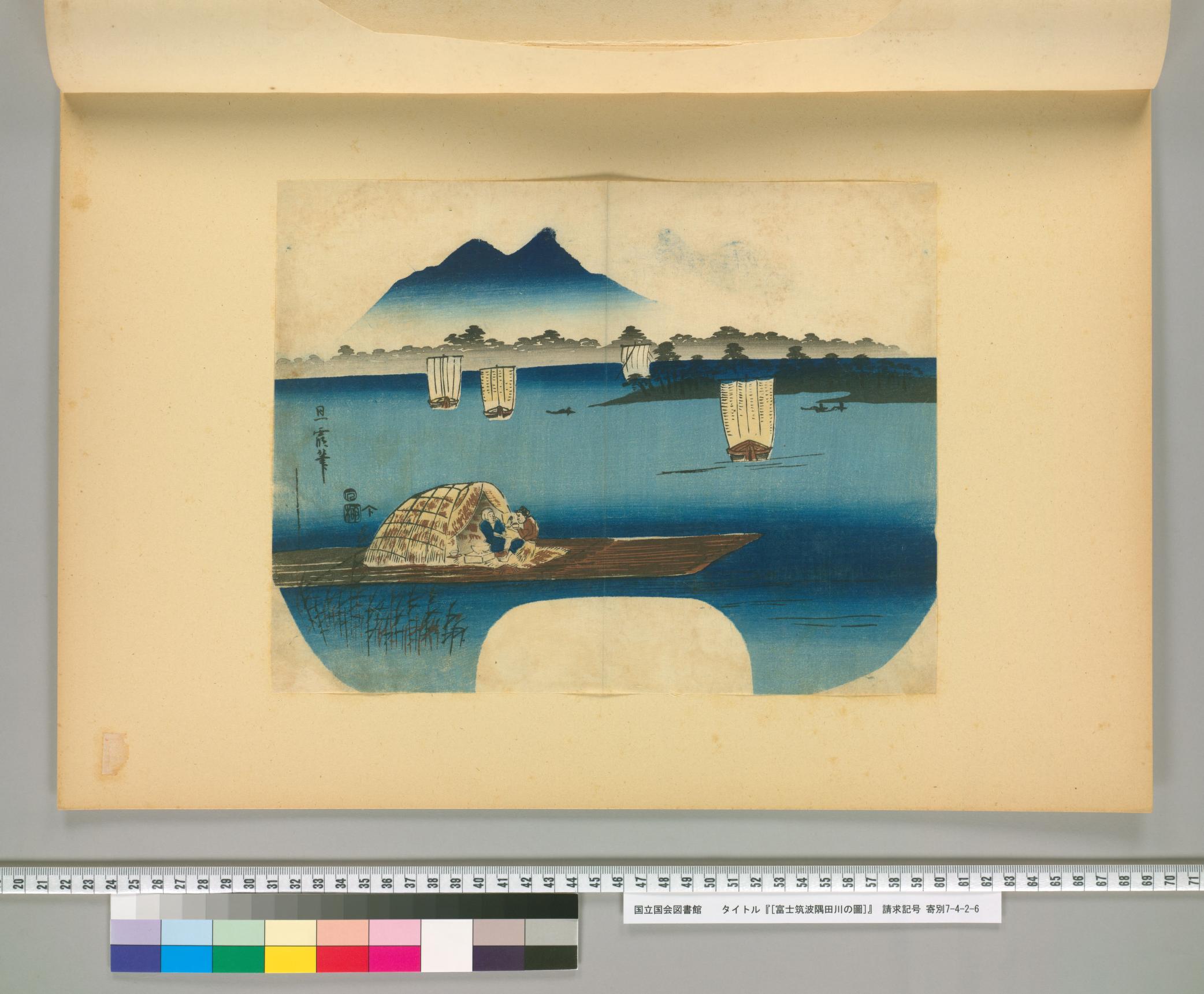
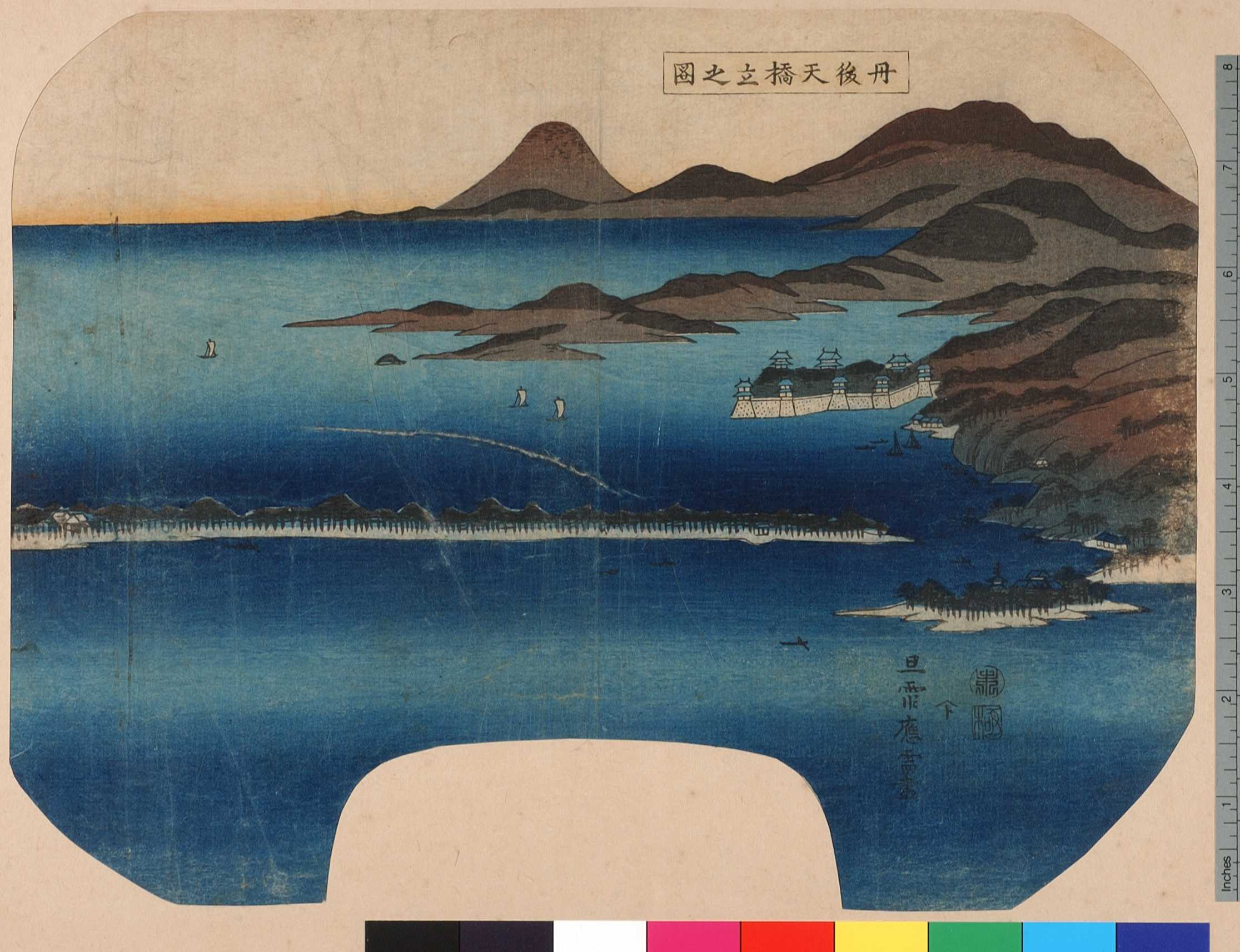 (3) RISD Museum 34.334:
(3) RISD Museum 34.334:
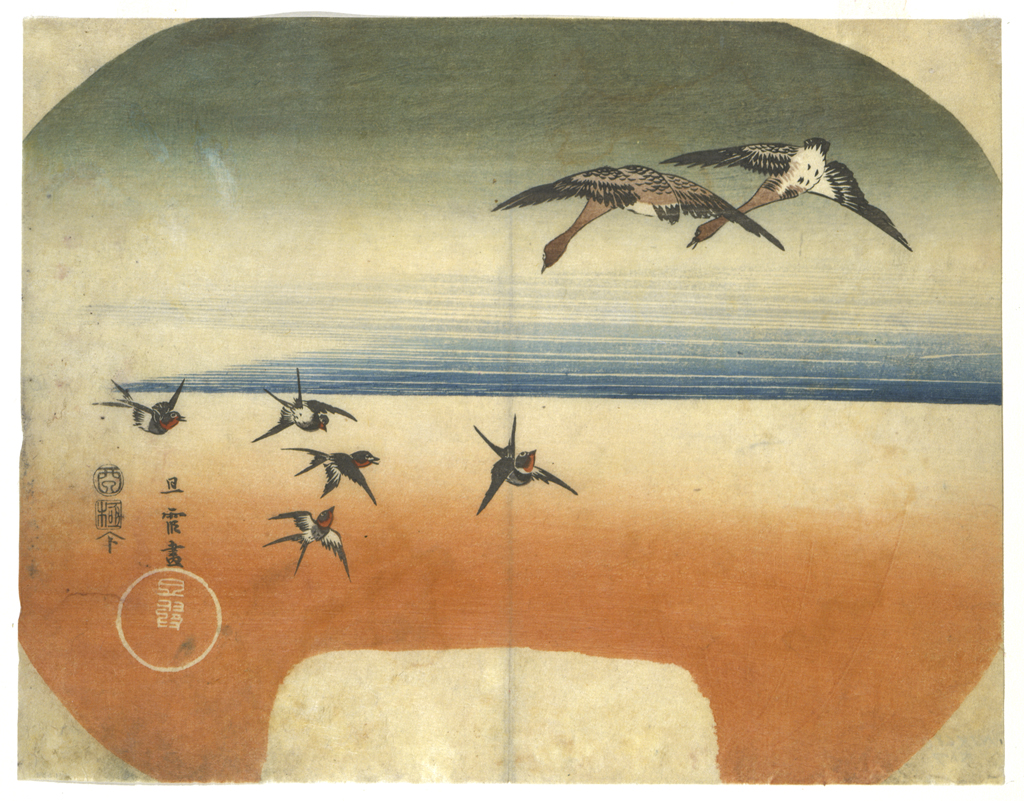
-
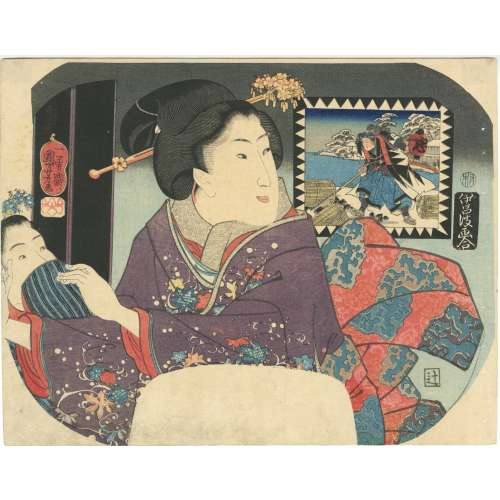 Series: Pictures Associated with the Iroha Syllabary [伊呂波画合]. Artist: Utagawa Kuniyoshi [歌川 國芳] (1798 – 1861). Signed: Ichiyûsai Kuniyoshi giga [一勇斎 國芳戯画] (Playfully drawn by Ichiyūsai Kuniyoshi) in a red double-gourd cartouche with a kiri-mon seal beneath. Publisher: Iseya Ichiemon [伊勢屋市右衛門] (Japanese, fl. 1823 – c. 1864); seal [辻] (Marks 16-029 | 143a). Single nanushi censor seal: Mura [村] = Murata Sahei [村田佐右衛] (VI/1842 – V/1846). Media: Fan print (uchiwa-e, 団扇絵), 231 x 296 mm. Theme: The Treasury of Loyal Retainers [仮名手本忠臣蔵] (Kanadehon Chūshingura) – an 11-act puppet play composed in 1748, based on a historical event. "Most historians now agree that there were forty-seven rōnin of Ako who attacked and killed Kira Yoshinaka (吉良 義央, 1641 – 1703) in Edo in the twelfth month of 1702, twenty-two months after their lord Asano Naganori (浅野 長矩, 1667 – 1701) had been put to death for his own failed attempt on Kira’s life". [Henry D. SMITH II. The Trouble with Terasaka: The Forty-Seventh Rōnin and the Chūshingura Imagination / Japan Review, 2004, 16:3-65]. The reader shall remember that the fictional, romantic version of the Akō incident [赤穂事件] (Akō jiken) may not (and most probably does not) reflect the historical truth of events. Uncut fan print depicting a beautiful young woman covering another woman's mouth with a blue striped cloth, possibly an obi. The picture on the wall represents the scene from the final act of The Treasury of Loyal Retainers (Kanadehon Chūshingura, Act 11) when 47 loyal retainers (rōnin) of the late lord En'ya Hangan came to the house of Kō no Moronao in order to avenge their dead master. The leader of 47 rōnin, Ōboshi Yuranosuke, divided his accomplices into several groups which attacked the Moronao mansion from different directions. To coordinate the attack and keep communication among the groups, the rōnin were signing the first syllables of their names in the hiragana syllabary. There are two major types of the ordering of the hiragana syllabary, the Gojūon one and the Iroha order (pangram poem), the latter being used here. The number of avengers exactly matches the 47 letters of that syllabary. The group entering Moronao's house from the front gate was 'chi-ri-nu-ru-wo-wa-ka'. Yoshida Sadaemon Kanesada [葦田貞右衛門兼貞] (1675 – 1703) depicted on this fan print belongs to this group. The character on the lantern hanging from Yoshida's spear reads Chū [忠] – for Chūshingura. Alternating black and white triangles on the picture frame allude to the 'signature' 47 ronin's uniform. This motif is usually described as a zigzag pattern [雁木模様] (gangi moyō), a mountain-shaped pattern [山形模様] (yamagata moyō), or a mountain road [山道] (yamamichi). The rōnin were allegedly wearing this uniform in imitation of firefighters. The government allowed the firefighters alone to gather in large groups and carry equipment akin to that of the military. Such equipment was necessary for firemen to tear down the burning buildings to stop the flames. The design can be seen in Kunimaru's fan print [SVJP-0233.2018] in this collection.Fighting Moronao's guards, the 47 rōnin entered the mansion and searched for their enemy but in vain. Finally, Yazama Jujiro Motooki [矢間重次郎元興] found the villain in the charcoal chamber and called his friends. This is the exact moment we see in the picture on the wall: Yoshida entering the charcoal chamber with a spear in his hand amid falling baskets and charcoal. Kō no Moronao was brought to justice and beheaded; his head was offered before the memorial tablet of En'ya Hangan to appease his spirit. After that, Ōboshi Yuranosuke and his 46 friends committed seppuku. They were buried at Sengakuji (泉岳寺) – a small temple near Shinagawa in Edo (Tokyo).
Series: Pictures Associated with the Iroha Syllabary [伊呂波画合]. Artist: Utagawa Kuniyoshi [歌川 國芳] (1798 – 1861). Signed: Ichiyûsai Kuniyoshi giga [一勇斎 國芳戯画] (Playfully drawn by Ichiyūsai Kuniyoshi) in a red double-gourd cartouche with a kiri-mon seal beneath. Publisher: Iseya Ichiemon [伊勢屋市右衛門] (Japanese, fl. 1823 – c. 1864); seal [辻] (Marks 16-029 | 143a). Single nanushi censor seal: Mura [村] = Murata Sahei [村田佐右衛] (VI/1842 – V/1846). Media: Fan print (uchiwa-e, 団扇絵), 231 x 296 mm. Theme: The Treasury of Loyal Retainers [仮名手本忠臣蔵] (Kanadehon Chūshingura) – an 11-act puppet play composed in 1748, based on a historical event. "Most historians now agree that there were forty-seven rōnin of Ako who attacked and killed Kira Yoshinaka (吉良 義央, 1641 – 1703) in Edo in the twelfth month of 1702, twenty-two months after their lord Asano Naganori (浅野 長矩, 1667 – 1701) had been put to death for his own failed attempt on Kira’s life". [Henry D. SMITH II. The Trouble with Terasaka: The Forty-Seventh Rōnin and the Chūshingura Imagination / Japan Review, 2004, 16:3-65]. The reader shall remember that the fictional, romantic version of the Akō incident [赤穂事件] (Akō jiken) may not (and most probably does not) reflect the historical truth of events. Uncut fan print depicting a beautiful young woman covering another woman's mouth with a blue striped cloth, possibly an obi. The picture on the wall represents the scene from the final act of The Treasury of Loyal Retainers (Kanadehon Chūshingura, Act 11) when 47 loyal retainers (rōnin) of the late lord En'ya Hangan came to the house of Kō no Moronao in order to avenge their dead master. The leader of 47 rōnin, Ōboshi Yuranosuke, divided his accomplices into several groups which attacked the Moronao mansion from different directions. To coordinate the attack and keep communication among the groups, the rōnin were signing the first syllables of their names in the hiragana syllabary. There are two major types of the ordering of the hiragana syllabary, the Gojūon one and the Iroha order (pangram poem), the latter being used here. The number of avengers exactly matches the 47 letters of that syllabary. The group entering Moronao's house from the front gate was 'chi-ri-nu-ru-wo-wa-ka'. Yoshida Sadaemon Kanesada [葦田貞右衛門兼貞] (1675 – 1703) depicted on this fan print belongs to this group. The character on the lantern hanging from Yoshida's spear reads Chū [忠] – for Chūshingura. Alternating black and white triangles on the picture frame allude to the 'signature' 47 ronin's uniform. This motif is usually described as a zigzag pattern [雁木模様] (gangi moyō), a mountain-shaped pattern [山形模様] (yamagata moyō), or a mountain road [山道] (yamamichi). The rōnin were allegedly wearing this uniform in imitation of firefighters. The government allowed the firefighters alone to gather in large groups and carry equipment akin to that of the military. Such equipment was necessary for firemen to tear down the burning buildings to stop the flames. The design can be seen in Kunimaru's fan print [SVJP-0233.2018] in this collection.Fighting Moronao's guards, the 47 rōnin entered the mansion and searched for their enemy but in vain. Finally, Yazama Jujiro Motooki [矢間重次郎元興] found the villain in the charcoal chamber and called his friends. This is the exact moment we see in the picture on the wall: Yoshida entering the charcoal chamber with a spear in his hand amid falling baskets and charcoal. Kō no Moronao was brought to justice and beheaded; his head was offered before the memorial tablet of En'ya Hangan to appease his spirit. After that, Ōboshi Yuranosuke and his 46 friends committed seppuku. They were buried at Sengakuji (泉岳寺) – a small temple near Shinagawa in Edo (Tokyo).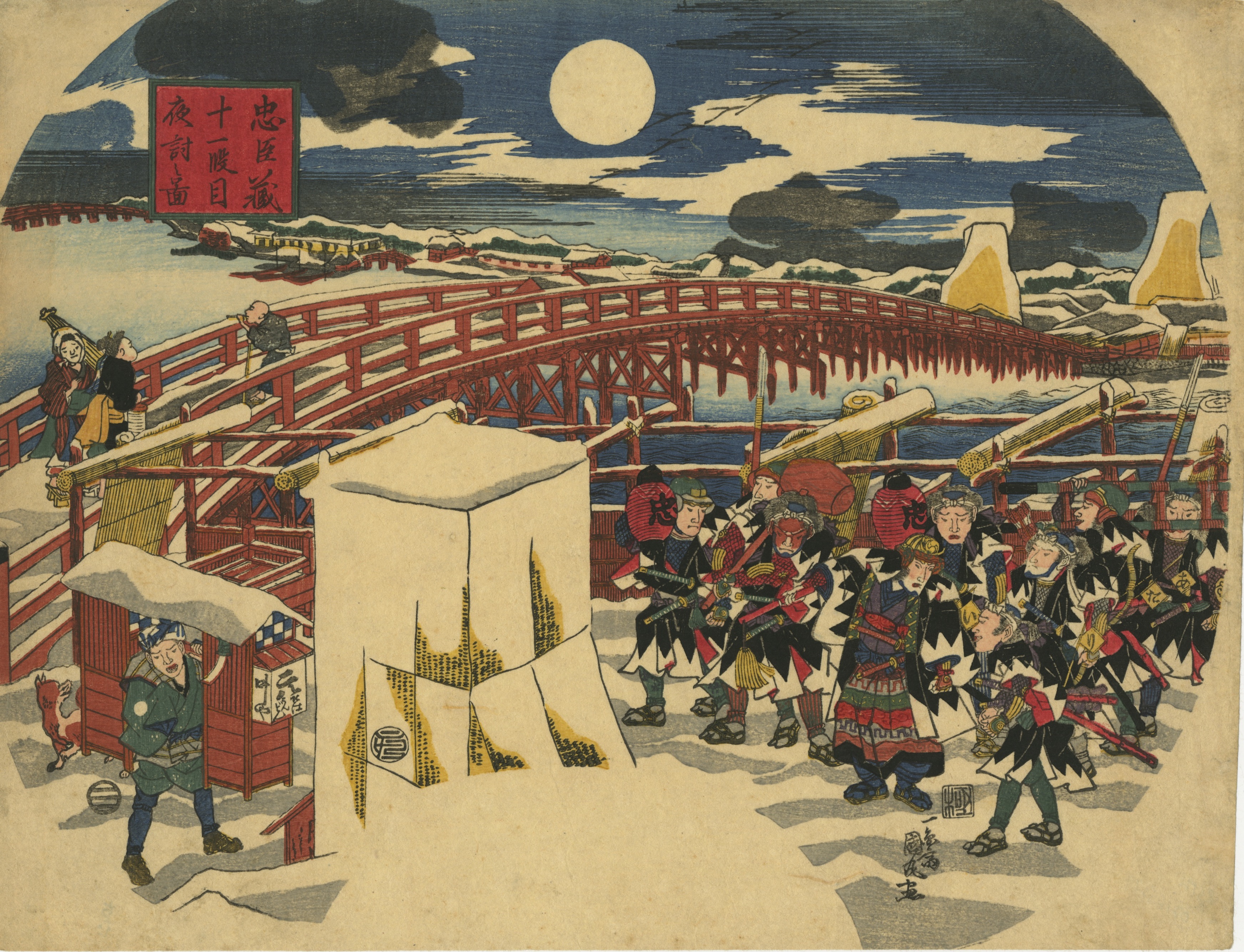
Utagawa Kunimaru. Chūshingura, Act 11.
 Another fan print from the same series can be found at Kuniyoshi Project:
Another fan print from the same series can be found at Kuniyoshi Project:
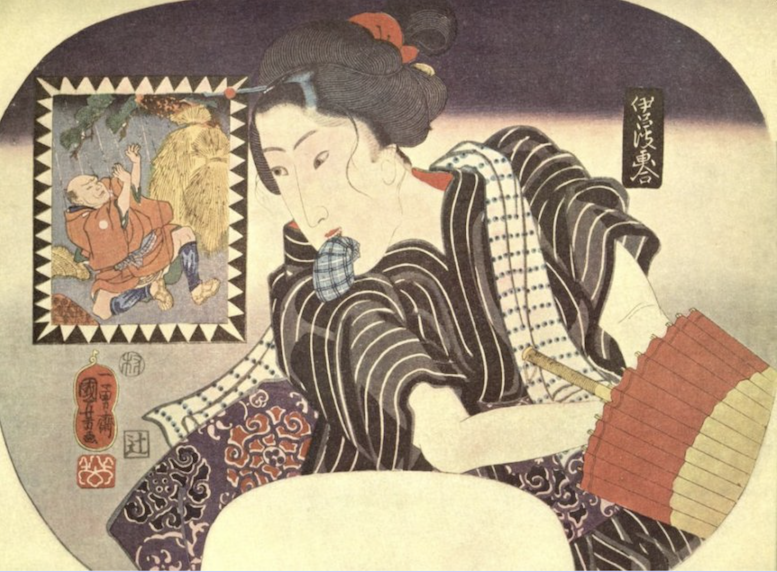 The same subject is portrayed by Kuniyoshi in the series Mirror of the True Loyalty of the Faithful Retainers [誠忠義臣鏡] (Seichû gishin kagami), publisher: Kagiya Hanjirô, c. 1851 (Kuniyoshi Project) – Yoshida Sadaemon Kanesada (葦田貞右衛門兼貞) raising his sword amid falling baskets and charcoal:
The same subject is portrayed by Kuniyoshi in the series Mirror of the True Loyalty of the Faithful Retainers [誠忠義臣鏡] (Seichû gishin kagami), publisher: Kagiya Hanjirô, c. 1851 (Kuniyoshi Project) – Yoshida Sadaemon Kanesada (葦田貞右衛門兼貞) raising his sword amid falling baskets and charcoal:
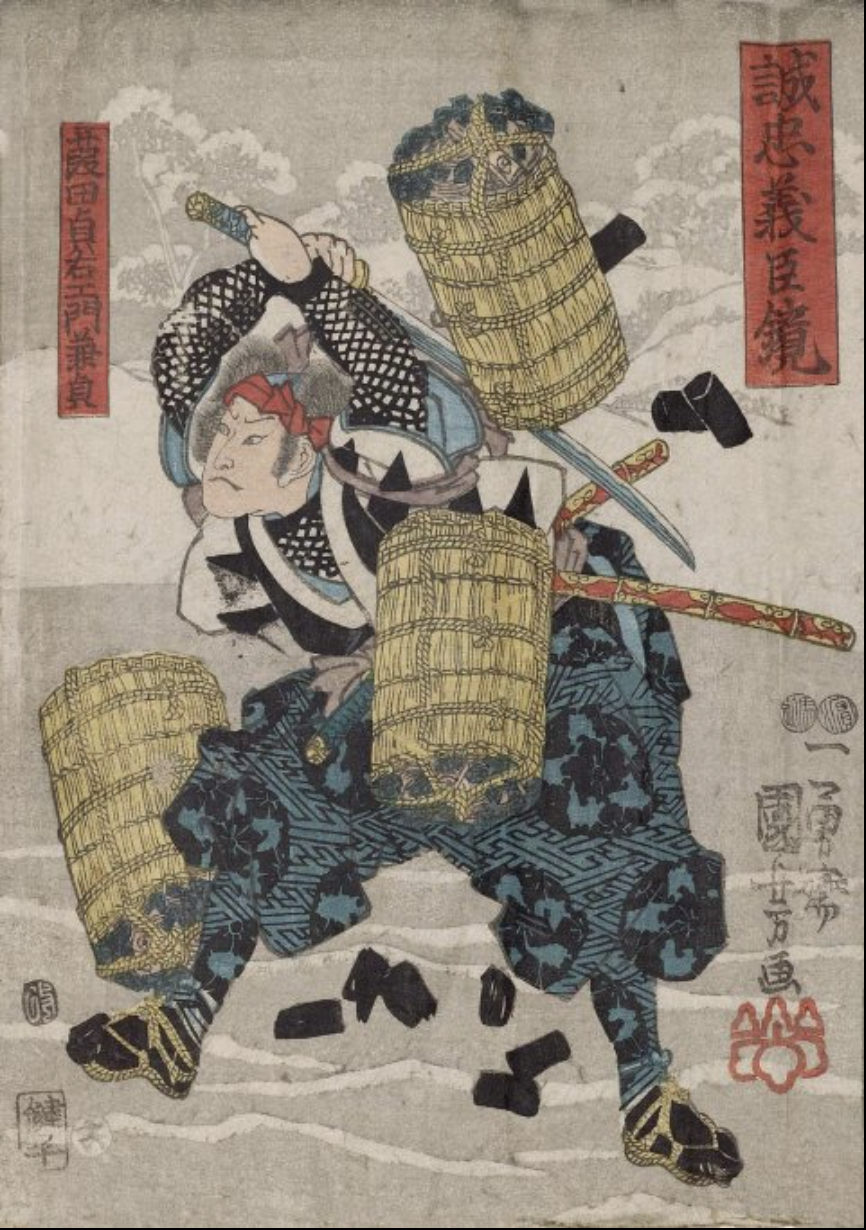
-
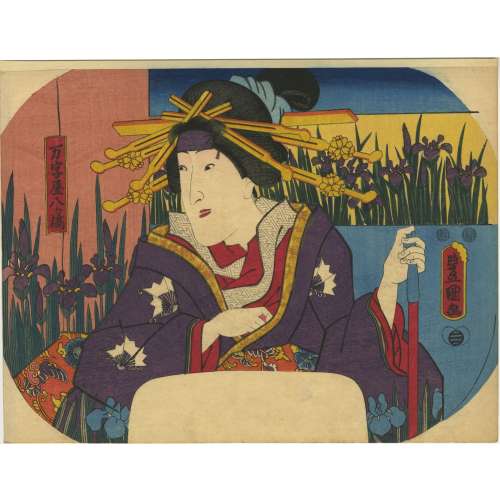 Artist: Utagawa Kunisada [歌川 国貞]; a.k.a. Utagawa Toyokuni III [三代歌川豊国] (Japanese, 1786 – 1865). Signed: Toyokuni ga [豊国 画] in a red toshidama cartouche. Publisher: Ibaya Senzaburō [伊場屋仙三郎] (Japanese, fl. C. 1845 – 1847), seal: San [三] (Marks 11-001 | 127c). Block carver: Matsushima Fusajirō [松嶋房次郎] (Japanese, fl. 1843 – 1850); seal [彫工房] – Hori kō Fusa (Gordon Friese № 134). Double nanushi censor seal: Kunigasa & Watanabe (1849-50). Actor: Iwai Hanshirō VIII [岩井半四郎] (Japanese, 1829 – 1882); other names: Iwai Shijaku II, Iwai Kumesaburō III [岩井粂三郎], Iwai Hisajirō II. Play: Yukari no Hana Iro mo Yoshiwara [紫花色吉原], performed at the Kawarazaki Theater (Edo) from the 5th day of the 5th lunar month of Kaei 3 (1850) (see Kabuki Playbill at MFA (Boston) № 11.27996).
Artist: Utagawa Kunisada [歌川 国貞]; a.k.a. Utagawa Toyokuni III [三代歌川豊国] (Japanese, 1786 – 1865). Signed: Toyokuni ga [豊国 画] in a red toshidama cartouche. Publisher: Ibaya Senzaburō [伊場屋仙三郎] (Japanese, fl. C. 1845 – 1847), seal: San [三] (Marks 11-001 | 127c). Block carver: Matsushima Fusajirō [松嶋房次郎] (Japanese, fl. 1843 – 1850); seal [彫工房] – Hori kō Fusa (Gordon Friese № 134). Double nanushi censor seal: Kunigasa & Watanabe (1849-50). Actor: Iwai Hanshirō VIII [岩井半四郎] (Japanese, 1829 – 1882); other names: Iwai Shijaku II, Iwai Kumesaburō III [岩井粂三郎], Iwai Hisajirō II. Play: Yukari no Hana Iro mo Yoshiwara [紫花色吉原], performed at the Kawarazaki Theater (Edo) from the 5th day of the 5th lunar month of Kaei 3 (1850) (see Kabuki Playbill at MFA (Boston) № 11.27996).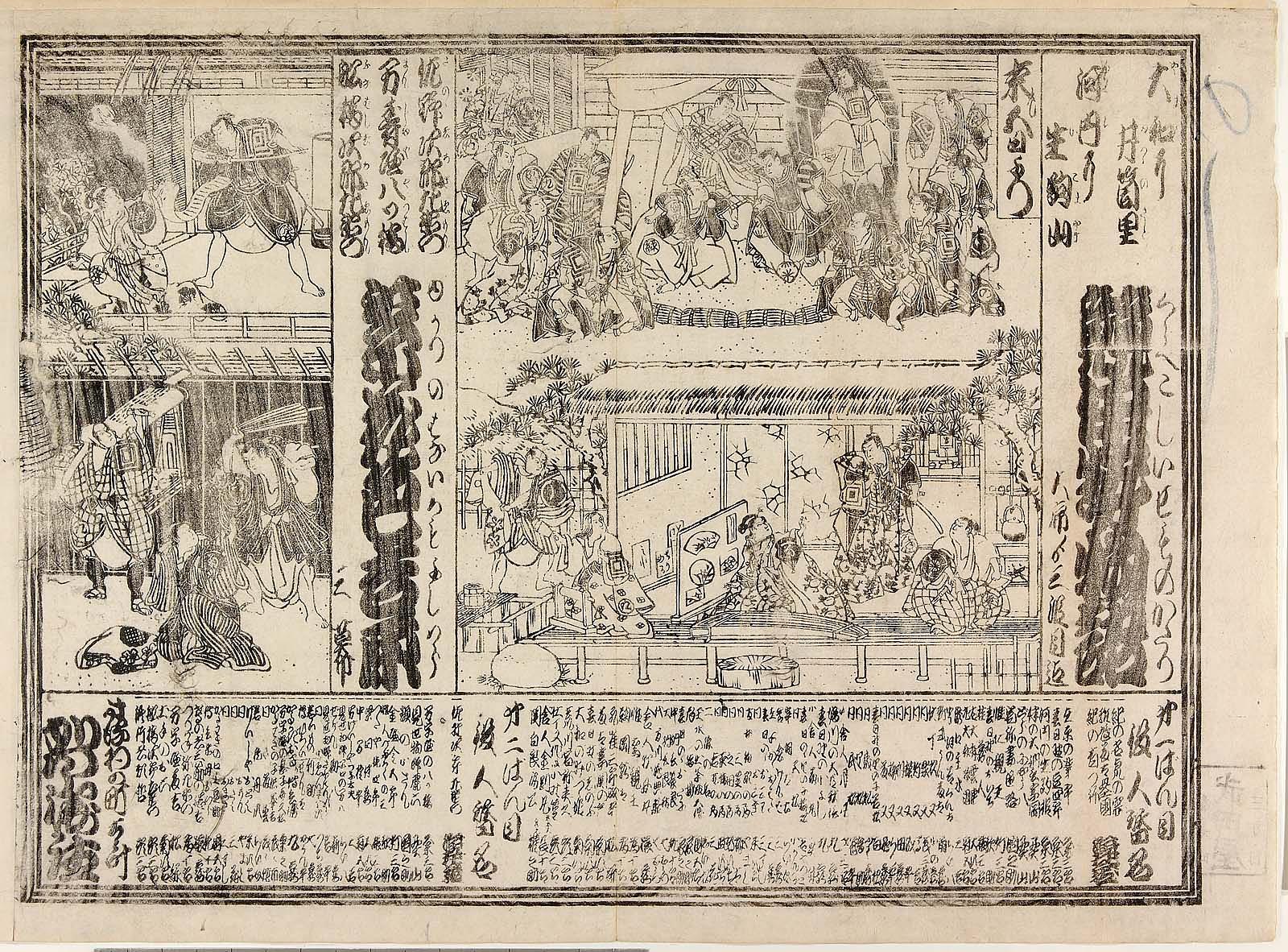 A famous Yoshiwara courtesan named Manjiya Yatsuhashi [万字屋 八ツ橋] was killed by a provincial commoner Sano Jirōzaemon [佐野次郎左衛門] (on the second sheet of the pair):
A famous Yoshiwara courtesan named Manjiya Yatsuhashi [万字屋 八ツ橋] was killed by a provincial commoner Sano Jirōzaemon [佐野次郎左衛門] (on the second sheet of the pair):
Another Kunisada's print with the same characters in the same play and same performance can be seen at MFA (Boston) № 11.40190.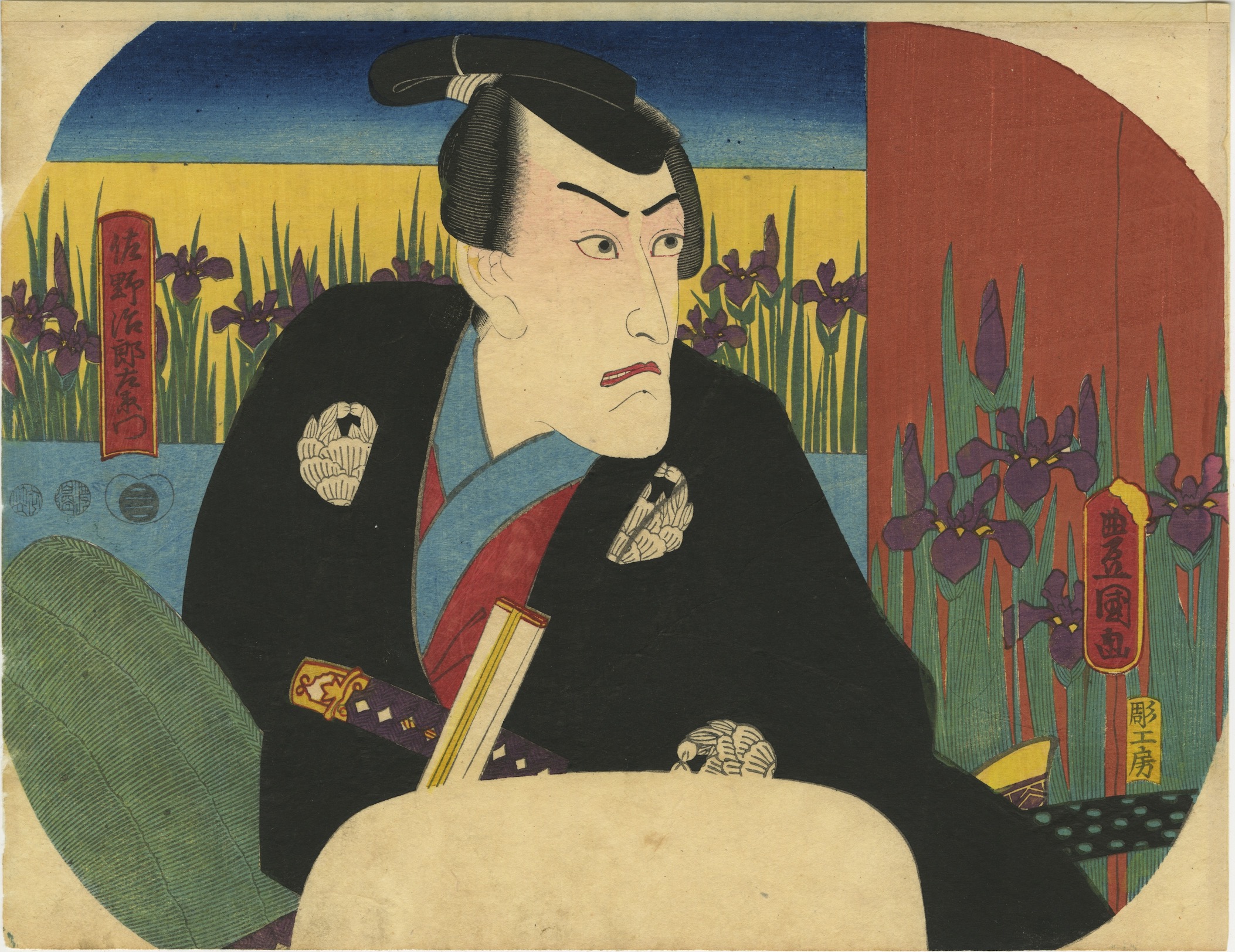
SVJP-0298.2019: Ichikawa Ebizō V as Sano Jirōzaemon.
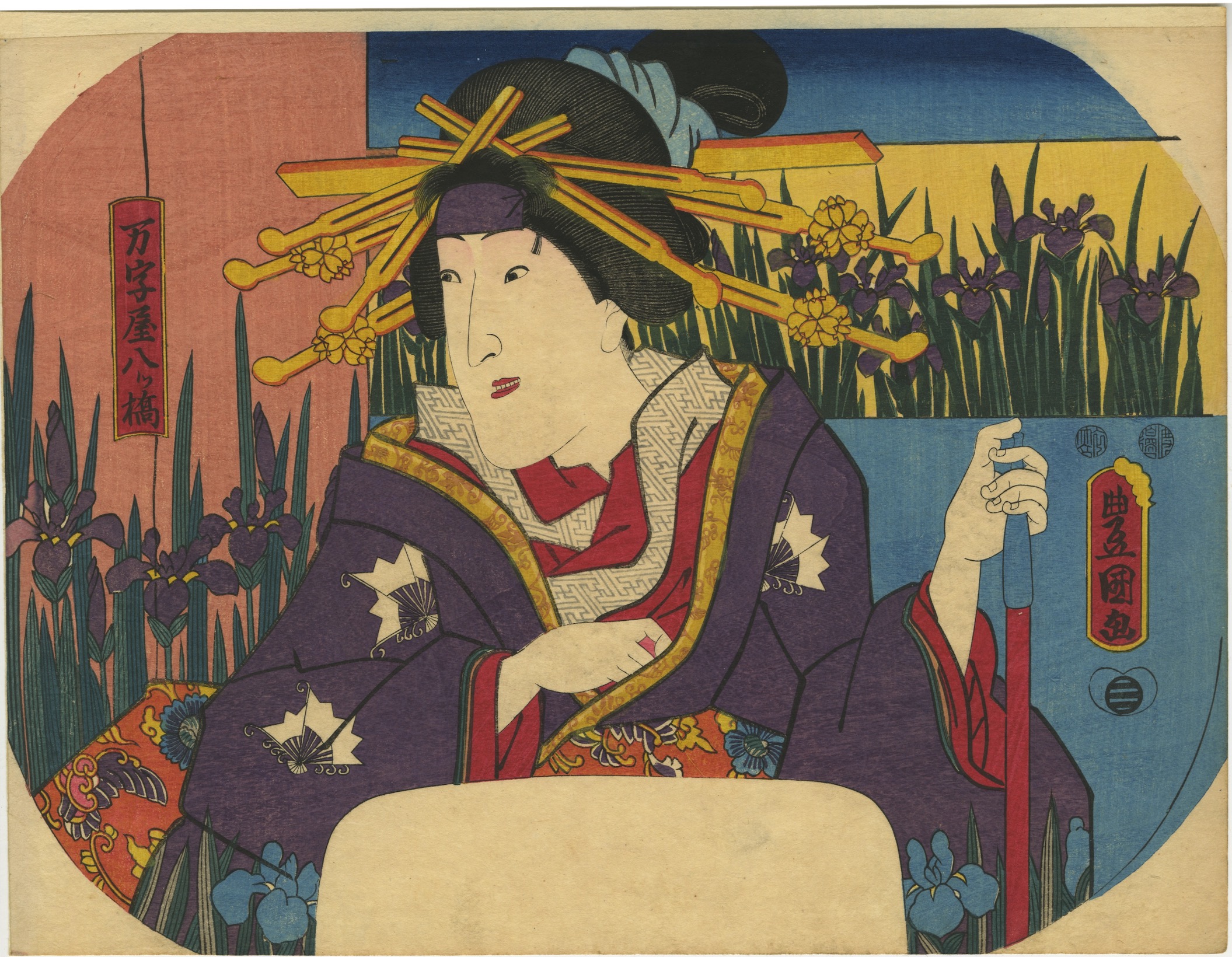
SVJP-0297.2019: Iwai Kumesaburō III as Manjiya Yatsuhashi
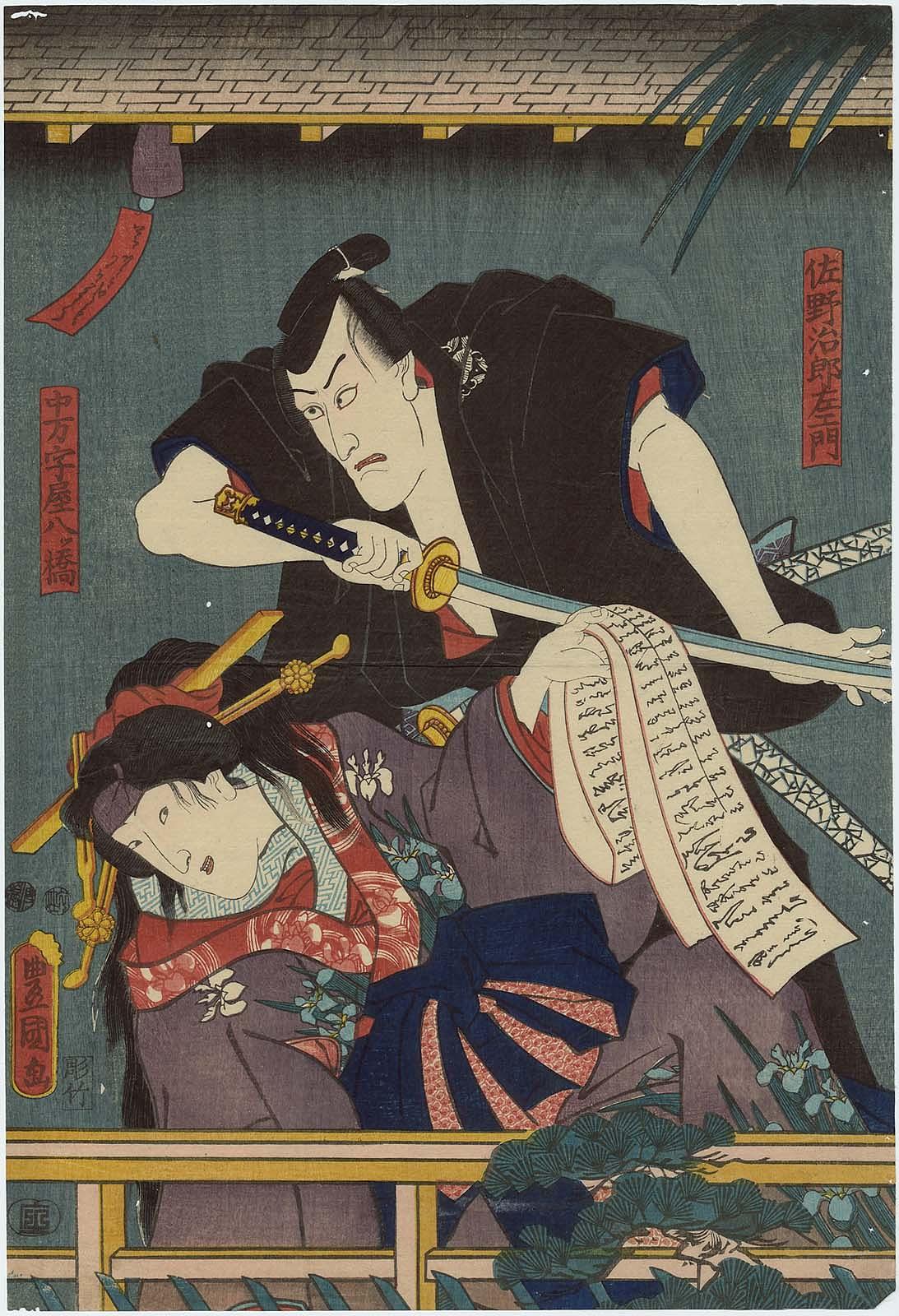 One more example can be seen in the two upper images at Waseda University Cultural Resources Database, № 006-2707:
One more example can be seen in the two upper images at Waseda University Cultural Resources Database, № 006-2707:
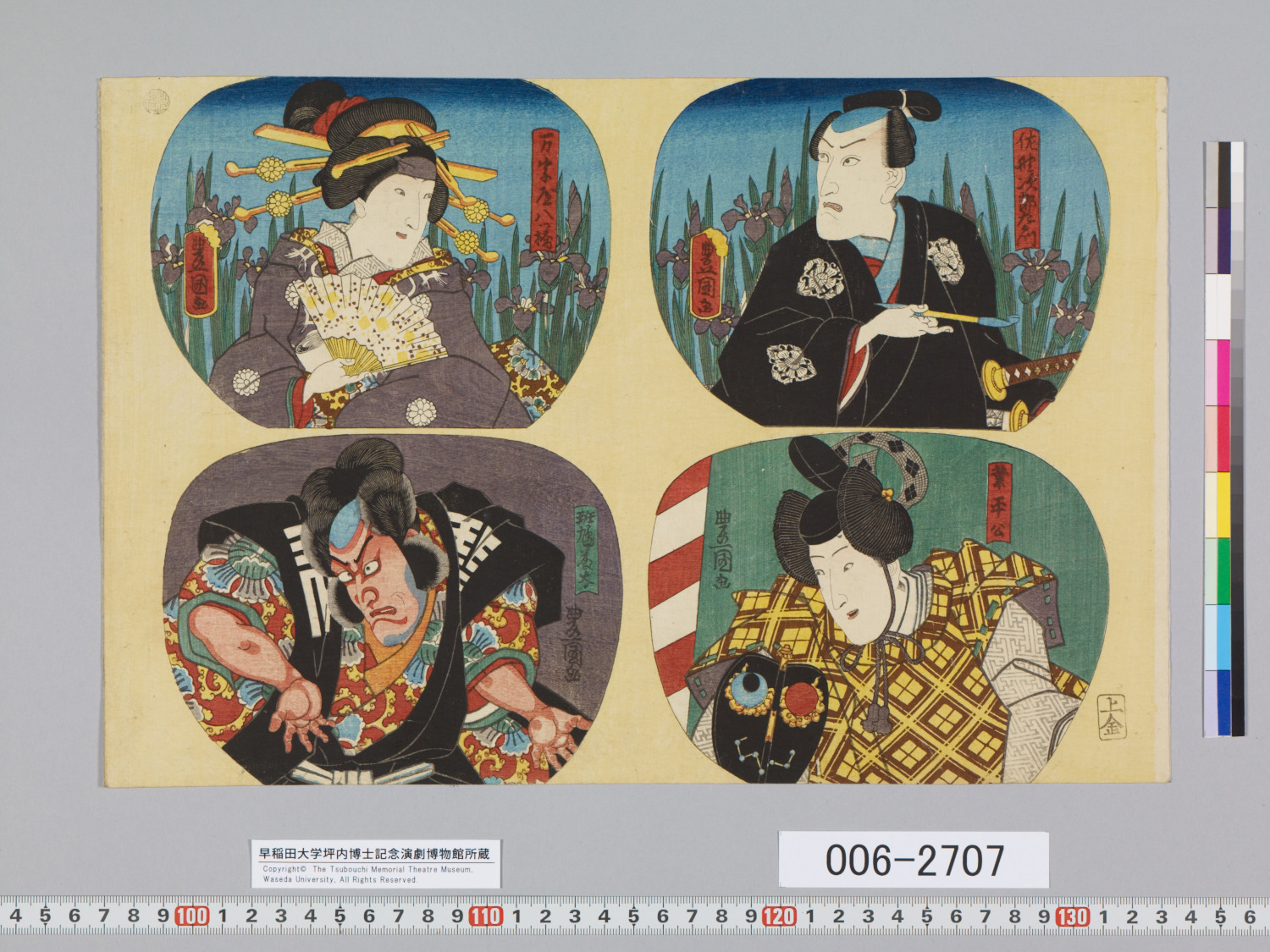
-
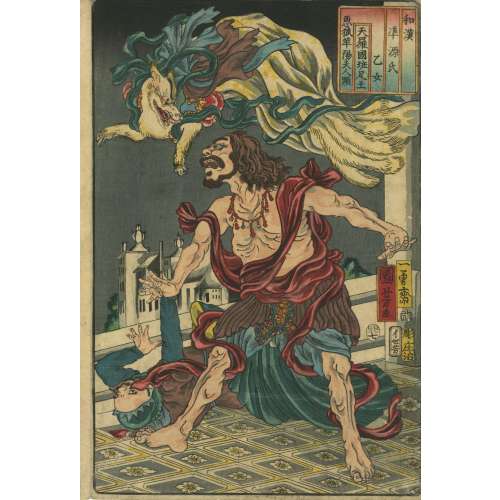 Title: Lyon Collection: Genji, Chapter 21, the maiden (otome - 乙女): the nine-tailed fox woman (kayō-fujin [花陽夫人]) terrorizing Prince Hanzoku (足王) and his servant from the series Japanese and Chinese parallels to Genji (wakan nazorae genji - 和漢准源氏). British Museum: Otome 乙女 (Maiden) / Waken nazorae Genji 和漢准源氏 (Japanese and Chinese Comparisons for the Chapters of the Genji). Schaap: Prince Hanzoku terrorized by a nine-tailed fox; Series: Wakan nazorae Genji (Japanese and Chinese parallels to Genji) Artist: Utagawa Kuniyoshi [歌川 國芳] (1798 – 1861). Publisher: Iseyoshi [伊勢芳] (Marks 25-013 | U095); seal [イせ芳]. Block carver: Hori Shōji [彫庄治] (Lyon Collection; BM); Hori Takichi [彫多吉] (Schaap). Date-aratame seal: Ansei 2, 7th month (1855). Ref: Jack Hillier. Japanese prints and drawings from the Vever Collection (3 volumes). — New York: Sotheby Parke Bernet & Rizzoli International, 1976; vol.3, p. 868, pl. 847. Robinson (1982): p. 161, S88, № 21. Schaap (1998): p. 115, № 107. SOLD
Title: Lyon Collection: Genji, Chapter 21, the maiden (otome - 乙女): the nine-tailed fox woman (kayō-fujin [花陽夫人]) terrorizing Prince Hanzoku (足王) and his servant from the series Japanese and Chinese parallels to Genji (wakan nazorae genji - 和漢准源氏). British Museum: Otome 乙女 (Maiden) / Waken nazorae Genji 和漢准源氏 (Japanese and Chinese Comparisons for the Chapters of the Genji). Schaap: Prince Hanzoku terrorized by a nine-tailed fox; Series: Wakan nazorae Genji (Japanese and Chinese parallels to Genji) Artist: Utagawa Kuniyoshi [歌川 國芳] (1798 – 1861). Publisher: Iseyoshi [伊勢芳] (Marks 25-013 | U095); seal [イせ芳]. Block carver: Hori Shōji [彫庄治] (Lyon Collection; BM); Hori Takichi [彫多吉] (Schaap). Date-aratame seal: Ansei 2, 7th month (1855). Ref: Jack Hillier. Japanese prints and drawings from the Vever Collection (3 volumes). — New York: Sotheby Parke Bernet & Rizzoli International, 1976; vol.3, p. 868, pl. 847. Robinson (1982): p. 161, S88, № 21. Schaap (1998): p. 115, № 107. SOLD -
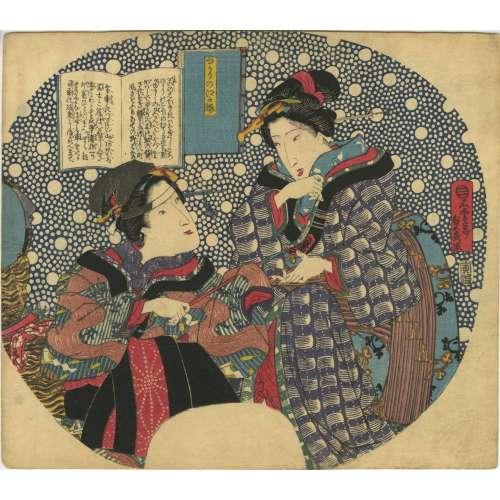 Artist: Utagawa Sadahide [歌川 貞秀], a.k.a. Gountei Sadahide [五雲亭 貞秀] (1807 – c. 1878/9). Signed: Gountei Sadahide ga [五雲亭貞秀画] Pubisher: Ibaya Senzaburō [伊場屋仙三郎] (Japanese, 1815 – 1869) Date-aratame seal: Bunsei 13 / Tenpō 1 (1830). Ref: Ritsumeikan University # Z0172-587. Title: Yukari no Edo-zakura [ゆかりの江戸桜], often translated into English as 'The Flower of Edo', is a one-act kabuki play Sukeroku, written by Tsuuchi Han'emon (fl. 1701 – 1743) under the supervision of Tsuuchi Jihei II (1673 – 1760 ) at the beginning of the 18th century. From the beginning of the 19th century, the play was performed in the style of katōbushi. 助六所縁江戸桜(すけろくゆかりのえどざくら。「助六」– one of the main melodies in katōbushi (河東節) type of jōruri [浄瑠璃]. For a detailed explanation in Japanese, see also HERE). Plot: In search of the stolen Minamoto clan's precious sword called Tomokirimaru, Soga Gorō (historical Soga Tokimune [曾我時致], 1174 – 1193) came to a Yoshiwara brothel under the disguise of a debaucher named Hanagawado Sukeroku. His elder brother, Soga Jūrō (historical Soga Sukenari [曾我祐成], 1172 – 1193) ), has assumed the guise of a wine vendor Shinbei. The character who had the Tomokirimaru sword was Ikyū (historical Iga no Heinaizaemon, a Tiara clan's ally), see SVJP-0164.2014. A series of three prints is dedicated to a katōbushi performance of the Soga-themed plays.
Artist: Utagawa Sadahide [歌川 貞秀], a.k.a. Gountei Sadahide [五雲亭 貞秀] (1807 – c. 1878/9). Signed: Gountei Sadahide ga [五雲亭貞秀画] Pubisher: Ibaya Senzaburō [伊場屋仙三郎] (Japanese, 1815 – 1869) Date-aratame seal: Bunsei 13 / Tenpō 1 (1830). Ref: Ritsumeikan University # Z0172-587. Title: Yukari no Edo-zakura [ゆかりの江戸桜], often translated into English as 'The Flower of Edo', is a one-act kabuki play Sukeroku, written by Tsuuchi Han'emon (fl. 1701 – 1743) under the supervision of Tsuuchi Jihei II (1673 – 1760 ) at the beginning of the 18th century. From the beginning of the 19th century, the play was performed in the style of katōbushi. 助六所縁江戸桜(すけろくゆかりのえどざくら。「助六」– one of the main melodies in katōbushi (河東節) type of jōruri [浄瑠璃]. For a detailed explanation in Japanese, see also HERE). Plot: In search of the stolen Minamoto clan's precious sword called Tomokirimaru, Soga Gorō (historical Soga Tokimune [曾我時致], 1174 – 1193) came to a Yoshiwara brothel under the disguise of a debaucher named Hanagawado Sukeroku. His elder brother, Soga Jūrō (historical Soga Sukenari [曾我祐成], 1172 – 1193) ), has assumed the guise of a wine vendor Shinbei. The character who had the Tomokirimaru sword was Ikyū (historical Iga no Heinaizaemon, a Tiara clan's ally), see SVJP-0164.2014. A series of three prints is dedicated to a katōbushi performance of the Soga-themed plays.
They all have a background of hail patterns (Arare-ko-mon) [霰小紋], similar to Kunisada’s Iwai Kumesaburō II as An no Heibei [SVJP-0304.2019], see below.Yukari no Edo-zakura The tatami night robe of Iwao Tangled Hair and the Evening Braided Hat 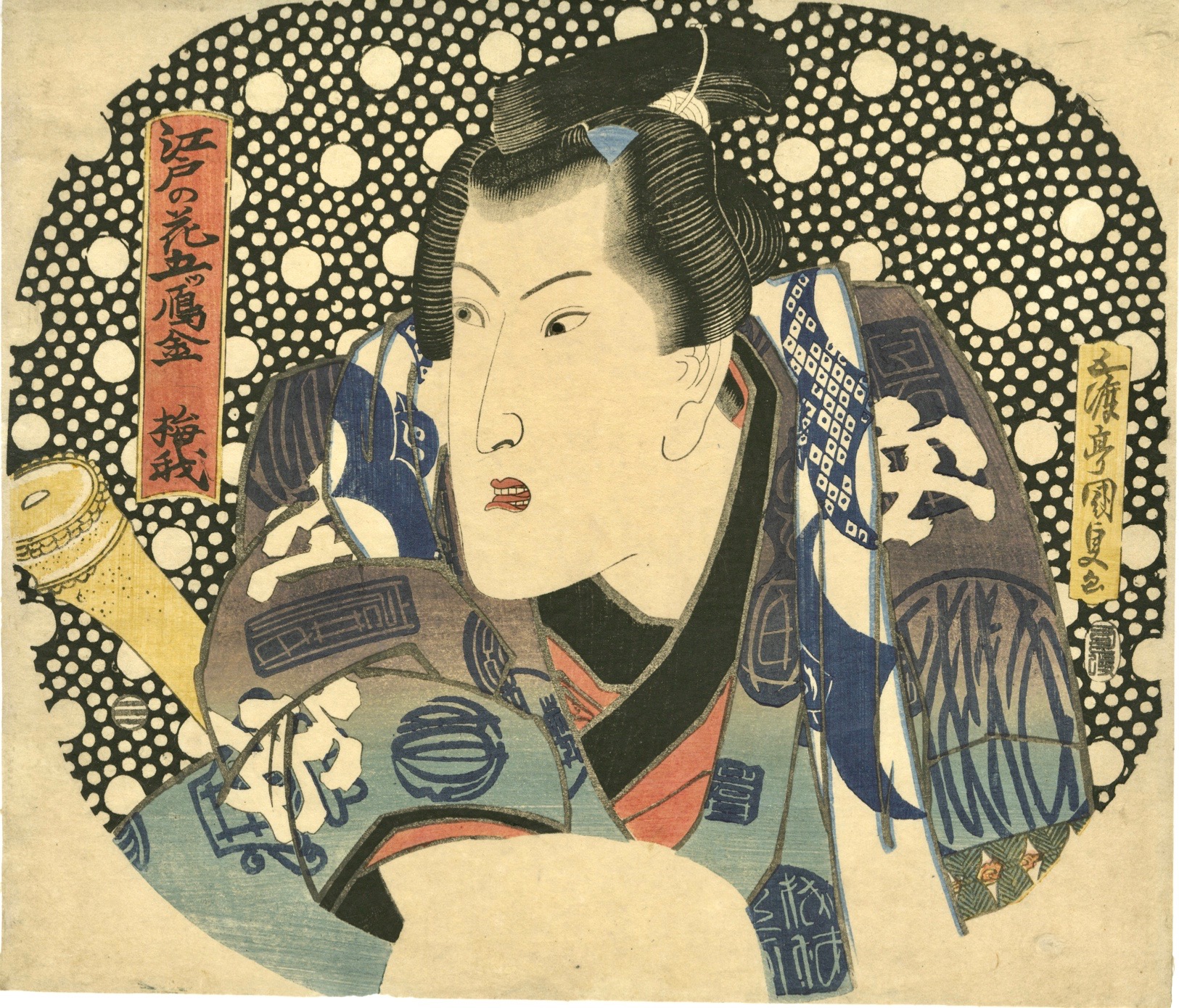
-
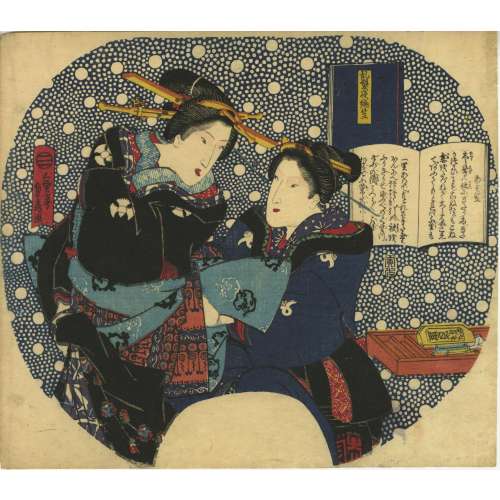 Artist: Utagawa Sadahide [歌川 貞秀], a.k.a. Gountei Sadahide [五雲亭 貞秀] (1807 – c. 1878/9). Signed: Gountei Sadahide ga [五雲亭貞秀画] Pubisher: Ibaya Senzaburō [伊場屋仙三郎] (Japanese, 1815 – 1869) Date-aratame seal: Bunsei 13 / Tenpō 1 (1830). Ref: Ritsumeikan University # Z0172-587. Title: Tangled Hair and the Evening Braided Hat [乱髪夜編笠] (Midaregami Yoru no Amigasa). The open book starts with the chapter title that reads Amigasa. This play was performed together with Kisohajime Hatsugai Soga [着衣始]初買曽我]. See the playbill for the performance at Moritaza at MFA (Boston) № 11.27208. 乱髪夜編笠(みだれがみよるのあみがさ。「夜の編笠」「白さぎ」
Artist: Utagawa Sadahide [歌川 貞秀], a.k.a. Gountei Sadahide [五雲亭 貞秀] (1807 – c. 1878/9). Signed: Gountei Sadahide ga [五雲亭貞秀画] Pubisher: Ibaya Senzaburō [伊場屋仙三郎] (Japanese, 1815 – 1869) Date-aratame seal: Bunsei 13 / Tenpō 1 (1830). Ref: Ritsumeikan University # Z0172-587. Title: Tangled Hair and the Evening Braided Hat [乱髪夜編笠] (Midaregami Yoru no Amigasa). The open book starts with the chapter title that reads Amigasa. This play was performed together with Kisohajime Hatsugai Soga [着衣始]初買曽我]. See the playbill for the performance at Moritaza at MFA (Boston) № 11.27208. 乱髪夜編笠(みだれがみよるのあみがさ。「夜の編笠」「白さぎ」とも)– one of the main melodies in katōbushi (河東節) type of jōruri [浄瑠璃]. For a detailed explanation in Japanese, see also HERE). A series of three prints is dedicated to a katōbushi performance of the Soga-themed plays.
They all have a background of hail patterns (Arare-ko-mon) [霰小紋], similar to Kunisada’s Iwai Kumesaburō II as An no Heibei [SVJP-0304.2019], see below.Yukari no Edo-zakura The tatami night robe of Iwao Tangled Hair and the Evening Braided Hat 
-
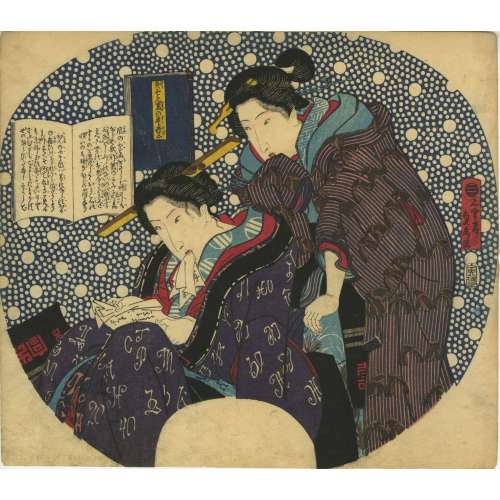 Artist: Utagawa Sadahide [歌川 貞秀], a.k.a. Gountei Sadahide [五雲亭 貞秀] (1807 – c. 1878/9). Signed: Gountei Sadahide ga [五雲亭貞秀画] Pubisher: Ibaya Senzaburō [伊場屋仙三郎] (Japanese, 1815 – 1869) Date-aratame seal: Bunsei 13 / Tenpō 1 (1830). Ref: Ritsumeikan University # Z0172-587. Title: The tatami night robe of Iwao [巌の畳夜着] (Kyusue Iwao no tatami yogi); 灸すゑ巌の畳夜着(きゅうすえいわおのたたみよぎ。「灸すえ」– one of the main melodies in katōbushi (河東節) type of jōruri [浄瑠璃]. For a detailed explanation in Japanese, see also HERE). The night robe of Iwao is decorated with characters resembling Arabic numerals, and Latin and Cyrillic letters. A similar kimono can be seen on Kunisada's print Hotoke Gozen, Mirror of Virtuous and Wise Women (Kenjo Kagami) at RISD museum accession number 13.1383, portraying Hotoke Gozen (佛御前), a character of The Tale of the Heike [平家物語] (Heike Monogatari); published by Yamamotoya Heikichi (山本屋平吉) (Japanese, fl. c. 1812 – 1886) in the 1830s (see below).A series of three prints is dedicated to a katōbushi performance of the Soga-themed plays.
Artist: Utagawa Sadahide [歌川 貞秀], a.k.a. Gountei Sadahide [五雲亭 貞秀] (1807 – c. 1878/9). Signed: Gountei Sadahide ga [五雲亭貞秀画] Pubisher: Ibaya Senzaburō [伊場屋仙三郎] (Japanese, 1815 – 1869) Date-aratame seal: Bunsei 13 / Tenpō 1 (1830). Ref: Ritsumeikan University # Z0172-587. Title: The tatami night robe of Iwao [巌の畳夜着] (Kyusue Iwao no tatami yogi); 灸すゑ巌の畳夜着(きゅうすえいわおのたたみよぎ。「灸すえ」– one of the main melodies in katōbushi (河東節) type of jōruri [浄瑠璃]. For a detailed explanation in Japanese, see also HERE). The night robe of Iwao is decorated with characters resembling Arabic numerals, and Latin and Cyrillic letters. A similar kimono can be seen on Kunisada's print Hotoke Gozen, Mirror of Virtuous and Wise Women (Kenjo Kagami) at RISD museum accession number 13.1383, portraying Hotoke Gozen (佛御前), a character of The Tale of the Heike [平家物語] (Heike Monogatari); published by Yamamotoya Heikichi (山本屋平吉) (Japanese, fl. c. 1812 – 1886) in the 1830s (see below).A series of three prints is dedicated to a katōbushi performance of the Soga-themed plays.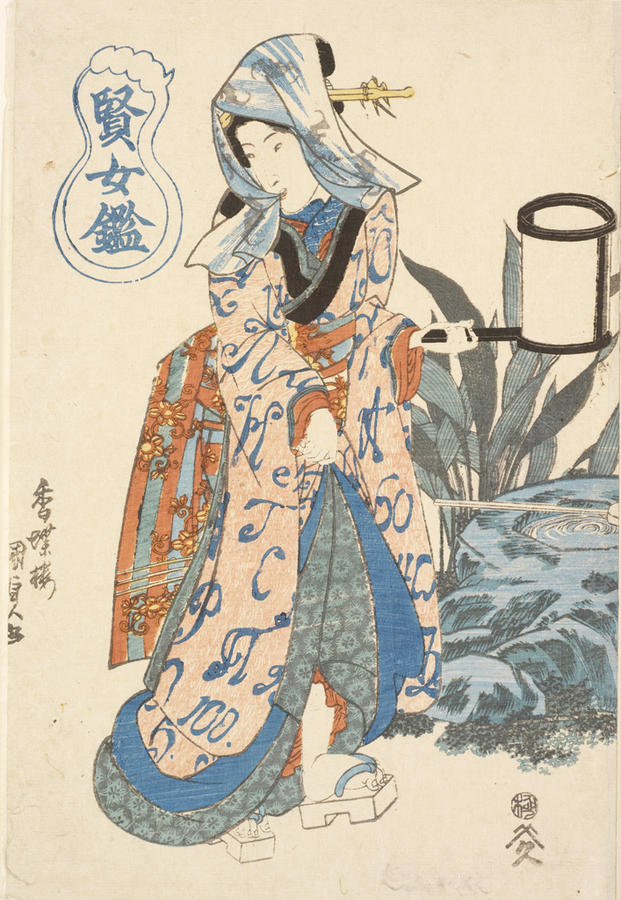
RISDM 13-1383
They all have a background of hail patterns (Arare-ko-mon) [霰小紋], similar to Kunisada’s Iwai Kumesaburō II as An no Heibei [SVJP-0304.2019], see below.Yukari no Edo-zakura The tatami night robe of Iwao Tangled Hair and the Evening Braided Hat 
-
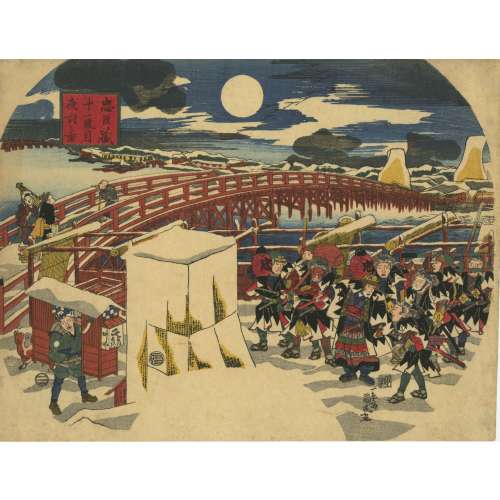 Artist: Utagawa Kunimaru [歌川国丸] (Japanese, 1794 – 1829). Publisher: Ibaya Senzaburō [伊場屋 仙三郎] (fl. 1815 – 1869). Date-kiwame seal: Bunsei 10 (1827). Signed: Ichiensai Kunimaru ga [一円斎国丸画]. Play: Chūshingura [忠臣蔵] (The Treasury of Loyal Retainers), 11th act, Night Battle [十一段目夜討之図]. Act XI: The Attack on Kō no Moronao Mansion. Kō no Moronao [高 師直] (Japanese, d. 1351). Ref: Ako City Museum of History Inscription on the soba peddler box: Nihachi soba udon [二八そば うどん] – twice eight soba and udon (16 mon per serving).
Artist: Utagawa Kunimaru [歌川国丸] (Japanese, 1794 – 1829). Publisher: Ibaya Senzaburō [伊場屋 仙三郎] (fl. 1815 – 1869). Date-kiwame seal: Bunsei 10 (1827). Signed: Ichiensai Kunimaru ga [一円斎国丸画]. Play: Chūshingura [忠臣蔵] (The Treasury of Loyal Retainers), 11th act, Night Battle [十一段目夜討之図]. Act XI: The Attack on Kō no Moronao Mansion. Kō no Moronao [高 師直] (Japanese, d. 1351). Ref: Ako City Museum of History Inscription on the soba peddler box: Nihachi soba udon [二八そば うどん] – twice eight soba and udon (16 mon per serving). -
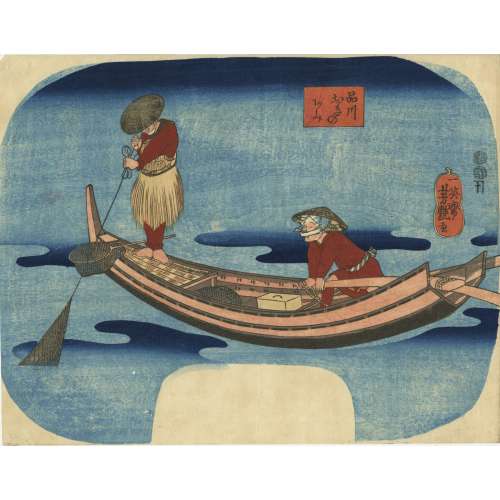 Artist: Utagawa Yoshitsuya [歌川 芳艶] (Japanese, 1822 – 1866). Publisher: Kojimaya Jūbei [小島屋重兵衛] (Japanese, c. 1797 – 1869). Date seal and double nanushi censor seals: Kunigasa & Yoshimura, Kōka 5 (1849). Signed: Ichieisai Yoshitsuya ga [英斎芳艶画] in a red double gourd cartouche. Two men are fishing with a net off the coast of Shinagawa, in the Edo Bay.
Artist: Utagawa Yoshitsuya [歌川 芳艶] (Japanese, 1822 – 1866). Publisher: Kojimaya Jūbei [小島屋重兵衛] (Japanese, c. 1797 – 1869). Date seal and double nanushi censor seals: Kunigasa & Yoshimura, Kōka 5 (1849). Signed: Ichieisai Yoshitsuya ga [英斎芳艶画] in a red double gourd cartouche. Two men are fishing with a net off the coast of Shinagawa, in the Edo Bay. -
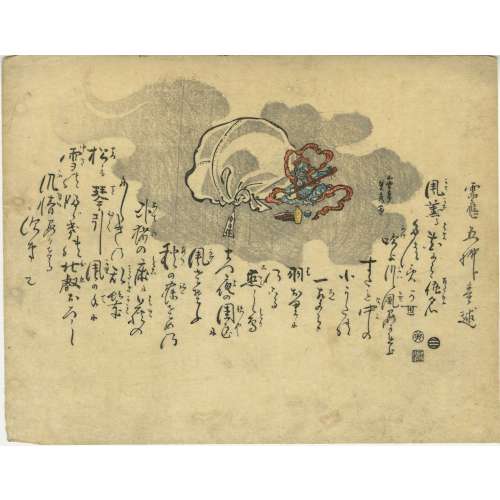 Artist: Utagawa Sadahide [歌川 貞秀] (Japanese, 1807 – c. 1878-9). Publisher: Ibaya Senzaburō [伊場屋仙三郎] (Japanese, c. 1815 – 1869). Date-kiwame seal: 1831 (Tenpō 2). Size: Uchiwa-e, 298 x 232 mm. Signed: 五雲亭 貞秀 (Gountei Sadahide) A pair of uncut fan prints with the god of wind and the god of thunder meant to be pasted on two sides of a uchiwa fan. This is an allusion to the famous painting Wind God & Thunder God [Fujin Raijin, 風神雷神図] by Ogata Korin [尾形光琳] (1658 - 1716).
Artist: Utagawa Sadahide [歌川 貞秀] (Japanese, 1807 – c. 1878-9). Publisher: Ibaya Senzaburō [伊場屋仙三郎] (Japanese, c. 1815 – 1869). Date-kiwame seal: 1831 (Tenpō 2). Size: Uchiwa-e, 298 x 232 mm. Signed: 五雲亭 貞秀 (Gountei Sadahide) A pair of uncut fan prints with the god of wind and the god of thunder meant to be pasted on two sides of a uchiwa fan. This is an allusion to the famous painting Wind God & Thunder God [Fujin Raijin, 風神雷神図] by Ogata Korin [尾形光琳] (1658 - 1716). And the earlier versions of the same by Tawaraya Sotatsu [俵屋宗達] (1570-1643).
And the earlier versions of the same by Tawaraya Sotatsu [俵屋宗達] (1570-1643).
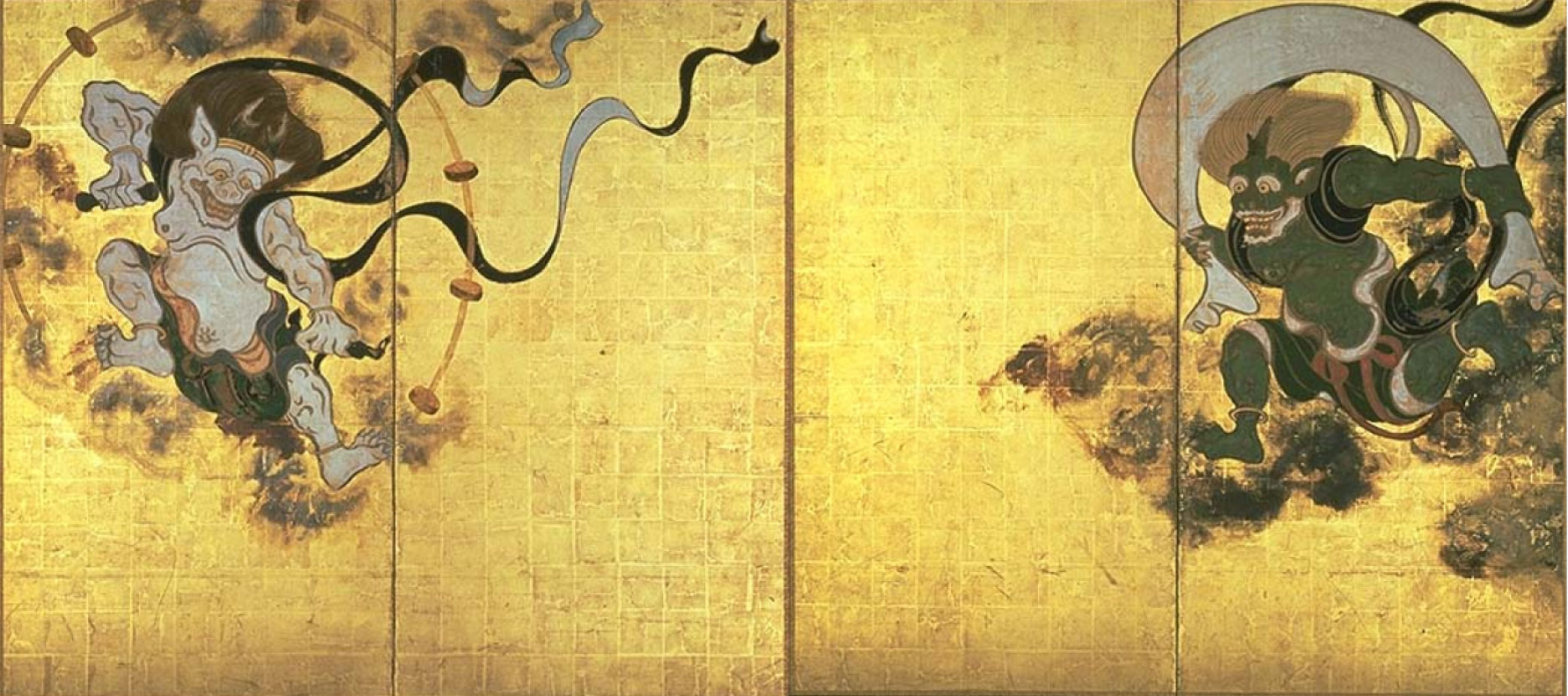
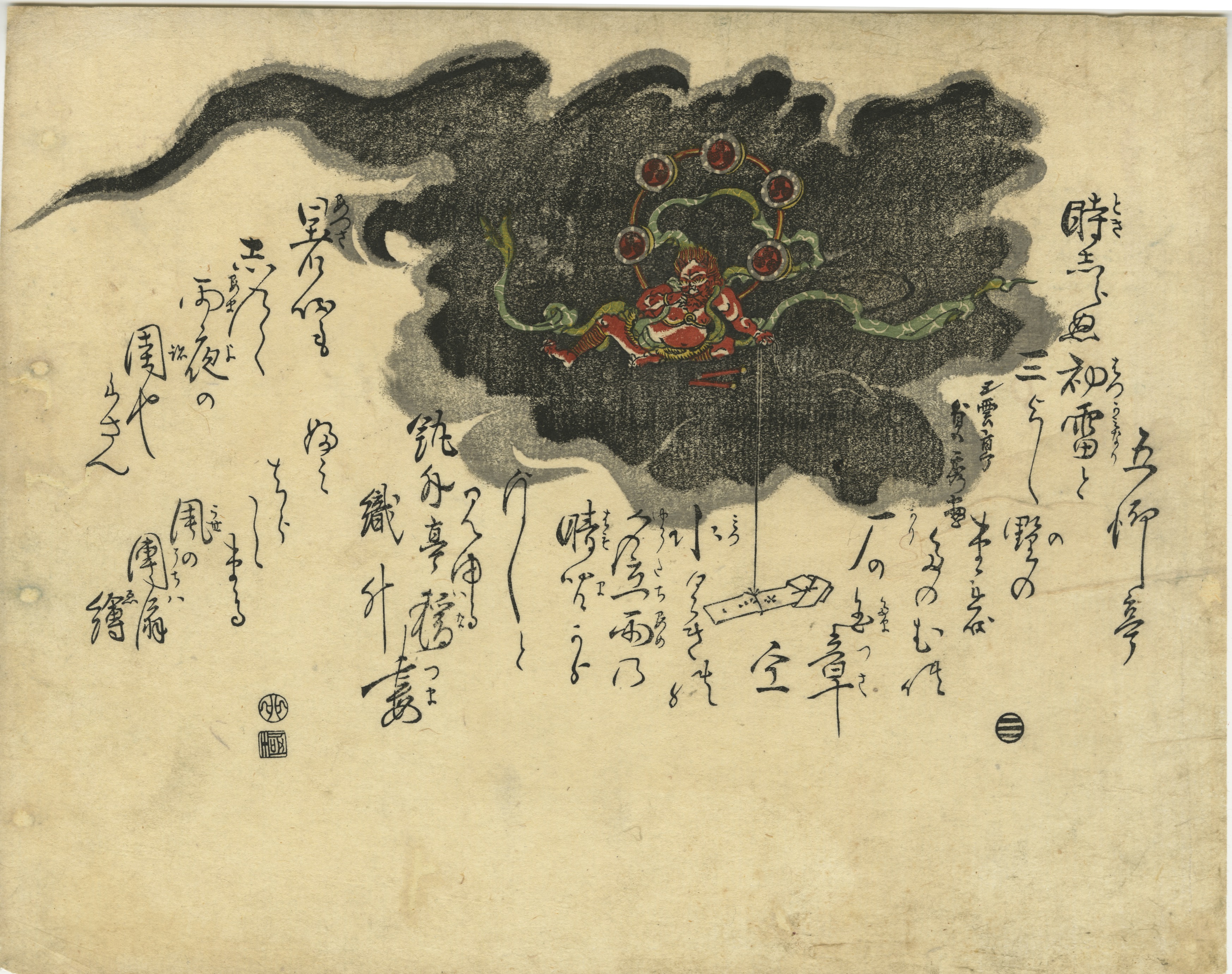
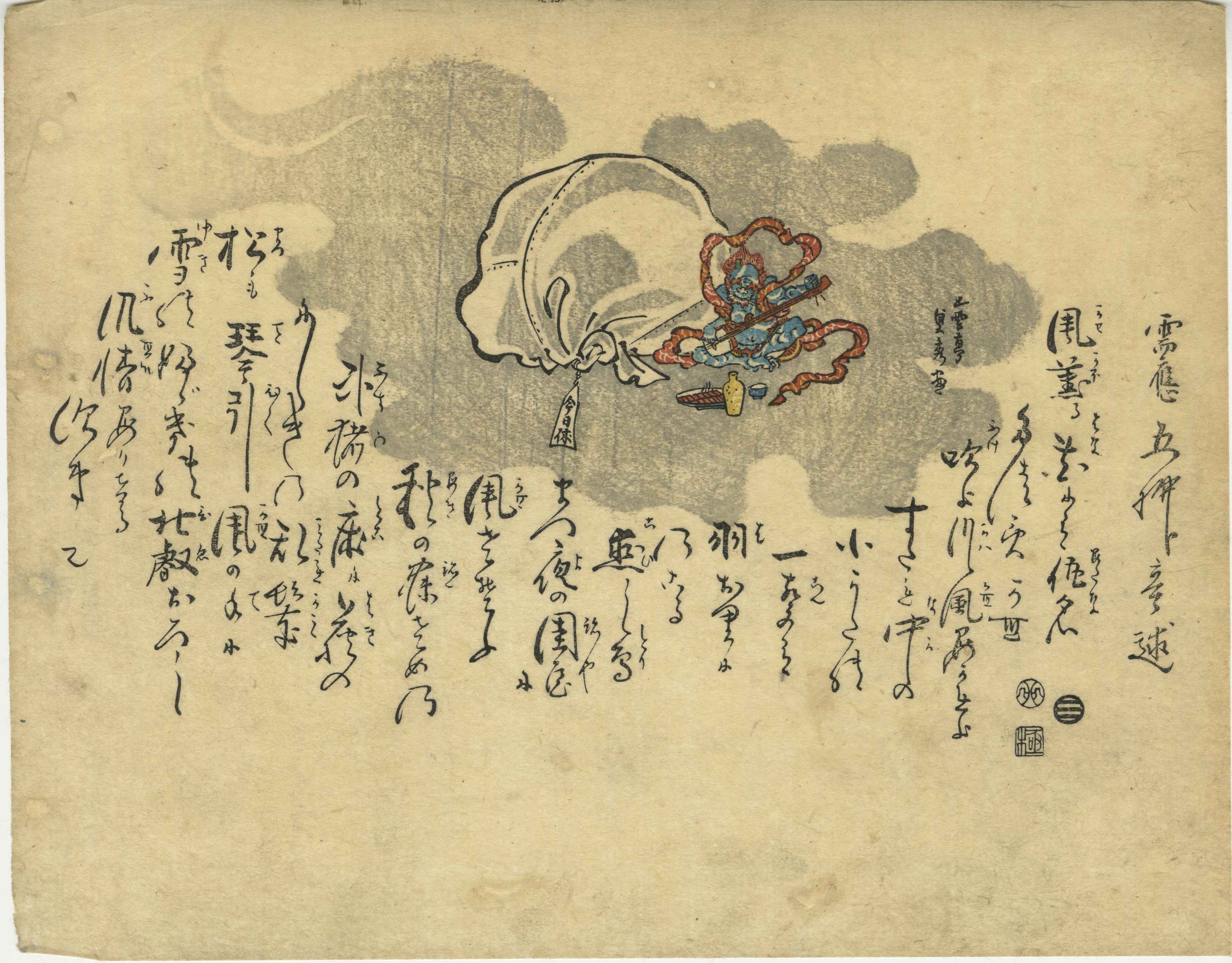
-
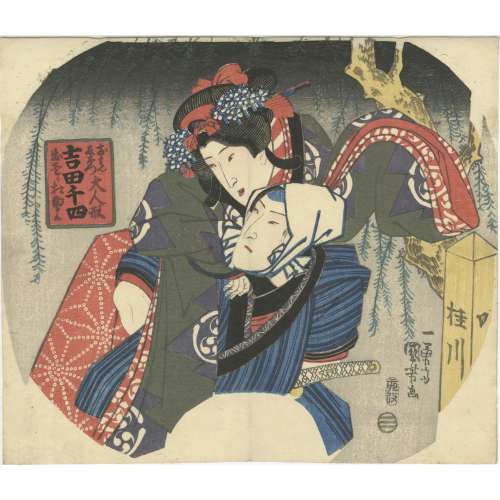 Artist: Utagawa Kuniyoshi [歌川 國芳] (Japanese, 1798 – 1861). Publisher: Ibaya Senzaburō [伊場屋仙三郎] (Japanese, c. 1815 – 1869). Date-aratame seal: 1827 (Bunsei 10). Inscription: Ohan [おはん], Chōemon [長右衛門] | Dainingyō [大人形] | Yoshida Senshi [吉田千四)] | unclear (work in progress). Sam. L. Leiter describes the play in his Kabuki Encyclopedia (1979) p. 183, and Japanese traditional theatre (2014), p. 252 as "Love Suicide of Ohan and Choemon at the Katsura River" (Katsuragawa Renri no Shigarami) [桂川連理柵], a two-act play by Suga Sensuke [菅専助] (ca. 1728 – 1791) written in 1776 for the puppet theatre jūruri and adopted for Osaka kabuki in 1777. Yoshida Senshi, a.k.a. Yoshida Bunzaburo III was a Japanese puppeteer of a Yoshida lineage. The line was established by Yoshida Bunzaburō I [吉田文三郎] (Japanese, fl. 1717 – 1760), who was one of the greatest in the history of Bunraku [人形浄瑠璃] (ningyō jōruri) and who around 1734 introduced the three-man puppet manipulation system. A portrait of Yoshida Senshi, who died in 1829, can be found in the Kunisada's triptych at Jordan Schnitzer Museum of Art, ID Number 2016:37.2.).
Artist: Utagawa Kuniyoshi [歌川 國芳] (Japanese, 1798 – 1861). Publisher: Ibaya Senzaburō [伊場屋仙三郎] (Japanese, c. 1815 – 1869). Date-aratame seal: 1827 (Bunsei 10). Inscription: Ohan [おはん], Chōemon [長右衛門] | Dainingyō [大人形] | Yoshida Senshi [吉田千四)] | unclear (work in progress). Sam. L. Leiter describes the play in his Kabuki Encyclopedia (1979) p. 183, and Japanese traditional theatre (2014), p. 252 as "Love Suicide of Ohan and Choemon at the Katsura River" (Katsuragawa Renri no Shigarami) [桂川連理柵], a two-act play by Suga Sensuke [菅専助] (ca. 1728 – 1791) written in 1776 for the puppet theatre jūruri and adopted for Osaka kabuki in 1777. Yoshida Senshi, a.k.a. Yoshida Bunzaburo III was a Japanese puppeteer of a Yoshida lineage. The line was established by Yoshida Bunzaburō I [吉田文三郎] (Japanese, fl. 1717 – 1760), who was one of the greatest in the history of Bunraku [人形浄瑠璃] (ningyō jōruri) and who around 1734 introduced the three-man puppet manipulation system. A portrait of Yoshida Senshi, who died in 1829, can be found in the Kunisada's triptych at Jordan Schnitzer Museum of Art, ID Number 2016:37.2.).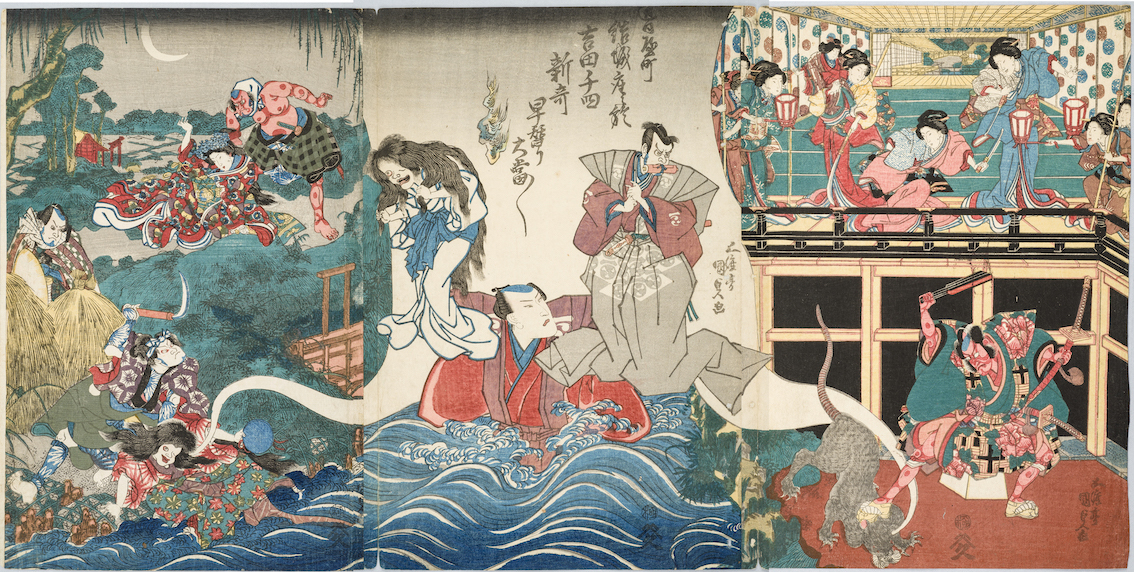 The design on our fan print looks very much like the one of Toyokuni I at MFA (Houston): OBJECT NUMBER 2006.378. "Seki Sanjuro as Obiya Choemon and Ichikawa Denzo as Ohan of the Shinonoya from the Kabuki Drama Katsuragawa renri no shigarami (Love Suicide of Ohan and Choemon at the Katsura River)", according to MFA-H published by someone Tsuruya in c. 1810 (though the publisher's seal is Suzuki Ihei [鈴木伊兵衛] (seal name Suzui [鈴伊]), Marks 01-028 | 502; the censor's seal is gyōji, date 1811-14).
The design on our fan print looks very much like the one of Toyokuni I at MFA (Houston): OBJECT NUMBER 2006.378. "Seki Sanjuro as Obiya Choemon and Ichikawa Denzo as Ohan of the Shinonoya from the Kabuki Drama Katsuragawa renri no shigarami (Love Suicide of Ohan and Choemon at the Katsura River)", according to MFA-H published by someone Tsuruya in c. 1810 (though the publisher's seal is Suzuki Ihei [鈴木伊兵衛] (seal name Suzui [鈴伊]), Marks 01-028 | 502; the censor's seal is gyōji, date 1811-14).
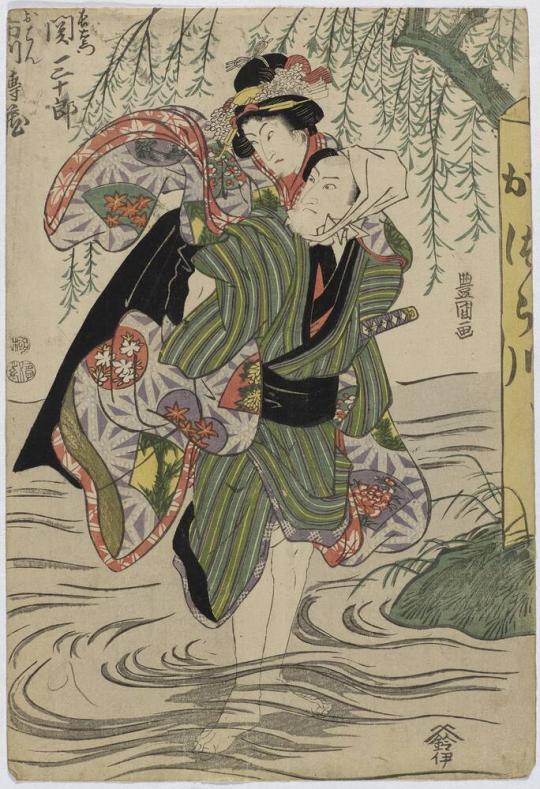 Interestingly enough, the description provided by Kuniyoshi Project is this "Actors: Onoe Kikugorô III as Shinanoya Ohan (おはん, female) and Ichikawa Ebizô V as Obiya Choemon (長右衛門, male). Play: Go chumon shusu no Obiya (御注文繻子帯屋). Date: 3rd month of 1840. Theater: Kawarasaki. Publisher: Iba-ya Sensaburô".
The play Go chumon shusu no Obiya was indeed staged at Kawarazaki theatre in 1840 (Tenpō 11), 3rd month; Ichikawa Ebizō V was indeed playing Obiya Choemon but Onoe Kikugorō III had the role of Kataoka Kōzaemon, not of Ohan, as can be seen on Kunisada's diptych at MFA (Boston): ACCESSION NUMBER 11.40671a-b.
Interestingly enough, the description provided by Kuniyoshi Project is this "Actors: Onoe Kikugorô III as Shinanoya Ohan (おはん, female) and Ichikawa Ebizô V as Obiya Choemon (長右衛門, male). Play: Go chumon shusu no Obiya (御注文繻子帯屋). Date: 3rd month of 1840. Theater: Kawarasaki. Publisher: Iba-ya Sensaburô".
The play Go chumon shusu no Obiya was indeed staged at Kawarazaki theatre in 1840 (Tenpō 11), 3rd month; Ichikawa Ebizō V was indeed playing Obiya Choemon but Onoe Kikugorō III had the role of Kataoka Kōzaemon, not of Ohan, as can be seen on Kunisada's diptych at MFA (Boston): ACCESSION NUMBER 11.40671a-b.
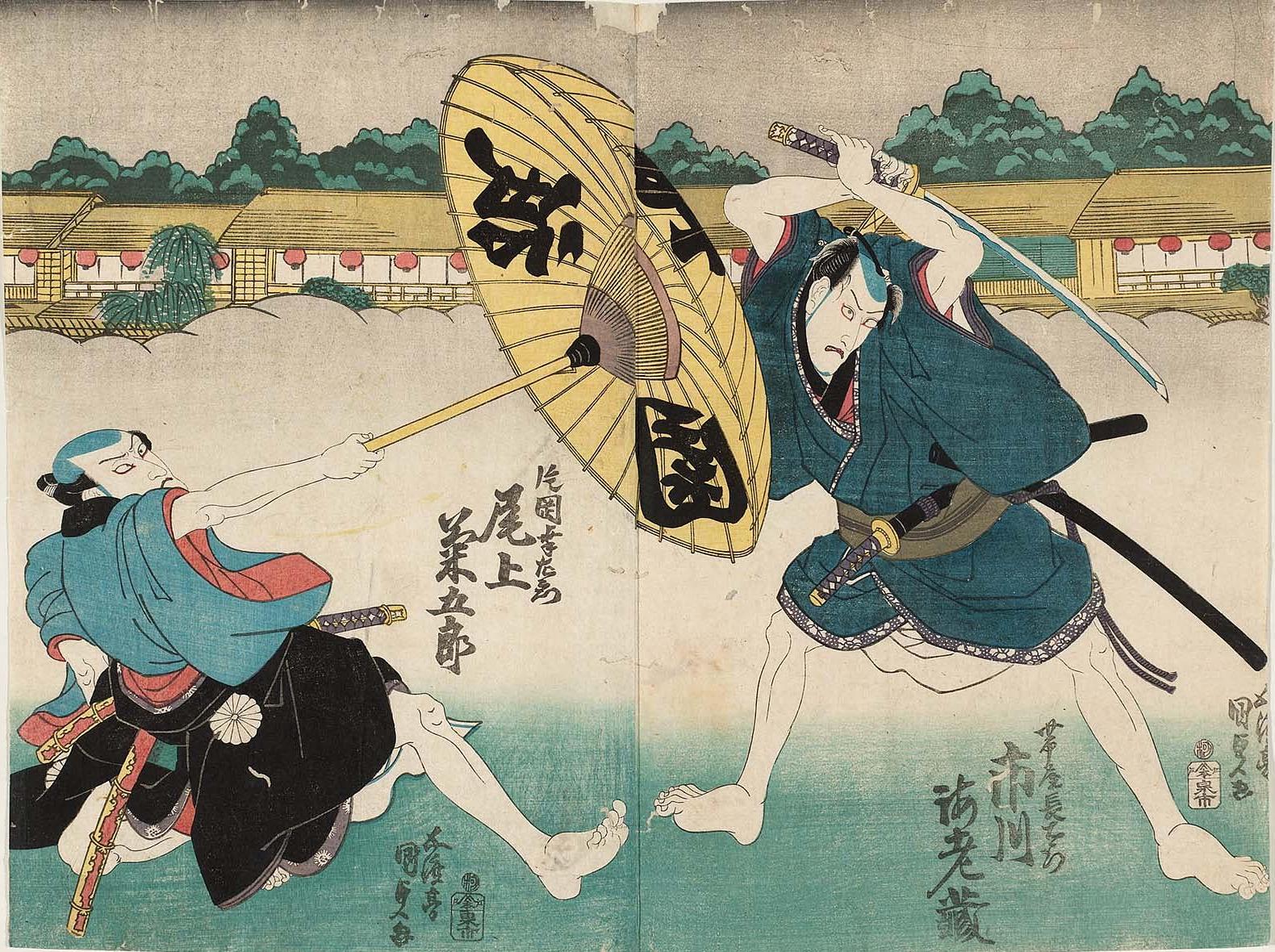
Actors Ichikawa Ebizô V as Obiya Chôemon (R) and Onoe Kikugorô III as Kataoka Kôzaemon (L)
-
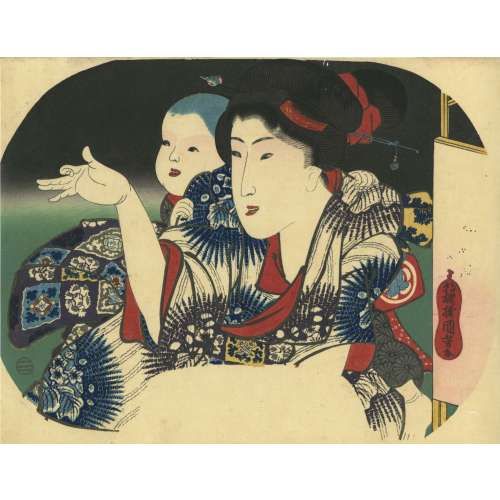 Artist: Utagawa Kuniyoshi [歌川 國芳] (Japanese, 1798 – 1861). Publisher: Ibaya Senzaburō [伊場屋仙三郎] (Japanese, c. 1815 – 1869). Published in c. 1845 (no seal). Possibly, from the "Untitled series of beauties reflected in mirrors", see Kunisada Project. However, this print does not have the seal of the censor Tanaka [田中].
Artist: Utagawa Kuniyoshi [歌川 國芳] (Japanese, 1798 – 1861). Publisher: Ibaya Senzaburō [伊場屋仙三郎] (Japanese, c. 1815 – 1869). Published in c. 1845 (no seal). Possibly, from the "Untitled series of beauties reflected in mirrors", see Kunisada Project. However, this print does not have the seal of the censor Tanaka [田中]. -
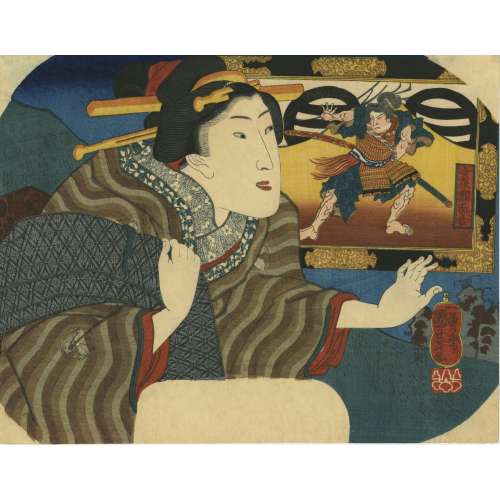 Artist: Utagawa Kuniyoshi [歌川 國芳] (Japanese, 1798 – 1861). Publisher: Izuzen (fl. c. 1800s – 1840s) (Marks 06-029|U103b). Signed: Ichiyosai Kuniyoshi ga in a red cartouche and sealed with paulownia crest (kiri mon). Double nanushi censor seals: Fuku & Muramatsu, 1849-51 (Kaei 2 – Kaei 4). Young woman in front of the western-style framed portrait of Soga Tokimune, who is depicted after having his kusazuri ripped off by Asahina Saburō. The series of fan prints A Collection of Pictures in Modern Style [今様額面合] (Imayô gakumen awase) can be found at Kuniyoshi Project. Soga Tokimune, a.k.a. Soga no Gorō [曾我時致] (Japanese, 1174 – 1193), a historical figure and a character of an epic tale Soga Monogatari [曽我物語] (A Tale of Soga Brothers). Asahina Saburō [朝比奈 三朗], a.k.a. Asahina Yoshihide [朝比奈 義秀] is also mentioned in the Soga Monogatari. Kusazuri [草摺] (くさずり) – tassets on a suit of a samurai's armour. Another Kuniyoshi's print with the same characters: Goro Tokimune and Asahina Saburo; Series: The Tale of Soga Brothers; Publisher: Ibaya Senzaburō; Date: 1843-1845; Size: Vertical Ōban: 359 x 245 mm.
Artist: Utagawa Kuniyoshi [歌川 國芳] (Japanese, 1798 – 1861). Publisher: Izuzen (fl. c. 1800s – 1840s) (Marks 06-029|U103b). Signed: Ichiyosai Kuniyoshi ga in a red cartouche and sealed with paulownia crest (kiri mon). Double nanushi censor seals: Fuku & Muramatsu, 1849-51 (Kaei 2 – Kaei 4). Young woman in front of the western-style framed portrait of Soga Tokimune, who is depicted after having his kusazuri ripped off by Asahina Saburō. The series of fan prints A Collection of Pictures in Modern Style [今様額面合] (Imayô gakumen awase) can be found at Kuniyoshi Project. Soga Tokimune, a.k.a. Soga no Gorō [曾我時致] (Japanese, 1174 – 1193), a historical figure and a character of an epic tale Soga Monogatari [曽我物語] (A Tale of Soga Brothers). Asahina Saburō [朝比奈 三朗], a.k.a. Asahina Yoshihide [朝比奈 義秀] is also mentioned in the Soga Monogatari. Kusazuri [草摺] (くさずり) – tassets on a suit of a samurai's armour. Another Kuniyoshi's print with the same characters: Goro Tokimune and Asahina Saburo; Series: The Tale of Soga Brothers; Publisher: Ibaya Senzaburō; Date: 1843-1845; Size: Vertical Ōban: 359 x 245 mm.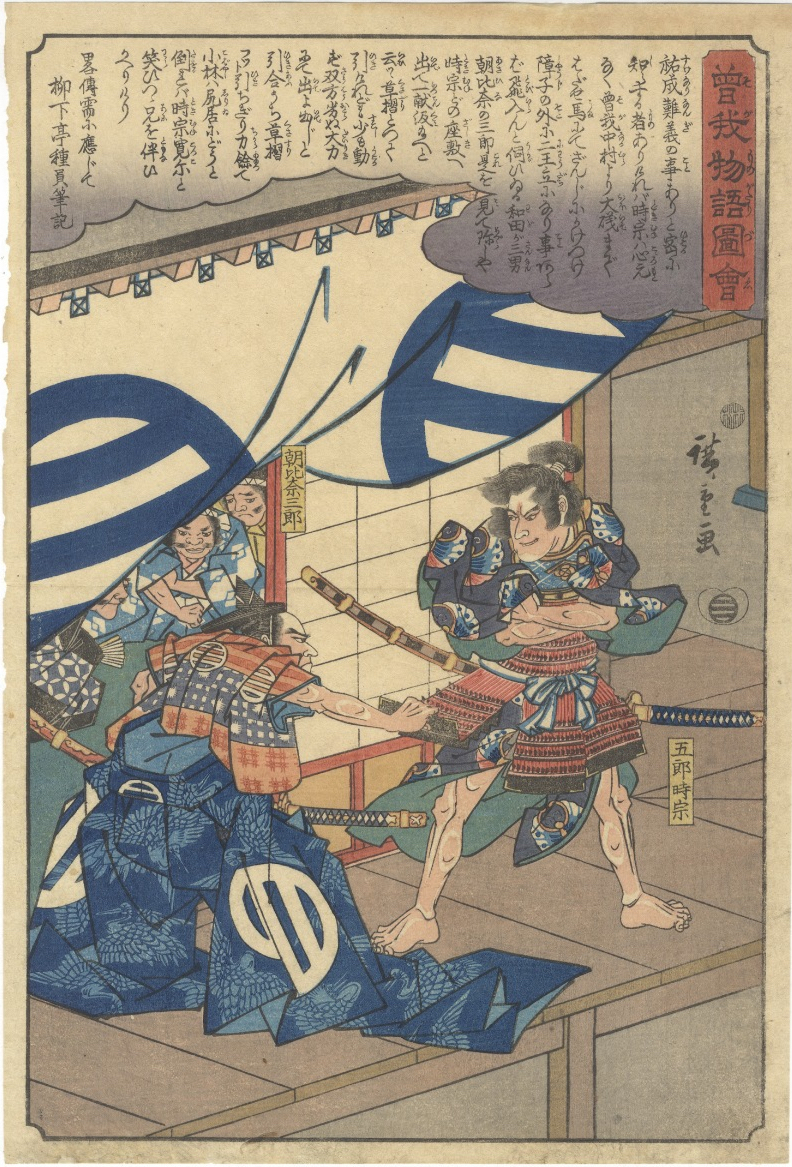
-
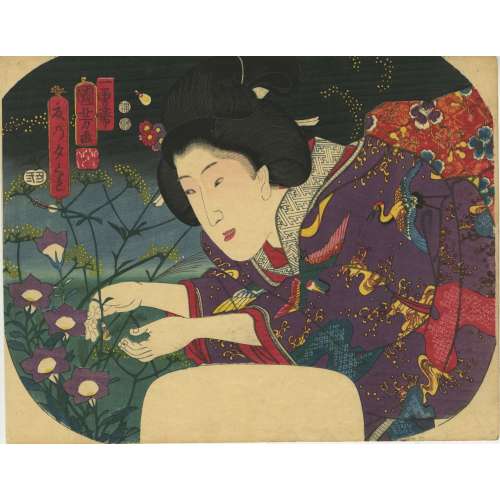 Artist: Utagawa Kuniyoshi [歌川 國芳] (Japanese, 1798 – 1861). Publisher: Enshuya Matabei [遠州屋又兵衛] (Japanese, fl. c. 178 – 1881) – no seal, ref: Kunisada Project. Title: A Summer Evening [夏乃夕暮] (Natsu no Yūgure). A young woman in purple kimono decorated with cranes and waves catching a firefly among yellow and purple flowers. Signed: Ichiyosai Kuniyoshi ga [一勇斎 国芳 画] in a red cartouche and sealed with paulownia (kiri mon). Date seal and double nanushi censor seals: Fuku & Muramatsu, 1853 (Kaei 6, 2nd month). No publisher's seal. Size: Uchiwa-e (untrimmed fan print) 228 x 296 mm. The yellow flower is probably Patrinia scabiosifolia (ominaeshi) [女郎花]. The purple flower seems to be Platycodon grandiflorus or Balloon Flower (kikyō) [桔梗]. Besides, there are visible panicles of Miscanthus sinensis, or Japanese pampas grass (susuki) [薄]. These three are part of the Seven Grasses of Autumn (aki no nanakusa) [秋の七草].
Artist: Utagawa Kuniyoshi [歌川 國芳] (Japanese, 1798 – 1861). Publisher: Enshuya Matabei [遠州屋又兵衛] (Japanese, fl. c. 178 – 1881) – no seal, ref: Kunisada Project. Title: A Summer Evening [夏乃夕暮] (Natsu no Yūgure). A young woman in purple kimono decorated with cranes and waves catching a firefly among yellow and purple flowers. Signed: Ichiyosai Kuniyoshi ga [一勇斎 国芳 画] in a red cartouche and sealed with paulownia (kiri mon). Date seal and double nanushi censor seals: Fuku & Muramatsu, 1853 (Kaei 6, 2nd month). No publisher's seal. Size: Uchiwa-e (untrimmed fan print) 228 x 296 mm. The yellow flower is probably Patrinia scabiosifolia (ominaeshi) [女郎花]. The purple flower seems to be Platycodon grandiflorus or Balloon Flower (kikyō) [桔梗]. Besides, there are visible panicles of Miscanthus sinensis, or Japanese pampas grass (susuki) [薄]. These three are part of the Seven Grasses of Autumn (aki no nanakusa) [秋の七草]. -
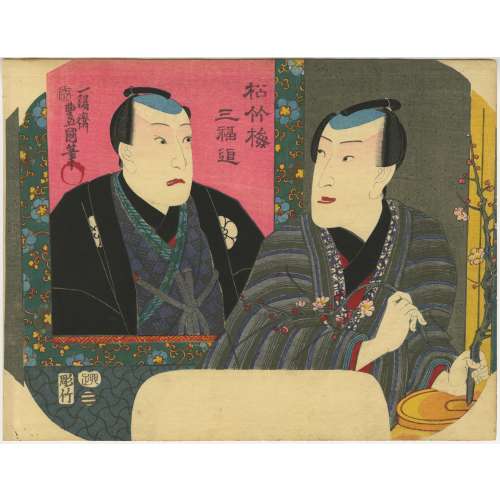 Artist: Utagawa Kunisada [歌川 国貞] a.k.a. Utagawa Toyokuni III [三代歌川豊国] (Japanese, 1786 – 1865). Signed: Ichiyōsai Toyokuni hitsu [一陽斎豊国筆]. Inscriptions: [松竹梅] Shochikubai = pine (matsu, 松), bamboo (take, 竹), and plum (ume, 梅) – an auspicious grouping known as "The Three Friends of Winter"; [三福追] (Sanpuku tsui) – the three delights, or pleasures. Date seal and aratame censor seal: Ansei 2, 1st month (1855). Publisher: Ibaya Senzaburō [伊場屋仙三郎] (Japanese, c. 1815 – 1869). Block carver: Yokokawa Takejirō [横川竹二郎] (Japanese, fl. 1845 – 1863); seal: Hori Take [彫竹]. Kabuki actor Nakamura Shikan IV [中村芝翫] (Nakamura Fukusuke I [中村福助], Nakamura Masanosuke I, Nakamura Komasaburō, Nakamura Tamatarō I, Japanese, 1831 – 1899) arranging a branch of blossoming plum to the memorial portrait of his predecessor Nakamura Utaemon IV [中村歌右衛門] (Nakamura Shikan II, Nakamura Tsurusuke I, Nakamura Tōtarō, Japanese, 1796 – 1852); the latter is dressed in a black robe adorned with a mokkō-crest (mon) of white plum blossom, the hanging scroll border decorated with arabesque and plum blossoms. Actors identified by Horst Graebner. Two fan prints from this series in Varshavsky Collection:
Artist: Utagawa Kunisada [歌川 国貞] a.k.a. Utagawa Toyokuni III [三代歌川豊国] (Japanese, 1786 – 1865). Signed: Ichiyōsai Toyokuni hitsu [一陽斎豊国筆]. Inscriptions: [松竹梅] Shochikubai = pine (matsu, 松), bamboo (take, 竹), and plum (ume, 梅) – an auspicious grouping known as "The Three Friends of Winter"; [三福追] (Sanpuku tsui) – the three delights, or pleasures. Date seal and aratame censor seal: Ansei 2, 1st month (1855). Publisher: Ibaya Senzaburō [伊場屋仙三郎] (Japanese, c. 1815 – 1869). Block carver: Yokokawa Takejirō [横川竹二郎] (Japanese, fl. 1845 – 1863); seal: Hori Take [彫竹]. Kabuki actor Nakamura Shikan IV [中村芝翫] (Nakamura Fukusuke I [中村福助], Nakamura Masanosuke I, Nakamura Komasaburō, Nakamura Tamatarō I, Japanese, 1831 – 1899) arranging a branch of blossoming plum to the memorial portrait of his predecessor Nakamura Utaemon IV [中村歌右衛門] (Nakamura Shikan II, Nakamura Tsurusuke I, Nakamura Tōtarō, Japanese, 1796 – 1852); the latter is dressed in a black robe adorned with a mokkō-crest (mon) of white plum blossom, the hanging scroll border decorated with arabesque and plum blossoms. Actors identified by Horst Graebner. Two fan prints from this series in Varshavsky Collection: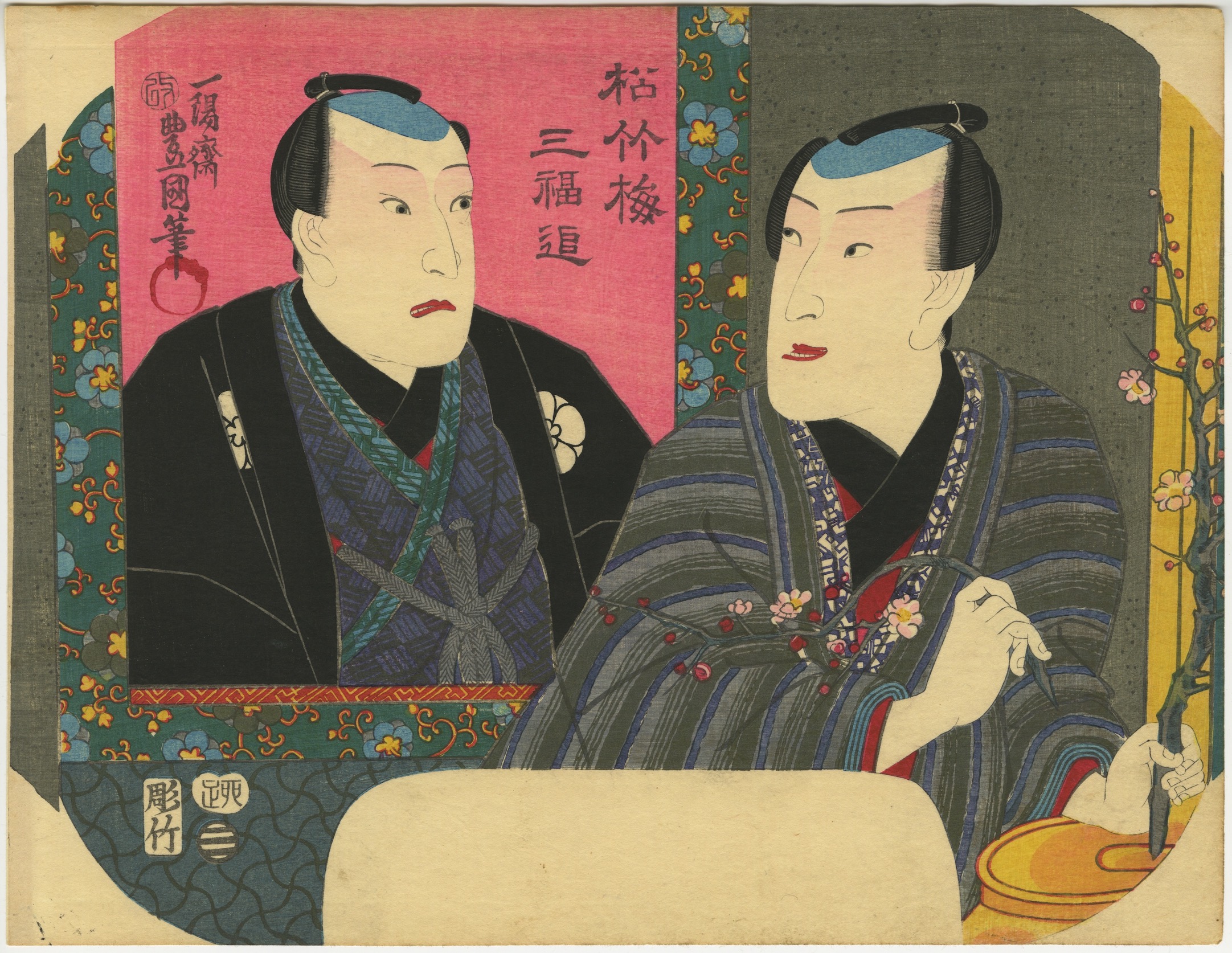
SVJP-0336.2021
-
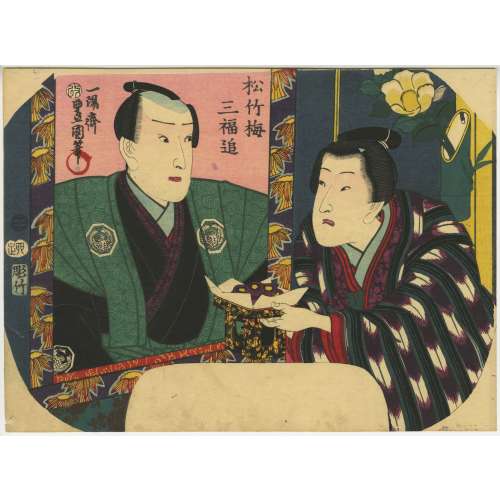 Artist: Utagawa Kunisada [歌川 国貞] a.k.a. Utagawa Toyokuni III [三代歌川豊国] (Japanese, 1786 – 1865). Signed: Ichiyōsai Toyokuni hitsu [一陽斎豊国筆]. Inscriptions: [松竹梅] Shochikubai = pine (matsu, 松), bamboo (take, 竹), and plum (ume, 梅) – an auspicious grouping known as “The Three Friends of Winter“; [三福追] (Sanpuku tsui) – the three delights, or pleasures. Date seal and aratame censor seal: Ansei 2, 1st month (1855). Publisher: Ibaya Senzaburō [伊場屋仙三郎] (Japanese, c. 1815 – 1869). Block carver: Yokokawa Takejirō [横川竹二郎] (Japanese, fl. 1845 – 1863); seal: Hori Take [彫竹]. Kabuki actor Onoe Kikugorō V [五代目尾上菊五郎] (Onoe Baikō V, Ichimura Kakitsu IV, Ichimura Uzaemon XIII, Ichimura Kurōemon, Japanese, 1844 – 1903) giving candies to the memorial portrait of his predecessor, Ichimura Takenojō V [市村竹之丞] (Ichimura Uzaemon XII, Ichimura Kamenosuke, Ichimura Toyomatsu, Japanese, 1812 – 1851); the latter is dressed in a green robe adorned with a crest (mon) of a kōrin-style crane in a tortoiseshell (octagon), the hanging scroll border decorated with bamboo under snow; the collar of Onoe's kimono decorated with plum blossoms, another plum blossom arrangement decorates the screen behind him. Actors identified by Horst Graebner. Two fan prints from this series in Varshavsky Collection:
Artist: Utagawa Kunisada [歌川 国貞] a.k.a. Utagawa Toyokuni III [三代歌川豊国] (Japanese, 1786 – 1865). Signed: Ichiyōsai Toyokuni hitsu [一陽斎豊国筆]. Inscriptions: [松竹梅] Shochikubai = pine (matsu, 松), bamboo (take, 竹), and plum (ume, 梅) – an auspicious grouping known as “The Three Friends of Winter“; [三福追] (Sanpuku tsui) – the three delights, or pleasures. Date seal and aratame censor seal: Ansei 2, 1st month (1855). Publisher: Ibaya Senzaburō [伊場屋仙三郎] (Japanese, c. 1815 – 1869). Block carver: Yokokawa Takejirō [横川竹二郎] (Japanese, fl. 1845 – 1863); seal: Hori Take [彫竹]. Kabuki actor Onoe Kikugorō V [五代目尾上菊五郎] (Onoe Baikō V, Ichimura Kakitsu IV, Ichimura Uzaemon XIII, Ichimura Kurōemon, Japanese, 1844 – 1903) giving candies to the memorial portrait of his predecessor, Ichimura Takenojō V [市村竹之丞] (Ichimura Uzaemon XII, Ichimura Kamenosuke, Ichimura Toyomatsu, Japanese, 1812 – 1851); the latter is dressed in a green robe adorned with a crest (mon) of a kōrin-style crane in a tortoiseshell (octagon), the hanging scroll border decorated with bamboo under snow; the collar of Onoe's kimono decorated with plum blossoms, another plum blossom arrangement decorates the screen behind him. Actors identified by Horst Graebner. Two fan prints from this series in Varshavsky Collection: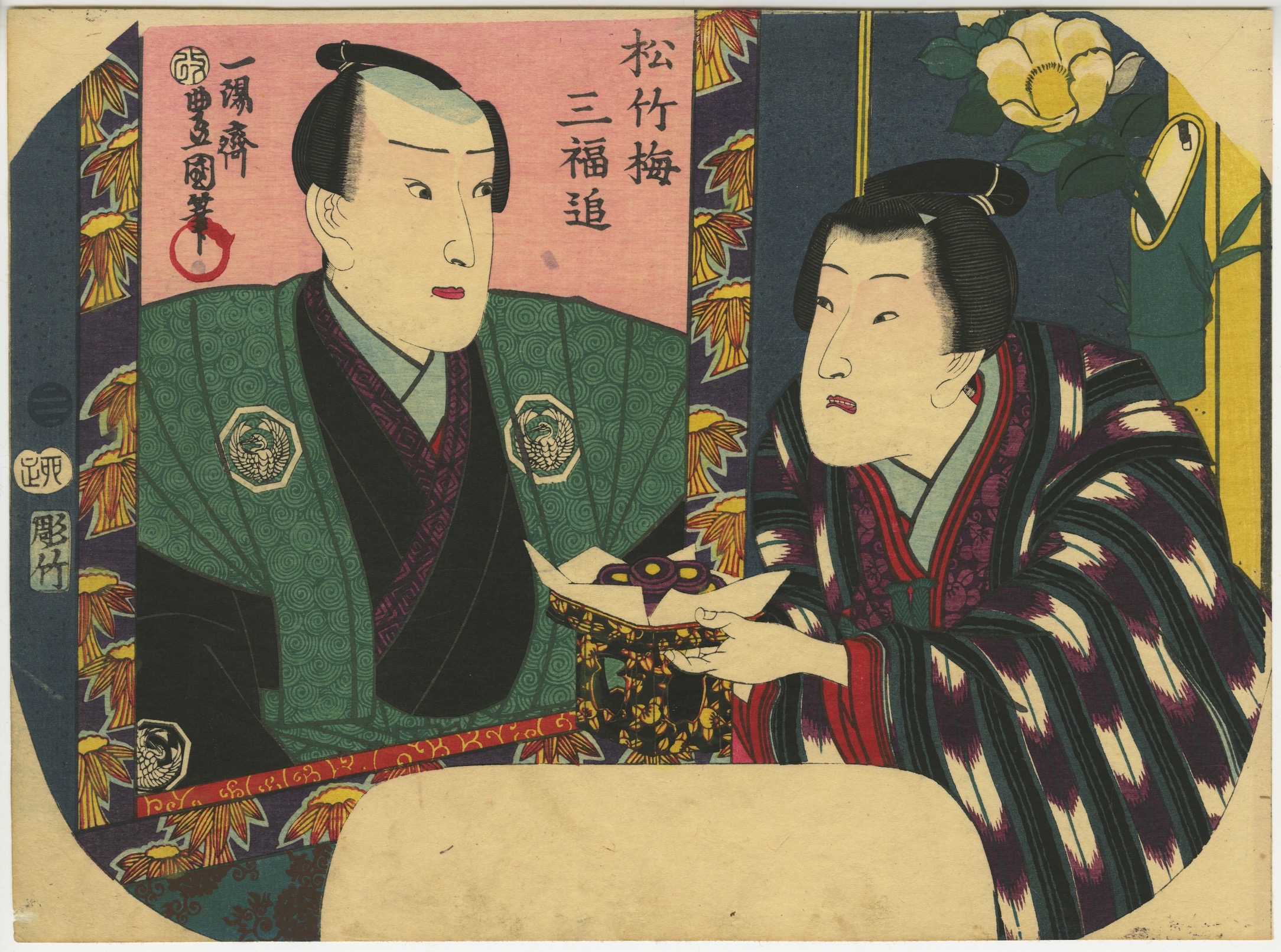
SVJP-0335.2021
-
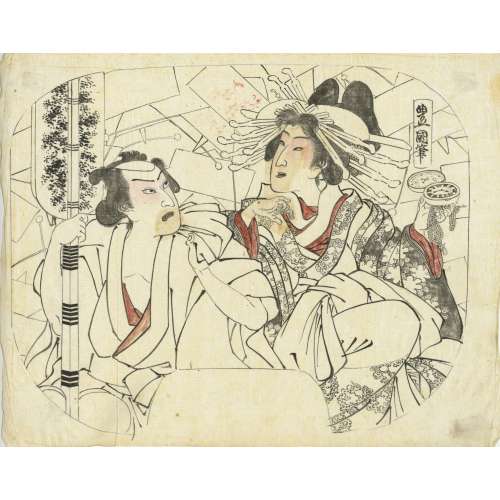 Artist: Horst Graebner positively attributes the drawing to Utagawa Kunisada II [歌川国貞] Japanese, 1823 – 1880) a.k.a. Toyokuni IV, though Israel Goldman attributes it to Utagawa Kunisada [歌川 国貞] (Japanese, 1786 – 1865) a.k.a. Utagawa Toyokuni III. Title: Geisha with a watch / Preparatory drawing for a fan print. Media/Technique: Ink and colour on paper. Signed: Toyokuni hitsu [豊国筆].
Artist: Horst Graebner positively attributes the drawing to Utagawa Kunisada II [歌川国貞] Japanese, 1823 – 1880) a.k.a. Toyokuni IV, though Israel Goldman attributes it to Utagawa Kunisada [歌川 国貞] (Japanese, 1786 – 1865) a.k.a. Utagawa Toyokuni III. Title: Geisha with a watch / Preparatory drawing for a fan print. Media/Technique: Ink and colour on paper. Signed: Toyokuni hitsu [豊国筆]. -
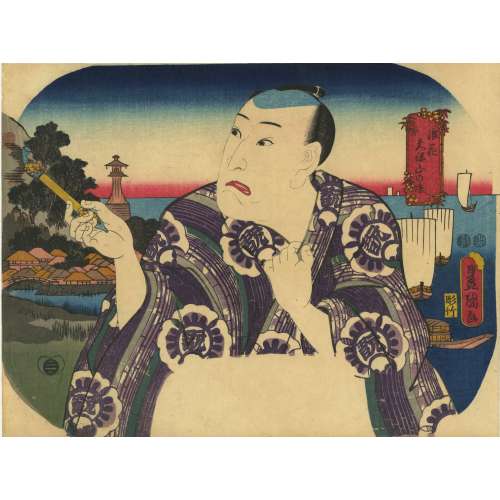 Artist: Utagawa Kunisada [歌川 国貞] a.k.a. Utagawa Toyokuni III [三代歌川豊国] (Japanese, 1786 – 1865). Signed: Toyokuni ga [豊国 画] in a red toshidama cartouche. Publisher: Ibaya Senzaburō [伊場屋仙三郎] (Japanese, c. 1815 – 1869). Block carver: Yokokawa Takejirō [横川竹二郎] (Japanese, fl. 1845 – 1863); seal Hori Take [彫竹]. Double nanushi censor seals: Mera & Murata (1847-50). Title: Cool Breeze on Tenpōzan Hill in Naniwa [浪花天保山の涼] (Naniwa Tenpōzan no ryō). An uncut fan print (uchiwa-e), depicting a gentleman (most probably kabuki actor Nakamura Utaemon IV) holding a pipe with the view of Tenpōzan Hill [天保山] in Naniwa (Osaka) in the background. A distinctive structure on the left is the Sumiyoshi Lantern [住吉高灯篭] (Sumiyoshi takadōrō), which was destroyed by a typhoon in 1950. The character 翫 – moteasobu – on the gentleman’s robe means "take pleasure, play an instrument". Nakamura Utaemon IV [中村歌右衛門] (Japanese, 1796 – 1852); other names: Nakamura Shikan II, Nakamura Tsurusuke I, Nakamura Tōtarō. The character is visually similar to a gentleman drinking tea on a veranda under the shining moon from the series ‘Moon, Sun, Stars’ [月日星] (Getsu hi hoshi), see SVJP-0211-1.2016: The Moon.
Artist: Utagawa Kunisada [歌川 国貞] a.k.a. Utagawa Toyokuni III [三代歌川豊国] (Japanese, 1786 – 1865). Signed: Toyokuni ga [豊国 画] in a red toshidama cartouche. Publisher: Ibaya Senzaburō [伊場屋仙三郎] (Japanese, c. 1815 – 1869). Block carver: Yokokawa Takejirō [横川竹二郎] (Japanese, fl. 1845 – 1863); seal Hori Take [彫竹]. Double nanushi censor seals: Mera & Murata (1847-50). Title: Cool Breeze on Tenpōzan Hill in Naniwa [浪花天保山の涼] (Naniwa Tenpōzan no ryō). An uncut fan print (uchiwa-e), depicting a gentleman (most probably kabuki actor Nakamura Utaemon IV) holding a pipe with the view of Tenpōzan Hill [天保山] in Naniwa (Osaka) in the background. A distinctive structure on the left is the Sumiyoshi Lantern [住吉高灯篭] (Sumiyoshi takadōrō), which was destroyed by a typhoon in 1950. The character 翫 – moteasobu – on the gentleman’s robe means "take pleasure, play an instrument". Nakamura Utaemon IV [中村歌右衛門] (Japanese, 1796 – 1852); other names: Nakamura Shikan II, Nakamura Tsurusuke I, Nakamura Tōtarō. The character is visually similar to a gentleman drinking tea on a veranda under the shining moon from the series ‘Moon, Sun, Stars’ [月日星] (Getsu hi hoshi), see SVJP-0211-1.2016: The Moon. As noted by Horst Graebner, the gentleman also resembles the character on another Kunisada's actor print, published in 1852 (Waseda University Cultural Resources Database № 114-0232):
As noted by Horst Graebner, the gentleman also resembles the character on another Kunisada's actor print, published in 1852 (Waseda University Cultural Resources Database № 114-0232):
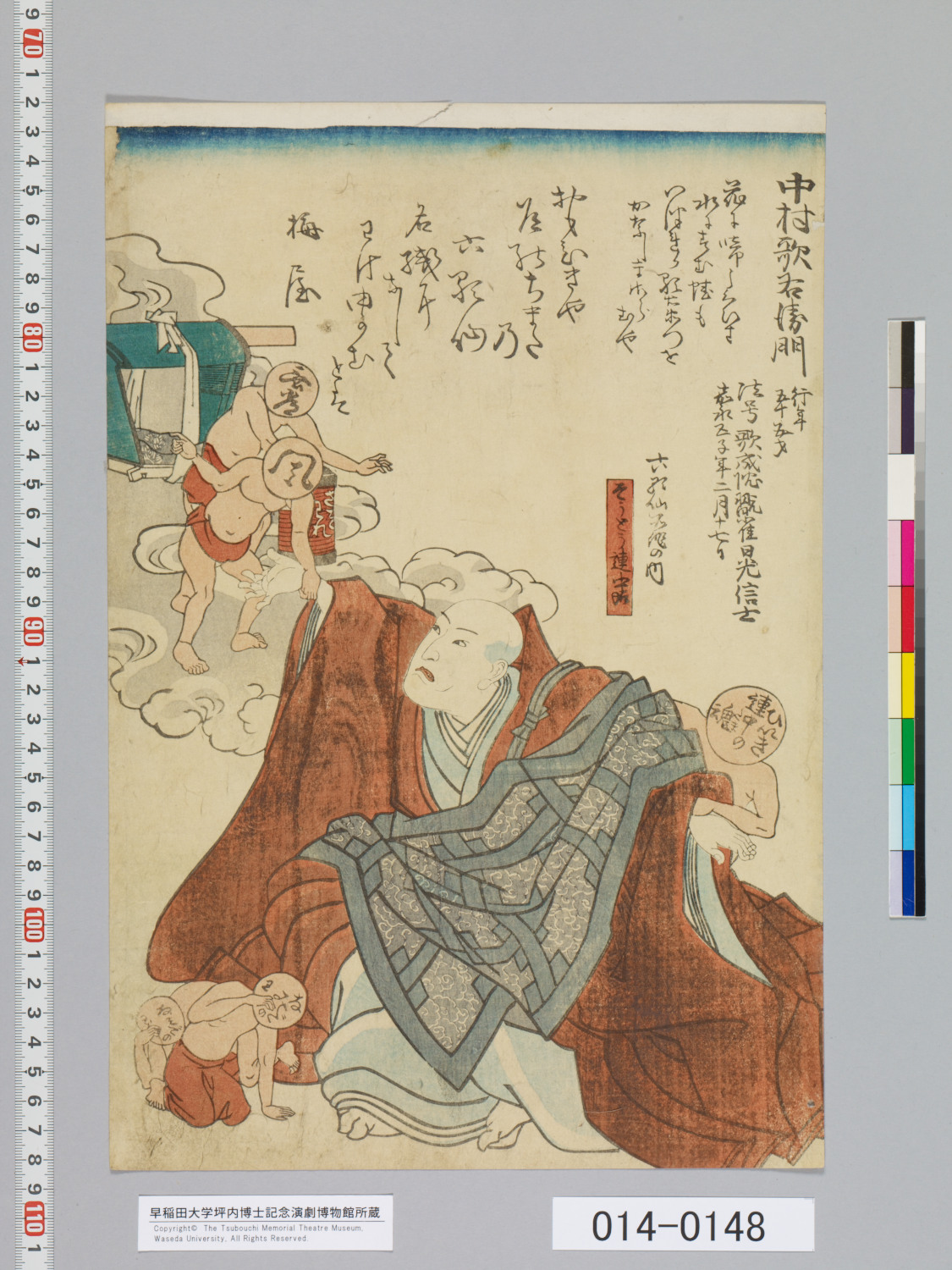
-
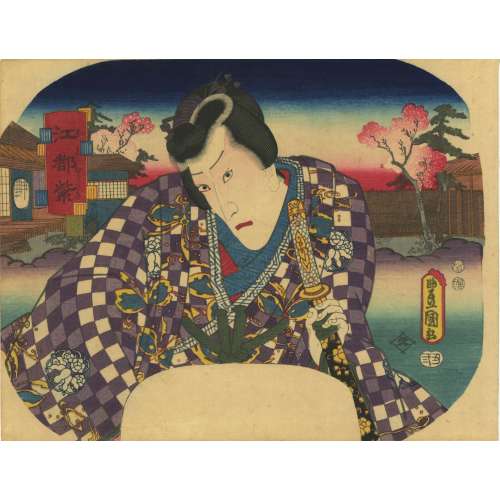 Utagawa Kunisada [歌川 国貞]; a.k.a. Utagawa Toyokuni III [三代歌川豊国] (Japanese, 1786 – 1865). Signed: Toyokuni ga [豊国 画] in a yellow toshidama cartouche. Publisher: Unknown, seal [久] Kyū (Japanese, fl. c. 1851 – 1861); (Marks 07-023 | U176a, possibly Sagamia Kyūzō). Date seal and double nanushi censor seals: Fuku & Muramatsu, Kaei 6, 2nd month (2/1853). Inscription in a red cartouche: (Purple of Edo // Purple of the Bay Capital) [江都むらさき] (Edo Murasaki), alluding to Murasaki Shikibu [紫 式部] (Japanese, c. 973/8 – c. 1014/31), the author of Genji Monogatari [源氏物語] (The Tale of Genji), a Heian period novel which was the source of a parody Nise Murasaki Inaka Genji [偐紫田舎源氏] (Fake Murasaki’s Rustic Genji) by Ryutei Tanehiko [柳亭種彦] (Japanese, 1783 – 1842). According to Horst Graebner: The actor is Ichikawa Danjūrō VIII. Ichikawa Danjūrō VIII [市川団十郎] (Japanese, 1823 – 1854); other names: Ichikawa Ebizō VI, Ichikawa Shinnosuke II. One of the series of Kunisada’s fan prints in this collection:
Utagawa Kunisada [歌川 国貞]; a.k.a. Utagawa Toyokuni III [三代歌川豊国] (Japanese, 1786 – 1865). Signed: Toyokuni ga [豊国 画] in a yellow toshidama cartouche. Publisher: Unknown, seal [久] Kyū (Japanese, fl. c. 1851 – 1861); (Marks 07-023 | U176a, possibly Sagamia Kyūzō). Date seal and double nanushi censor seals: Fuku & Muramatsu, Kaei 6, 2nd month (2/1853). Inscription in a red cartouche: (Purple of Edo // Purple of the Bay Capital) [江都むらさき] (Edo Murasaki), alluding to Murasaki Shikibu [紫 式部] (Japanese, c. 973/8 – c. 1014/31), the author of Genji Monogatari [源氏物語] (The Tale of Genji), a Heian period novel which was the source of a parody Nise Murasaki Inaka Genji [偐紫田舎源氏] (Fake Murasaki’s Rustic Genji) by Ryutei Tanehiko [柳亭種彦] (Japanese, 1783 – 1842). According to Horst Graebner: The actor is Ichikawa Danjūrō VIII. Ichikawa Danjūrō VIII [市川団十郎] (Japanese, 1823 – 1854); other names: Ichikawa Ebizō VI, Ichikawa Shinnosuke II. One of the series of Kunisada’s fan prints in this collection: -
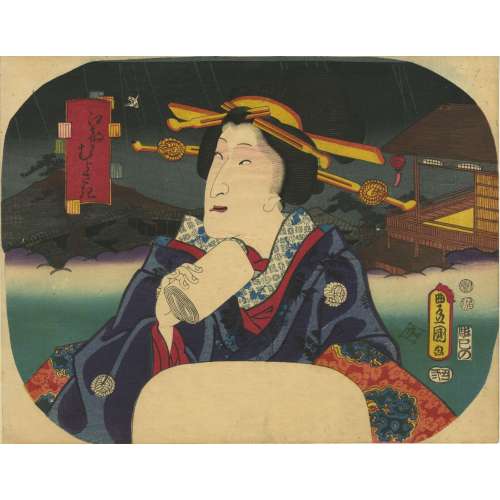 Utagawa Kunisada [歌川 国貞] a.k.a. Utagawa Toyokuni III [三代歌川豊国] (Japanese, 1786 – 1865). Signed: Toyokuni ga [豊国 画] in a yellow toshidama cartouche. Publisher: Unknown, seal [久] Kyū (Japanese, fl. c. 1851 – 1861); (Marks 07-023 | U176a, possibly Sagamia Kyūzō). Block carver: Koizumi Minokichi [小泉巳の吉] (Japanese, 1833 – 1906); seal: Hori Mino [彫已の] (Gordon Friese № 38). Date seal and double nanushi censor seals: Fuku & Muramatsu, Kaei 6, 2nd month (2/1853). Inscription in a red cartouche: (Purple of Edo // Purple of the Bay Capital) [江都むらさき] (Edo Murasaki), alluding to Murasaki Shikibu [紫 式部] (Japanese, c. 973/8 – c. 1014/31), the author of Genji Monogatari [源氏物語] (The Tale of Genji), a Heian period novel which was the source of a parody Nise Murasaki Inaka Genji [偐紫田舎源氏] (Fake Murasaki’s Rustic Genji) by Ryutei Tanehiko [柳亭種彦] (Japanese, 1783 – 1842). According to Horst Graebner: The actor is most probably Segawa Kikunojō V. Segawa Kikunojō V [瀬川菊之丞] (Japanese, 1802 – 1832); other names: Segawa Tamon I. One of the series of Kunisada's fan prints in this collection:
Utagawa Kunisada [歌川 国貞] a.k.a. Utagawa Toyokuni III [三代歌川豊国] (Japanese, 1786 – 1865). Signed: Toyokuni ga [豊国 画] in a yellow toshidama cartouche. Publisher: Unknown, seal [久] Kyū (Japanese, fl. c. 1851 – 1861); (Marks 07-023 | U176a, possibly Sagamia Kyūzō). Block carver: Koizumi Minokichi [小泉巳の吉] (Japanese, 1833 – 1906); seal: Hori Mino [彫已の] (Gordon Friese № 38). Date seal and double nanushi censor seals: Fuku & Muramatsu, Kaei 6, 2nd month (2/1853). Inscription in a red cartouche: (Purple of Edo // Purple of the Bay Capital) [江都むらさき] (Edo Murasaki), alluding to Murasaki Shikibu [紫 式部] (Japanese, c. 973/8 – c. 1014/31), the author of Genji Monogatari [源氏物語] (The Tale of Genji), a Heian period novel which was the source of a parody Nise Murasaki Inaka Genji [偐紫田舎源氏] (Fake Murasaki’s Rustic Genji) by Ryutei Tanehiko [柳亭種彦] (Japanese, 1783 – 1842). According to Horst Graebner: The actor is most probably Segawa Kikunojō V. Segawa Kikunojō V [瀬川菊之丞] (Japanese, 1802 – 1832); other names: Segawa Tamon I. One of the series of Kunisada's fan prints in this collection: -
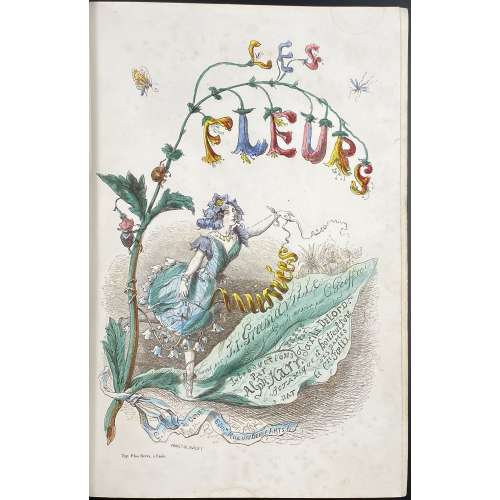 Description: Two parts in one volume, collated 4to, 26.3 x 18 cm, bound in quarter green pebbled morocco over green percaline panelled boards, spine with raised bands, gilt in compartments, lettered in gilt, signed in the bottom “L. Curmer”; marbled endpapers, all edges gilt. Part 1 is illustrated with a hand-coloured wood-engraved title-page by Porret and Blanadet and 28 hand-coloured steel engravings by Charles Geoffroy after J.-J. Grandville; part 2 is illustrated with a hand-coloured wood-engraved title-page by Quichon and 22 steel engravings by Charles Geoffroy after J.-J. Grandville, and two uncoloured botanical plates, unsigned. Title-page: LES | FLEURS ANIMÉES | PAR | J.-J. GRANDVILLE | INTRODUCTIONS | Par ALPH. KARR | TEXTE | Par TAXILE DELORD | — | PREMIÈRE (DEUXIÈME) PARTIE | — | PARIS | GABRIEL DE GONET, ÉDITEUR | 6, RUE DES BEAUX-ARTS, 6 || Collation: part 1: blank, [1] h.t./imprint (PARIS WALDER), hand-coloured engraved t.p., [1] t.p./blank, 1-324, [1] contents/blank, 28 hand-coloured plates; part 2: [1] h.t./imprint (PARIS WALDER), hand-coloured engraved t.p., [1] t.p./blank, [2] intro., [1]-294, 302, blank, 22 hand-coloured plates and 2 uncoloured plates. Pagination: part 1: [1-5] 6-260 [2] (total 262 pages), ils; part 2: [4] [i] ii-iv [1] 2-102, [2] [i] ii-iv, [105] 106-234 [2] (total 248 pages), ils. Coloured steel-engraved plates: Part 1: Bleuet et Coquelicot. Lis. Pensée. Tabac. Tulipe. Rose. Narcisse. Violette. Nenuphar. Laurier. Myrte. Marguerite. Camelia. Immortelle. Chèvre-feuille. Belle-de-nuit. Oeillet. Ciguë. Soleil. Fleur de grenadier. Lin. Eglantine. Pavot. Chardon. Fleur d'oranger. Capucine. Guimauve. Primevère – Perce-neige. Part 2: Pois de senteur. Cactus. Dahlia. Sensitive. Fleur de pêcher. Aubépine. Vigne. Myosotis. Jasmin. Scabieuse & Souci. Traite des fleurs. Flèche-d'eau. Hortensia, couronne impériale. Verveine. Giroflée. Thé et Café. Lilas. Tubéreuse Jonquille. Bal. Retour des fleurs. Erratum. Pervenche desséchée. Plates signed "Grandville del. – Ch. Geoffroy sc. – G. de Gonet, editeur" but some signed "Imp. Delamain et Sarazin rue Git le Cœur 8 Paris." Plates accompanied by tissue guards. Gordon N. Ray: "Most of the plates show an elegant lady in a garden, her dress covered with an extraordinary pattern of flowers. She is sometimes accompanied by respectful creatures, animals and insects, even fish and reptiles". Edition: 2nd edition of 1847, each part has separate pagination; imprint: "Paris. — Typographie Walder, rue Bonaparte, 44". Second "tirage", the volumes being paged separately; the first "tirage", issued also in 1847, is paged continuously. Point of issue: Table des Matières has "Imprimerte Walder." Originally appeared in 83 separate parts in pictorial yellow wrappers. Contributors: J.-J. Grandville [Gèrard, Isidore-Adolphe] (French, 1803 – 1847) – artist. Taxile Delord (French, 1815 – 1877) – author. Comte Foelix [Louis-François Raban] (French, 1795 – 1870) – author. Jean-Baptiste Alphonse Karr (French, 1808 – 1890) – author. Charles Michel Geoffroy (French, 1819 – 1882) – engraver (on steel). Gabriel de Gonet (French, fl. 1847 – 1862) – publisher. Typographie Walder (Paris) – printer. Plon Freres (Paris) – printer. Delamain et Sarrazin (Paris) – printer. Henri Désiré Porret (French, 1800 – 1867) – engraver (on wood). Jules Blanadet (French, 1824 – ?) – engraver (on wood). Quichon (French, fl. c. 1850s) – engraver (on wood). Catalogue raisonné: L. Carteret (Le trésor): p. 286; Ray (French): 198, pp. 278-9; Vicaire (Manuel): D III, p. 133-4; Brivois (Guide): pp. 147-150. In collections: MET 1970.565.423.1–.2; Vanderbilt University; V&A L.755-1943. Provenance: Léon Curmer (French, ).
Description: Two parts in one volume, collated 4to, 26.3 x 18 cm, bound in quarter green pebbled morocco over green percaline panelled boards, spine with raised bands, gilt in compartments, lettered in gilt, signed in the bottom “L. Curmer”; marbled endpapers, all edges gilt. Part 1 is illustrated with a hand-coloured wood-engraved title-page by Porret and Blanadet and 28 hand-coloured steel engravings by Charles Geoffroy after J.-J. Grandville; part 2 is illustrated with a hand-coloured wood-engraved title-page by Quichon and 22 steel engravings by Charles Geoffroy after J.-J. Grandville, and two uncoloured botanical plates, unsigned. Title-page: LES | FLEURS ANIMÉES | PAR | J.-J. GRANDVILLE | INTRODUCTIONS | Par ALPH. KARR | TEXTE | Par TAXILE DELORD | — | PREMIÈRE (DEUXIÈME) PARTIE | — | PARIS | GABRIEL DE GONET, ÉDITEUR | 6, RUE DES BEAUX-ARTS, 6 || Collation: part 1: blank, [1] h.t./imprint (PARIS WALDER), hand-coloured engraved t.p., [1] t.p./blank, 1-324, [1] contents/blank, 28 hand-coloured plates; part 2: [1] h.t./imprint (PARIS WALDER), hand-coloured engraved t.p., [1] t.p./blank, [2] intro., [1]-294, 302, blank, 22 hand-coloured plates and 2 uncoloured plates. Pagination: part 1: [1-5] 6-260 [2] (total 262 pages), ils; part 2: [4] [i] ii-iv [1] 2-102, [2] [i] ii-iv, [105] 106-234 [2] (total 248 pages), ils. Coloured steel-engraved plates: Part 1: Bleuet et Coquelicot. Lis. Pensée. Tabac. Tulipe. Rose. Narcisse. Violette. Nenuphar. Laurier. Myrte. Marguerite. Camelia. Immortelle. Chèvre-feuille. Belle-de-nuit. Oeillet. Ciguë. Soleil. Fleur de grenadier. Lin. Eglantine. Pavot. Chardon. Fleur d'oranger. Capucine. Guimauve. Primevère – Perce-neige. Part 2: Pois de senteur. Cactus. Dahlia. Sensitive. Fleur de pêcher. Aubépine. Vigne. Myosotis. Jasmin. Scabieuse & Souci. Traite des fleurs. Flèche-d'eau. Hortensia, couronne impériale. Verveine. Giroflée. Thé et Café. Lilas. Tubéreuse Jonquille. Bal. Retour des fleurs. Erratum. Pervenche desséchée. Plates signed "Grandville del. – Ch. Geoffroy sc. – G. de Gonet, editeur" but some signed "Imp. Delamain et Sarazin rue Git le Cœur 8 Paris." Plates accompanied by tissue guards. Gordon N. Ray: "Most of the plates show an elegant lady in a garden, her dress covered with an extraordinary pattern of flowers. She is sometimes accompanied by respectful creatures, animals and insects, even fish and reptiles". Edition: 2nd edition of 1847, each part has separate pagination; imprint: "Paris. — Typographie Walder, rue Bonaparte, 44". Second "tirage", the volumes being paged separately; the first "tirage", issued also in 1847, is paged continuously. Point of issue: Table des Matières has "Imprimerte Walder." Originally appeared in 83 separate parts in pictorial yellow wrappers. Contributors: J.-J. Grandville [Gèrard, Isidore-Adolphe] (French, 1803 – 1847) – artist. Taxile Delord (French, 1815 – 1877) – author. Comte Foelix [Louis-François Raban] (French, 1795 – 1870) – author. Jean-Baptiste Alphonse Karr (French, 1808 – 1890) – author. Charles Michel Geoffroy (French, 1819 – 1882) – engraver (on steel). Gabriel de Gonet (French, fl. 1847 – 1862) – publisher. Typographie Walder (Paris) – printer. Plon Freres (Paris) – printer. Delamain et Sarrazin (Paris) – printer. Henri Désiré Porret (French, 1800 – 1867) – engraver (on wood). Jules Blanadet (French, 1824 – ?) – engraver (on wood). Quichon (French, fl. c. 1850s) – engraver (on wood). Catalogue raisonné: L. Carteret (Le trésor): p. 286; Ray (French): 198, pp. 278-9; Vicaire (Manuel): D III, p. 133-4; Brivois (Guide): pp. 147-150. In collections: MET 1970.565.423.1–.2; Vanderbilt University; V&A L.755-1943. Provenance: Léon Curmer (French, ). -
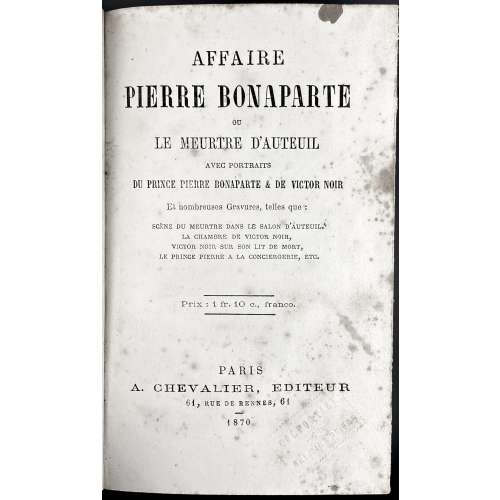 Description: 12mo, 17 x 11 cm, quarter brown morocco over marbled boards, marbled end-papers, raised bands and gilt lettering to spine, embossed stamp to t.p. “COLPORTAGE CHEMIN DE FER”. Title-page: AFFAIRE | PIERRE BONAPARTE | OU | LE MEURTRE D'AUTEUIL | AVEC PORTRAITS | DU PRINCE PIERRE BONAPARTE & DE VICTOR NOIR | Et nombreuses Gravures, telles que : | SCÈNE DU MEURTRE DANS LE SALON D'AUTEUIL. | LA CHAMBRE DE VICTOR NOIR, | VICTOR NOIR SUR SON LIT DE MORT, | LE PRINCE PIERRE A LA CONCIERGERIE, ETC. | — | Prix : 1 fr. 10 c., franco. | — | PARIS | A. CHEVALIER, EDITEUR | 61, RUE DE RENNES, 61 | 1870. Collation: 18mo; odd [1]-918; 5 x 18 = 90 leaves total. Pagination: [2] [3] 4-177 [178]; total 180 pages. Contributors: Armand Le Chevalier (French, 1802 – 1873) – publisher. Prince Pierre-Napoléon Bonaparte (French, 1815 – 1881) – character. Victor Noir [b. Yvan Salmon] (French-Jewish, 1848 – 1870) – character.
Description: 12mo, 17 x 11 cm, quarter brown morocco over marbled boards, marbled end-papers, raised bands and gilt lettering to spine, embossed stamp to t.p. “COLPORTAGE CHEMIN DE FER”. Title-page: AFFAIRE | PIERRE BONAPARTE | OU | LE MEURTRE D'AUTEUIL | AVEC PORTRAITS | DU PRINCE PIERRE BONAPARTE & DE VICTOR NOIR | Et nombreuses Gravures, telles que : | SCÈNE DU MEURTRE DANS LE SALON D'AUTEUIL. | LA CHAMBRE DE VICTOR NOIR, | VICTOR NOIR SUR SON LIT DE MORT, | LE PRINCE PIERRE A LA CONCIERGERIE, ETC. | — | Prix : 1 fr. 10 c., franco. | — | PARIS | A. CHEVALIER, EDITEUR | 61, RUE DE RENNES, 61 | 1870. Collation: 18mo; odd [1]-918; 5 x 18 = 90 leaves total. Pagination: [2] [3] 4-177 [178]; total 180 pages. Contributors: Armand Le Chevalier (French, 1802 – 1873) – publisher. Prince Pierre-Napoléon Bonaparte (French, 1815 – 1881) – character. Victor Noir [b. Yvan Salmon] (French-Jewish, 1848 – 1870) – character. -
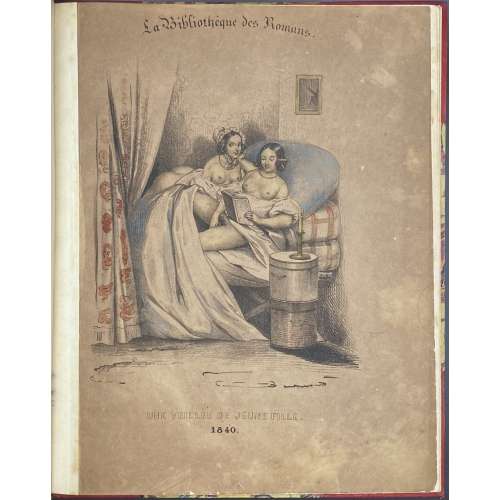 Description: Pictorial album 29.7 x 24 cm, bound in ¾ red morocco over marbled boards with gilt lettering “LA BIBLIOTHÈQUE DES ROMANS” and raised bands to spine; marbled endpapers, two flyleaves, tan original wrapper lettered “La Bibliothèque des Romans. (gothic, arch) | {colour vignette} | UNE VEILLÉE DE JEUNE FILLE. | 1840. || Six hand-coloured lithographs, each in a double-rule border with the series title above it and image title below. Sequential numbers are hand-inscribed within the border in the upper-right corner. Frame 23.5 x 18.3 cm, image 21.5 x 16.5 cm. Three flyleaves at the end. A bookplate to front pastedown: “GERARD NORDMANN EX-LIBRIS”. Content:
Description: Pictorial album 29.7 x 24 cm, bound in ¾ red morocco over marbled boards with gilt lettering “LA BIBLIOTHÈQUE DES ROMANS” and raised bands to spine; marbled endpapers, two flyleaves, tan original wrapper lettered “La Bibliothèque des Romans. (gothic, arch) | {colour vignette} | UNE VEILLÉE DE JEUNE FILLE. | 1840. || Six hand-coloured lithographs, each in a double-rule border with the series title above it and image title below. Sequential numbers are hand-inscribed within the border in the upper-right corner. Frame 23.5 x 18.3 cm, image 21.5 x 16.5 cm. Three flyleaves at the end. A bookplate to front pastedown: “GERARD NORDMANN EX-LIBRIS”. Content:- Front wrapper (title-page)
- SŒUR ANNE (Sister Anne)
- LA GRISETTE (The grisette)
- LÉONIDE OU LA VIEILLE DE SURÊNE (Léonide or the old lady of Surêne)
- LA PUCELLE DE BELLEVILLE (The maid of Belleville)
- MON VOISIN RAYMOND (My neighbor Raymond)
- LE COCU (The cuckold)
-
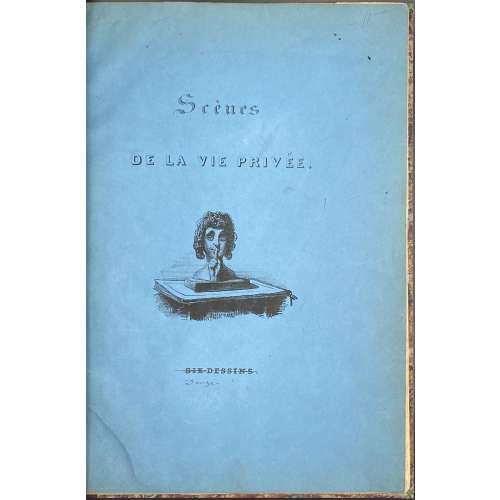 Pictorial album 31 x 22.8 cm, bound in quarter red calf over marbled boards with gilt lettering “SCÈNES | DE | LA VIE | PRIVÉE” and gilt ornament to spine; marbled endpapers, flyleaf, blue original wrapper (title-page) lettered SCÈNES | DE LA VIE PRIVÉE. | {vignette} | SIX DESSINS || «Six dessins» struck out, ms inscription beneath “Douze”. Twelve hand-coloured lithographs, some inscribed with letters and/or numbers in reverse, each in a double-rule frame 22 x 16.5 cm, images 18 x 14.5 cm (approx.); series title “Scènes de la vie intime” printed above the frame, image title printed in the lower compartment; ms numbers above the upper-right corner of the frame (state before sequential numbers, ms numbers do not correspond with artist numbering). Flyleaf at the end. Two bookplates to front pastedown: “EX-LIBRIS PAUL GAVAULT” and armorial “IN ROBORE ROBUR | Ex Libris Bourlon de Rouvre”. Content (Roman numerals in parenthesis are publisher's numbers; numerals in italic are Armelhault-Bocher reference numbers):
Pictorial album 31 x 22.8 cm, bound in quarter red calf over marbled boards with gilt lettering “SCÈNES | DE | LA VIE | PRIVÉE” and gilt ornament to spine; marbled endpapers, flyleaf, blue original wrapper (title-page) lettered SCÈNES | DE LA VIE PRIVÉE. | {vignette} | SIX DESSINS || «Six dessins» struck out, ms inscription beneath “Douze”. Twelve hand-coloured lithographs, some inscribed with letters and/or numbers in reverse, each in a double-rule frame 22 x 16.5 cm, images 18 x 14.5 cm (approx.); series title “Scènes de la vie intime” printed above the frame, image title printed in the lower compartment; ms numbers above the upper-right corner of the frame (state before sequential numbers, ms numbers do not correspond with artist numbering). Flyleaf at the end. Two bookplates to front pastedown: “EX-LIBRIS PAUL GAVAULT” and armorial “IN ROBORE ROBUR | Ex Libris Bourlon de Rouvre”. Content (Roman numerals in parenthesis are publisher's numbers; numerals in italic are Armelhault-Bocher reference numbers):- Titre de la couverture (Title-page) – 2001
- (III) Un nid dans les blés (A nest in the wheat) – 2004
- (II) Amitié de pension (Friendship in the pension) – 2003
- (XI) Bras dessus, bras dessous (Arm up, arm down) – 2012
- (I) Causerie (Chat) – 2002
- (VI) Prélude (Prelude) – 2007
- (IX) Le guet-apens (Ambush) – 2010
- (V) Le cabinet noir (The dark chamber) – 2006
- (IV) Distraction (Entertainment) – 2005
- (X) Leçon de paysage (Landscape lesson) – 2011
- (VII) Avant le péché (Before sin) – 2008
- (VIII) Après le péché (After sin) – 2009
- (XII) La femme du peintre (The painter's wife) – 2013
-
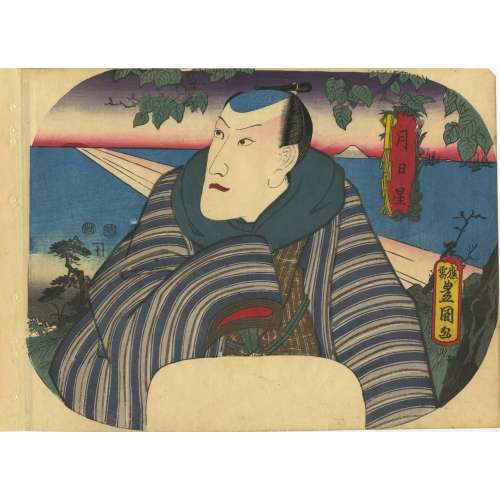 Artist: Utagawa Kunisada [歌川 国貞] a.k.a. Utagawa Toyokuni III [三代歌川豊国] (Japanese, 1786 – 1865). Signed: Ōju Toyokuni ga [応需豊国画], in a toshidama cartouche. Double nanushi censor seals Mera & Murata (1846-50). Publisher: Kojimaya Jūbei [小嶋屋重兵衛] (Japanese, fl. c. 1797 – 1869). Kabuki actor Ichikawa Danjūrō VIII [市川団十郎] (Ichikawa Ebizō VI, Ichikawa Shinnosuke II, Japanese, 1823 – 1854) watches the sunrise over Mount Fuji. The complete set of series Moon, Sun, Stars [月日星] (tsuki-hi-hoshi/boshi), three sources of light (sankō) [三光]:
Artist: Utagawa Kunisada [歌川 国貞] a.k.a. Utagawa Toyokuni III [三代歌川豊国] (Japanese, 1786 – 1865). Signed: Ōju Toyokuni ga [応需豊国画], in a toshidama cartouche. Double nanushi censor seals Mera & Murata (1846-50). Publisher: Kojimaya Jūbei [小嶋屋重兵衛] (Japanese, fl. c. 1797 – 1869). Kabuki actor Ichikawa Danjūrō VIII [市川団十郎] (Ichikawa Ebizō VI, Ichikawa Shinnosuke II, Japanese, 1823 – 1854) watches the sunrise over Mount Fuji. The complete set of series Moon, Sun, Stars [月日星] (tsuki-hi-hoshi/boshi), three sources of light (sankō) [三光]: -
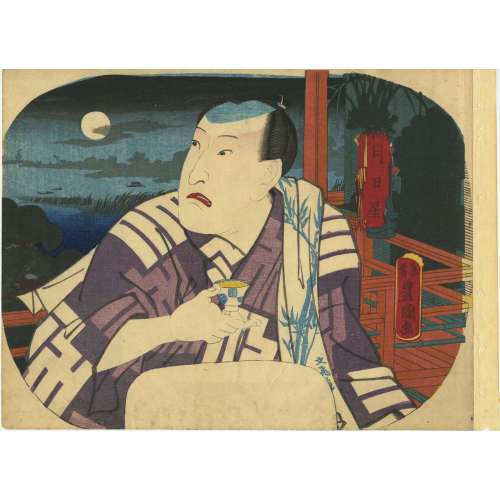 Artist: Utagawa Kunisada [歌川 国貞] a.k.a. Utagawa Toyokuni III [三代歌川豊国] (Japanese, 1786 – 1865). Signed: Ōju Toyokuni ga [応需豊国画] in a toshidama cartouche. Double nanushi censor seals Mera & Murata (1846-50). Publisher: Kojimaya Jūbei [小嶋屋重兵衛] (Japanese, fl. c. 1797 – 1869). A gentleman, probably a kabuki actor Nakamura Utaemon IV [中村歌右衛門] (Nakamura Shikan II, Nakamura Tsurusuke I, Nakamura Tōtarō, Japanese, 1796 – 1852) drinking tea on a veranda under the shining moon. Series Moon, Sun, Stars [月日星] (tsuki-hi-hoshi/boshi), the three sources of light (sankō) [三光]:
Artist: Utagawa Kunisada [歌川 国貞] a.k.a. Utagawa Toyokuni III [三代歌川豊国] (Japanese, 1786 – 1865). Signed: Ōju Toyokuni ga [応需豊国画] in a toshidama cartouche. Double nanushi censor seals Mera & Murata (1846-50). Publisher: Kojimaya Jūbei [小嶋屋重兵衛] (Japanese, fl. c. 1797 – 1869). A gentleman, probably a kabuki actor Nakamura Utaemon IV [中村歌右衛門] (Nakamura Shikan II, Nakamura Tsurusuke I, Nakamura Tōtarō, Japanese, 1796 – 1852) drinking tea on a veranda under the shining moon. Series Moon, Sun, Stars [月日星] (tsuki-hi-hoshi/boshi), the three sources of light (sankō) [三光]: -
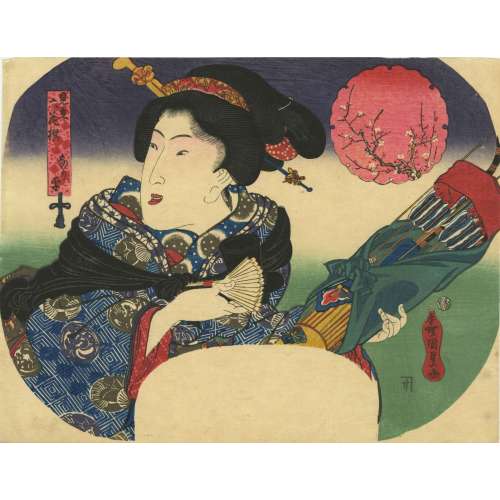 Artist: Utagawa Kunisada [歌川 国貞] a.k.a. Utagawa Toyokuni III [三代歌川豊国] (Japanese, 1786 – 1865). Signed: Kōchō(rō) Kunisada ga (香蝶国貞画) in a red double-gourd cartouche. Publisher: Surugaya Sakujirō [駿河屋作次郎] (Japanese, fl. c. 1844 – 1865); Marks 06-005 | 501a. Single nanushi censor seal: Muramatsu (1843-6). The date is attributed to c. 1844. Title: Narihira [なり平]. Ariwara no Narihira [在原 業平] (Japanese, 825 – 880) – one of the Six Immortal Poets – The Rokkasen [六歌仙]. Series: A parody of six immortal poets [見立六花撰] (Mitate Rokkasen). Media: Untrimmed fan print (uchiwa-e), 227 x 293 mm, depicting a beautiful woman with a bow and arrows in her left hand. Series: Mitate Rokkasen [見立六花撰] – is sometimes interpreted as "A parody of six immortal poets" or "A comparison of six select flowers". [LIB-1212.2017] Robert Schaap. Kunisada: Imaging, drama and beauty. — Leiden: Hotei Publishing, 2016; pl. 28, p. 58. This is another fan print with another immortal poet, Bun'ya no Yasuhide [文屋 康秀] (Japanese, -d. 885?), from the same series, provided in the book:With special thanks to Horst Graebner for help with the description and date attribution: "The print can be dated to 1844: censor seal is Muramatsu (Muramatsu Genroku); he acted in 7/1844 and 4/1845 (and also later) as censor but Kunisada changed his name to Kunisada early in 1844."
Artist: Utagawa Kunisada [歌川 国貞] a.k.a. Utagawa Toyokuni III [三代歌川豊国] (Japanese, 1786 – 1865). Signed: Kōchō(rō) Kunisada ga (香蝶国貞画) in a red double-gourd cartouche. Publisher: Surugaya Sakujirō [駿河屋作次郎] (Japanese, fl. c. 1844 – 1865); Marks 06-005 | 501a. Single nanushi censor seal: Muramatsu (1843-6). The date is attributed to c. 1844. Title: Narihira [なり平]. Ariwara no Narihira [在原 業平] (Japanese, 825 – 880) – one of the Six Immortal Poets – The Rokkasen [六歌仙]. Series: A parody of six immortal poets [見立六花撰] (Mitate Rokkasen). Media: Untrimmed fan print (uchiwa-e), 227 x 293 mm, depicting a beautiful woman with a bow and arrows in her left hand. Series: Mitate Rokkasen [見立六花撰] – is sometimes interpreted as "A parody of six immortal poets" or "A comparison of six select flowers". [LIB-1212.2017] Robert Schaap. Kunisada: Imaging, drama and beauty. — Leiden: Hotei Publishing, 2016; pl. 28, p. 58. This is another fan print with another immortal poet, Bun'ya no Yasuhide [文屋 康秀] (Japanese, -d. 885?), from the same series, provided in the book:With special thanks to Horst Graebner for help with the description and date attribution: "The print can be dated to 1844: censor seal is Muramatsu (Muramatsu Genroku); he acted in 7/1844 and 4/1845 (and also later) as censor but Kunisada changed his name to Kunisada early in 1844."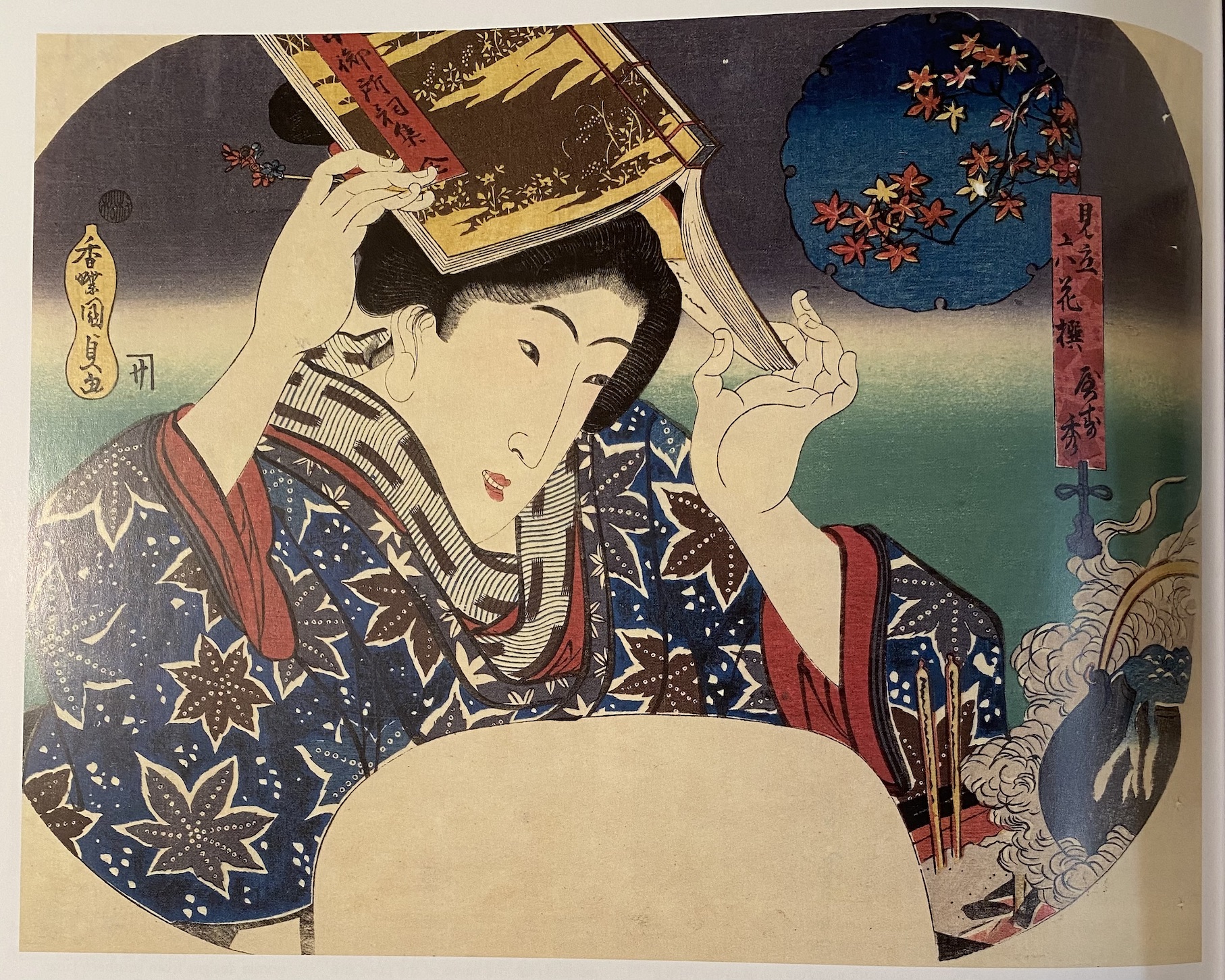
Robert Schaap, 2016.
-
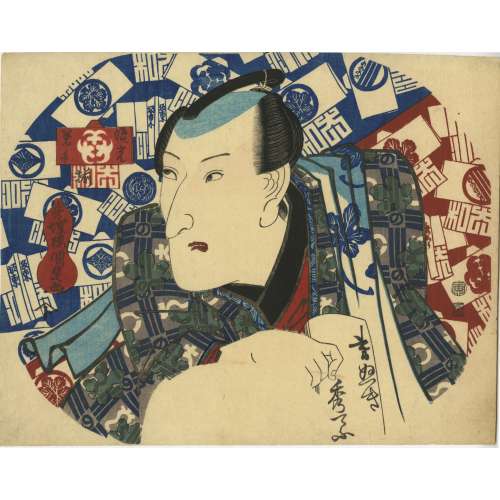 Artist: Utagawa Kunisada [歌川 国貞] a.k.a. Utagawa Toyokuni III [三代歌川豊国] (Japanese, 1786 – 1865). Signed: Kochoro Kuisada ga [香蝶楼国貞画] in a red double-gourd cartouche Publisher: Enshūya Matabei [遠州屋又兵衛] (Japanese, fl. c. 1768 – 1881). Series: Fashionable Youths [流行若手揃] (Ryuko Wakate Zoroi). Actor: Bandō Minosuke II [坂東蓑助] (Japanese, 1802 – 1863); other names: Morita Kan'ya XI, Bandô Mitsugorō IV. Date-kiwame seals: Bunsei 13 / Tenpō 1 (1830). One more print from the same series (See Waseda 201-2125); not in this collection: Segawa Kikunojō V [瀬川菊之丞] (Japanese, 1802 – 1832); other names: Segawa Tamon I.
Artist: Utagawa Kunisada [歌川 国貞] a.k.a. Utagawa Toyokuni III [三代歌川豊国] (Japanese, 1786 – 1865). Signed: Kochoro Kuisada ga [香蝶楼国貞画] in a red double-gourd cartouche Publisher: Enshūya Matabei [遠州屋又兵衛] (Japanese, fl. c. 1768 – 1881). Series: Fashionable Youths [流行若手揃] (Ryuko Wakate Zoroi). Actor: Bandō Minosuke II [坂東蓑助] (Japanese, 1802 – 1863); other names: Morita Kan'ya XI, Bandô Mitsugorō IV. Date-kiwame seals: Bunsei 13 / Tenpō 1 (1830). One more print from the same series (See Waseda 201-2125); not in this collection: Segawa Kikunojō V [瀬川菊之丞] (Japanese, 1802 – 1832); other names: Segawa Tamon I.